Also in this issue...
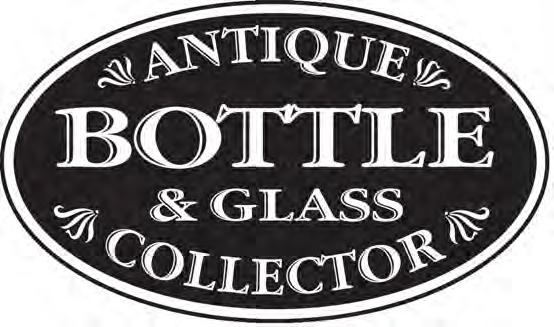
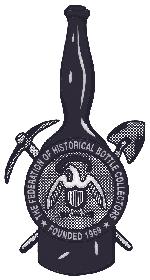
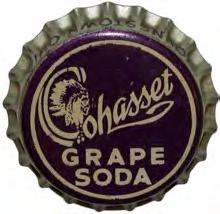
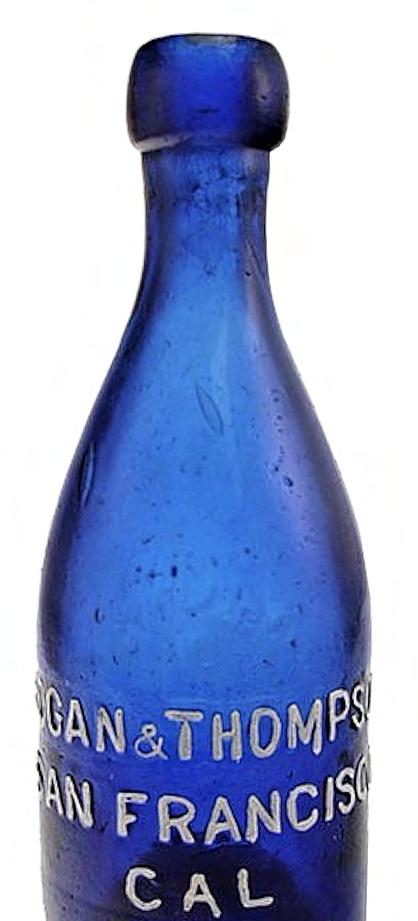

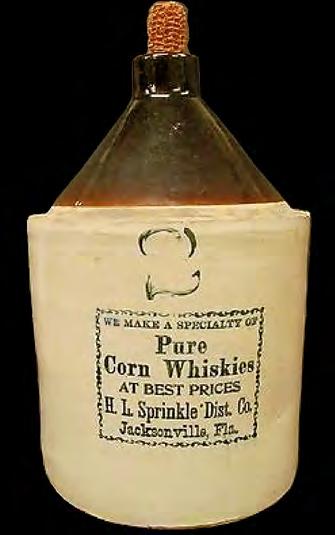

Vol. 33 No. 1 Also... The Sprinkles of Whiskey: Distilling Their Story $7.00 March - April 2023 Featuring... Henry Hogan –B.C.’s First Soda King
Vol. 34 No. 2
Native Americans ACL Corner #3 You Like Fluters...or Crimpers? Knights Product Jar Peter, Art & Mary, Huff the Magic Bottle and so much more!
The official publication of the Federation of Historical Bottle Collectors
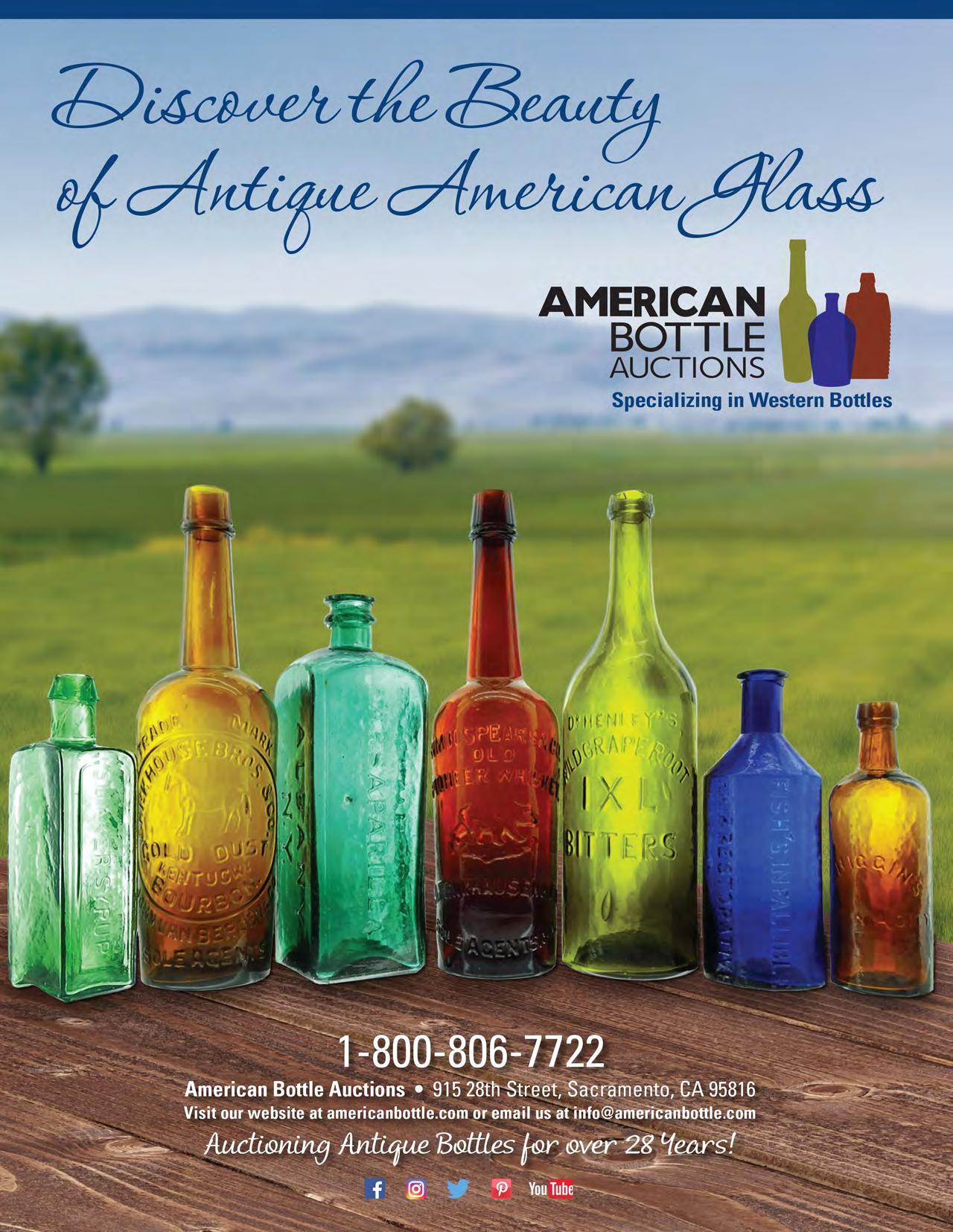
March–April 2023
TABLE OF CONTENTS
On the Cover: Components from The Sprinkles of Whiskey and the Henry Hogan articles.
So you don’t miss an issue of Antique Bottle & Glass Collector, please check your labels for expiration information.

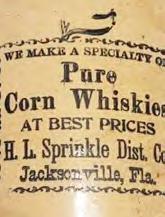

To Advertise, Subscribe or Renew a subscription, see pages 66 and 72 for details.
To Submit a Story, send a Letter to the Editor or have Comments and Concerns, contact:
Elizabeth Meyer
FOHBC Business Manager
P.O. Box 1825 Brookshire, Texas 77423
phone: 713.504.0628
email: fohbcmembers@gmail.com

Fair use notice: Some material in Antique Bottle & Glass Collector has been submitted for publication in this magazine and/or was originally published by the authors and is copyrighted. We, as a non-profit organization, offer it here as an educational tool to increase further understanding and discussion of bottle collecting and related history. We believe this constitutes “fair use” of the copyrighted material as provided for in Section 107 of the U.S. Copyright Law. If you wish to use this material for purposes of your own that go beyond “fair use,” you must obtain permission from the copyright owner(s).
Antique Bottle & Glass Collector © (ISSN 10505598) is published bi-monthly (6 issues per year) by the Federation of Historical Bottle Collectors, Inc. (a non-profit 501(c)(3) educational organization) at 101 Crawford Street, Studio 1A, Houston, Texas 77002; phone: 713.504.0628; Website: FOHBC.org, Non-profit periodicals postage paid at Raymore, Missouri 64083 and additional mailing office, Pub. #005062.
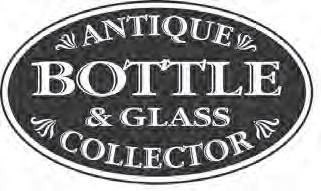
Postmaster: Send address changes to Elizabeth Meyer, FOHBC Business Manager, P.O. Box 1825, Brookshire, Texas 77423; 713.504.0628, email: fohbcmembers@ gmail.com
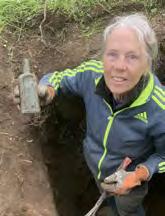
Annual subscription rate is: $40 for standard mail or $55 for First Class, $60 to Canada, $80 Other countries, $25 Digital Membership [in U.S. funds.] Life Membership: Level 1: $1,000, Level 2: $500. The Federation of Historical Bottle Collectors, Inc. (FOHBC) assumes no responsibility for products and services advertised in this publication. See page 72 for details.
The names Federation of Historical Bottle Collectors Inc. (FOHBC), and Antique Bottle & Glass Collector ©, are registered ® names of the Federation of Historical Bottle Collectors Inc., and no use of either other than as references, is permitted without expressed written consent from the Federation of Historical Bottle Collectors Inc. Certain material contained in this publication is copyrighted by, and remains the sole property of, the Federation of Historical Bottle Collectors Inc. while others remain property of the submitting authors. Detailed information concerning a particular article may be obtained from the Editor.

March – April 2023 1 FOHBC Officers | 2022–2024 ...................................................................................... 2 FOHBC President’s Message 3 Shards of Wisdom–Heard it Through the Grapevine 4 FOHBC News–From & For Our Members ..................................................................... 6 FOHBC Regional News ...................................................................................................... 9 Virtual Museum News by Richard Siri 10 You Like Fluters...or Crimpers? by Ralph Finch 12 Lafayette in the News by Ferdinand Meyer V ................................................................ 16 ACL Corner #3 Native Americans by Mike Dickman 22 The Sprinkles of Whiskey: Distilling their Story by Jack Sullivan 26 Peter, Art & Mary—Huff the Magic Bottle by Peter Jablonski 35 Knights Product Jar by Barry Bernas .............................................................................. 46 Henry Hogan – B.C.’s First Soda King by Bill Wilson 49 Lost & Found 60 Member Photos 64 Classified Ads .............................................................................................................. 66 FOHBC Sho-Biz–Calendar of Shows 68 History’s Corner 70 Membership Benefits, Display Ad Rates, Donations to the FOHBC 71 Membership Application, Classified Advertising & Article Submission ............................. 72
Printed by Modern Litho, Jefferson City, Missouri 65101.
No. 266
Vol. 34 No. 2
Coming next issue or down the road: Traveling the Capers Trail • Carmichael & Son Co. - Glass Bottom Boats • ACL Lady Bottles • Sperm Gun Oil Bottle made by the Arctic Oil Works of S.F. • What do You Collect? • Reed & Carnrick New York Pharmacal Association • Pike’s Peak or Bust • A Clinton Physician Dr. Carl Gruber • Dr. Guysott’s Extract of Yellow Dock and Sarsaparilla Update • Early Pittsburgh Glasshouses • Soda City’s Only Two Earliest Colored Sodas: H. Deming & Co. and C. C. Habenicht • Catawba Wine Bitters • History of the Baraboo Pottery Baraboo, Wisconsin • On the Witness Protection Program • Probst & Hilbs German Bitters Little Rock, Ark. • Bottle Tumbling with a “Twist” • William Stiegel’s American Flint Glass Manufactory • Registered Bottles • Jarring Discoveries and so much more! 22 26 35 12 49
FOHBC Board of Directors
Midwest Region Director: Henry Hecker, W298 S10655 Phantom Woods Road, Mukwonago, Wisconsin 53149, phone: 262.844.5751, email: phantomhah@gmail.com
Southern Region Director: Richard Kramerich, P.O. Box 241, Pensacola, Florida 32591, phone: 850.435.5425, email: southernshards@gmail.com

Western Region Director: Eric McGuire, 1732 Inverness Drive, Petaluma, California 94954, phone: 707.481.9145, email: etmcguire@comcast.net
Public Relations Director: Richard Kramerich, P.O. Box 241, Pensacola, Florida 32591, phone: 850.435.5425, email: southernshards@gmail.com
The Federation of Historical Bottle Collectors is a non-profit organization for collectors of historical bottles, glass and related collectible items. Our primary goal is educational as it relates to the history and manufacture of historical bottles and related artifacts.

FOHBC Officers 2022–2024
President: Michael Seeliger, N8211 Smith Road, Brooklyn, Wisconsin 53521, phone: 608.575.2922, email: mwseeliger@gmail.com

First Vice-President: Position Open
Second Vice-President: Position Open
Secretary: Alice Seeliger, N8211 Smith Road, Brooklyn, Wisconsin 53521, phone: 608.575.1128, email: aliceajscreative@gmail.com
Treasurer: Kathie Craig, 1037 Hazelwood Avenue, Campbell, California 95008, 408.591.6511, email: kathiecraig@sbcglobal.net
Business Manager: Elizabeth Meyer, FOHBC, P.O. Box 1825, Brookshire, Texas 77423, phone: 713.504.0628, email: fohbcmembers@gmail.com
Director-at-Large: Ferdinand Meyer V, FMG Design, Inc., 101 Crawford Street, Studio 1A, Houston, Texas 77002 phone: 713.222.7979 x115, email: fmeyer@fmgdesign.com
Director-at-Large: John O’Neill, 1805 Ralston Avenue, Belmont, California 94002, phone: 650.619.8209, email: Joneill@risk-strategies.com
Director-at-Large: Richard Siri, PO Box 3818, Santa Rosa, California 95402, phone: 707.542.6438, email: rtsiri@sbcglobal.net
Northeast Region Director: Charlie Martin Jr., 24 Follinsbee Lane, West Newbury, Massachusetts 01985, phone: 781.248.8620, email: cemartinjr@comcast.net
Conventions Director: Position Open
Historian: Craig Cassetta, 12 Marlin Court, Chico, California 95973, phone: 530.680.5226, email: craig.cassetta@gmail.com
Membership Director: Elizabeth Meyer, FOHBC, P.O. Box 1825, Brookshire, Texas 77423, phone: 713.504.0628, email: fohbcmembers@gmail.com
Merchandising Director: Position Open
FOHBC Virtual Museum
Alan DeMaison, 1605 Clipper Cove, Painesville, Ohio 44077, phone: 440.358.1223, email: a.demaison@sbcglobal.net
Ferdinand Meyer V, FMG Design, Inc., 101 Crawford Street, Studio 1A, Houston, Texas 77002, phone: 713.222.7979 x115, email: fmeyer@fmgdesign.com
Miguel Ruiz, FMG Design, Inc., 101 Crawford Street, Studio 1A, Houston, Texas 77002, phone: 713.222.7979, email: mruiz@fmgdesign.com
Richard Siri, PO Box 3818, Santa Rosa, California 95402, phone: 707.542.6438, email: rtsiri@sbcglobal.net
Antique Bottle & Glass Collector
Magazine Editor: Ferdinand Meyer V, Peachridge Collections, LLC. P.O. Box 1825, Brookshire, Texas 77423, phone: 713.222.7979 x115, email: fmeyer@fmgdesign.com
Design and Layout: Ferdinand Meyer V
Proofreaders: Alice Seeliger and Bill Baab
Antique Bottle & Glass Collector
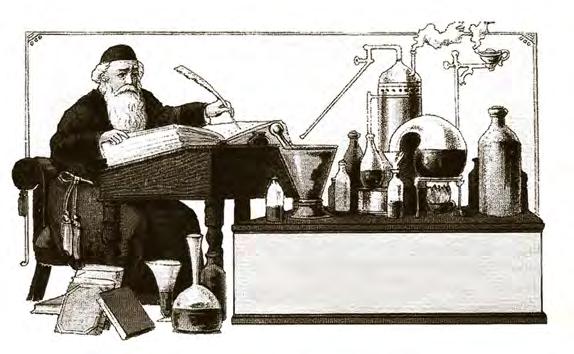
2
Federation of Historical Bottle Collectors
President’s Message
Michael Seeliger President Federation of Historical Bottle Collectors


N8211 Smith Road, Brooklyn, Wisconsin 53521 608.575.2922
mwseeliger@gmail.com
Well, here we are, off and running for another successful year! Already there have been some great shows that were well attended. It shows that the hobby is continuing to grow even though our membership base is getting older. As some of us retire, we have more time to attend shows, go to antique stores, and search the web for bottles and go-withs. I plan on attending more shows this year because I can.
I was usually around for the Milwaukee show in February since it is local and it’s probably the best-attended show in the country. It has a great breweriana contingency and always has a waiting list of several hundred people eager to get into the show when it opens. Aisles are so crowded you must take turns walking up to a table. Great show that I will, unfortunately, miss this year because we’re escaping the Wisconsin weather! The next show I usually attend is the Tampa/ St. Petersburg show in mid-February which, as I’m writing this in mid-January, I am making plans to attend. It has a great venue, and I can’t beat the free room and board with Bill Mitchell. I plan to get to the Minneapolis show in April. Unfortunately, my scheduled second hip replacement and recovery happen during the Baltimore show, which falls in mid-March. But I’ll be back in shape by the Rochester and Mansfield, Ohio shows, which are in late April and early May. Shupp’s Grove in Adamstown, Pennsylvania (end of May) is looking good, and I’ll possibly dovetail that with the Washington, Pennsylvania show, which is the next day. I couldn’t go to the National Bottle Museum in New York last year, so this year the Ballston Spa show in June is definitely on my radar. This is only covering the first half of the year! Fall provides many great possibilities, too. I’m gearing up to attend 10 to 12 shows this year—ambitious but doable! I’m looking forward to seeing many of you at these shows.
Again, I am really excited about the Federation and where we are going. The Virtual Museum is growing almost daily, the Auction Price Report has brought in many new members, and the Antique Bottle & Glass Collector (AB&GC) magazine continues to provide a growing number of subscribers with a wide range of articles covering everything from digging to displaying bottles and glass in every shape, color and size. We have a host of articles awaiting publication but always welcome additional submittals, so write your stories and send them in!
We have a huge, very ambitious list of things to accomplish this year. We want to expand the membership, collect and document histories of collections and books, and increase video reference material via our website, Facebook site and Instagram. We will be upgrading our website, removing old links, and refreshing others. We have come a long way toward adding past issues of magazines to our reference library, but many more still need to be scanned into the database. Then we need to cross-reference and index issues and articles etc. etc.

This all takes volunteers. I am pleased to see an increase in the number of members expressing interest in assisting with these projects. We are working to capitalize on that enthusiasm by forming committees and getting members working in their areas of interest and expertise.
Historically, we relied on the Board members to do most of the work; now, we are going to focus on committees to get more people involved. More people, more ideas, and more accomplishments resulting in bringing some projects that have been on the back burner into reality. Just look at how much time and effort it took to get the Virtual Museum up and running, and now displaying tens of thousands of images complete with extensive research, descriptions and history. The progress that has been made in just the last year is amazing… from 500 spinners at the beginning of 2022 to 700 plus images as the year came to a close. Have you gone to other static museum websites and viewed their collections? Few have the quality of pictures we have, and none have the in-depth stories behind each exhibit. The FOHBC Virtual Museum is really leaps and bounds ahead of any other museum. It’s something to be proud of, for sure!
So, let us know where you’d like to put your interests and expertise to work for your FOHBC. Share your ideas and let us know how you can help.
Post Script. Our luck in avoiding Covid ran out! Both Alice and I came down with it two weeks into our escape from Wisconsin RV trip to Arizona by way of Texas. Being cooped up in an RV in Texas is better than being cooped up in Wisconsin this time of year but it’s been a very unpleasant experience.
Fortunately. I received an email from Wayne Harris in Australia which I followed up with a call. Wayne provided an interesting update to some information I had received many years ago but never followed up on. While at a flea market down under, a lady noticed a Warner bottle on his table. She nonchalantly said “I was the last manager of this Warner Safe Cure company.” Wayne jumped at the chance to talk to her and discovered she had extensive paperwork from the firm. It was in business until 1946 when it was forced to close because it could no longer get the herbs needed to formulate the product since most of them came from Japan.

A few years later Wayne acquired the paperwork! Wayne leafed through the paperwork during our phone call and we read over the changes in formulation and compounding dictated by the parent company in Rochester. It was like I was in their office. They discussed label and trademark changes due to the Food and Drug Act regulating patent medicines.
Wayne and I will be collaborating on a chapter in my Warners book on the Melbourne branch after we sort out all the information contained in those files. What a discovery!
March – April 2023 3
Shards of Wisdom
“Heard it Through the Grapevine”
Lifetime Passions for Life, Antiques All of it can end with a closing of an eye and a whispering of words like...Rosebud*
By Ralph Finch - Comments? Tell me at rfinch@twmi.rr.com?

A year or two ago, I started an article about fluters—(irons to shape ruffled shirts—which I also collect...see page 12 this issue). This story is because a recent auction offered “the 60-year Americana collection of a woman from Pennsylvania.” I wonder if the woman was alive to attend the passing of her life’s work before her own passing. Within a few weeks, at another auction, was “a 50-plus year illation of a Nebraska collector,” and then, a 60-year collection “of a Lady from Florida.” Again, did this “lady” attend the sale? How many of us who collect for a lifetime live long enough to pass on our “passions” to a new generation of “caretakers”?
By the way, “Rosebud” was the last word spoken in the movie Citizen Kane, perhaps the most-honored U.S. film of all time. At the end of the film, when the secret of the word “Rosebud,” uttered by Charles Foster Kane (Orson Welles) before he died, is finally revealed. At that point, his lifetime of accumulations (that a workman describes as “junk”) are being tossed into a furnace, including his childhood sled named...“Rosebud.” The point of this is that Kane dies an empty life. With luck, readers of this article will not end with an empty life; we have our...old sleds, tons of other items, and—more importantly—friends and families to share them with.
Those of us who collect have a choice (one of mine, my whole life, has been: a new car or an old bottle. And I have never owned a new car). Another choice most of us has is to not die not knowing what happens with our collections, hoping it isn’t sold in a garage sale by “Uncle Harry,” who never liked you and thought your stuff was stupid. Many of us choose to watch our collections pass on and to even have added to the sale by attaching bits and pieces of information so that the new caretakers might appreciate more of what you had.
I was a bit sad when my collection of Old Sachems went, (knowing it was missing an aqua example), or when my Sandwich colognes were packed up and taken away...sniff…(But Norman Heckler produced for us a wonderful poster of the auction; come and see it.)
Perhaps the hardest to say goodbye to was my (almost) lifelong collection of 250 different glass target balls and related ephemera. It hurt, but with two years of work, with wonderful wife Janet and American Glass Gallery’s John Pastor, a catalog was produced that, likely, will last long after I’m gone but will show others what—and why—I had acquired target balls.
In mid-March (2022), the long-popular Ohio house of Garth’s offered (edited) an Americana auction “featuring the 50-plus-years personal collection of AnnaMary and Richard York, Lincoln, Neb.,
along with items from the 60-year collection of a woman from Florida with American decorated and formal furniture” and a ton of stuff. I wonder if any of the collectors witnesses the sale. Do you think it is better—or worse—not to see it all go?
And sold on April 22 (2022), “the sewing collection of Mildred Jarvis, Kennesaw, GA; the 40-year sewing clamp collection of so-and-sos Lyle and Dennis Drier of Oconomowoc, Wisc.; part one of the Dean and Leann Lindsey collection, Phoenix, featuring American and European art glass; and part three of the collection of Larry Spradley of Beaumont, Texas, comprising more than 500 glass, ceramic, and miniature metal lamps of all types; fairy lamps; plus more.” (How many fairy lamps do you have before people consider you are one?) How many years did Larry spend to collect these 500 items, and how many auctions did it take to hammer them down? In a few hours, a lifetime of collection went...dark.
Some Glass News [submitted by Willy Van den Bossche]
Last December 9, the Seven Glass Wonders were presented in the closing ceremony of the International Year of Glass (IYOG2022). This activity, coordinated by Teresa Palomar, researcher from VICARTE (Portugal) and ICV-CSIC (Spain), and the artist Lothar Böttcher, aimed to select the seven objects, buildings and places of the world where the glass was the protagonist or had a fundamental role. With this purpose, each proposal was assessed in function of its originality, innovative character and historical, cultural and industrial character.
Glass professionals from different areas such as arts, architecture, science and industry formed the prestigious international jury. They were Lothar Böttcher and Pfunzo Sidogi (South Africa), Alicia Duran (Spain), Dedo von Kerssenbrock-Krosigk (Germany), Jerzy J. Kunicki-Goldfinger (Poland), John Parker (UK), Maria Grazia Diani (Italy), Peter Malatt (Australia), Kathy Jordan, Susie Silbert and Lauren Fair (EEUU), Amanda Pinto (Brazil), Mª Eugenia Díaz de Vivar (Argentina), Long Zhang and Fang Zheng (China), and Mohammad Al-Asad (Jordan).
After weeks of deliberation, the jury agreed that the Seven Glass Wonders were:
(1) Glass from the Tomb of Tutankhamun, currently at the Egyptian Museum, Cairo and, from 2023 also at the Grand Egyptian Museum, Gizeh (Egypt).
The Middle East is the place of origin for glass making. More than 3,500 years ago, practitioners in modern Turkey, Iraq, Egypt and other places succeeded in producing outstanding colorful glass objects and vessels. Only in Egypt, however, in the tombs of the Pharaohs, did these items survive without any wear. Some look as bright as if they had been made yesterday. This is particularly true for the finds from the tomb of Tutankhamun, which was discov-
4 Antique Bottle & Glass Collector
Shards of Wisdom
“Heard it Through the Grapevine”
ered in 1922, more than 3,300 years after his death. The treasure of glass artifacts from the tomb is exceptionally exquisite, ranging from thousands of elaborate glass inlays, that not only adorn more than 150 pieces of jewelery but also the king’s throne, weapons and even chariots, to full-scale head rests made entirely of glass. The blue stripes on the mummy’s mask also consist of glass—some of them are more than 50 cm long, and demonstrate the superb level of glass technology already at this early stage of its history.
(2) Lycurgus Cup, The British Museum, London.
This cup displays a miraculous colour effect. Under normal lighting, the glass appears jade green, but when lit from behind, it turns ruby red. Scientists have researched that this phenomenon is due to gold and silver nanoparticles in the glass. While ancient Romans certainly had no concept of nanotechnology, they were capable of using its effects in ways that could not be replicated for millennia. As amazing as its colour effects is its relief cutting. The figures of King Lycurgus, the God Dionysos and others have been carved from the thick-walled blank in a three-dimensional way. The cup is one of the few and most luxurious glass vessels of Roman times, the cage-cups, where the glass blank was painstakingly cut and ground to leave the motif, as a “cage,” suspended from the surface. Among these, the Lycurgus cup is the only well-preserved example with figures.
(3) Sainte-Chapelle, Paris, France
Stained-glass windows in Medieval churches collect the outside light and turn it into shapes that glow in the most striking colours inside the church. Windows are often prominent in Gothic cathedrals, but in no other medieval building are the windows as dominant as in the Sainte-Chapelle. It was commissioned by King Louis IX of France as the royal chapel and built in record time from 1242 to its consecration on 26 April 1248. Together with the rose window, 15 stained-glass windows cover a surface area greater than 700 m². 1113 biblical scenes tell the story of the world from its beginning to the arrival of the relics of the Passion of Christ in Paris. While a lot of the glass had to be repaired over time, nearly two-thirds are still the original glass panes dating back nearly 800 years, truly forming walls of light.
(4) The Ware Collection of Blaschka Glass Models of Plants, Harvard University, Cambridge, Massachusetts, USA

The Blaschkas brought the art of flame-working glass to an extreme, and demonstrated that there is nothing in the natural world that could not be perfectly imitated in glass. This exceptional collection, better known as the “Blaschka Glass Flowers,” was commissioned by George Lincoln Goodale, the first director of the Botanical Museum at Harvard. Leopold (1822–1895) and Rudolf Blaschka (1857–1939) were a father and son team of Bohemian glass artists active in Dresden, Germany. Over fifty years, from 1886 to 1936, the Blaschkas produced 4,300 glass models that rep-
resent 780 plant species in their finest detail. The Blaschkas were already renowned for their invertebrate glass models, known to educational institutions and museums around the world, before they commenced on their epic and intricately detailed glass models of plants.
(5) The Corning Museum of Glass, Corning, New York, USA
The largest glass collection in the world, combined with a library that seeks to build a comprehensive collection of books, archival, and rare materials about glass, and a studio where artists teach their art of glassmaking: This outstanding institution was originally conceived by Arthur A. Houghton, Jr. (1906–1990), whose family owned Corning Glass Works, now Corning Incorporated. The Museum opened its doors in the small town in the Finger Lakes region of upstate New York in 1951. Despite its distance to large cities, it welcomes more than a quarter of a million visitors from all over the world each year. The museum is an independent non-profit institution that preserves and expands the world’s understanding of glass, with an educational and aspirational mission: to inspire people to see glass in a new light.

(6) Optical Fibres
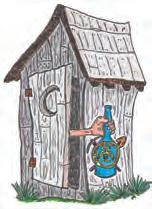
A glass rod, when heated, can be pulled into an ever thinner and seemingly endless glass thread. It was known since the 19th century that these fibres could transport light, but it took until the 1960s for researchers such as Charles Kuen Kao to set the stage for a technological revolution. Since the 1970s, glass fibres about as thick as a human hair are being used to transport huge quantities of information, functioning, in simple terms, as light bouncing in a tube. The network of optical fibre is ever expanding throughout the world. This extensive and invisible network of cables stretches over 1.2 million kilometres globally, delivering emails, news, your favourite films and cute videos of cats almost instantaneously.
(7) Hubble Space Telescope
The Hubble Space Telescope is the first dedicated observatory launched and deployed into orbit by the space shuttle Discovery on 24 April 1990. Two mirrors, made of ultra-low expansion glass (kept at 21°C to avoid warping) offer Hubble its optical capabilities. A primary glass mirror of 2.4 m diameter and weighing approximately 800 kg reflects its light on the 0.3 m secondary mirror. Hubble has revealed crystal clear views of our universe—from distant stars and galaxies never before seen, to detailed observations of the planets in our solar system. Many Hubble observations have led to breakthroughs in astrophysics, such as determining the rate of expansion of the universe. The Hubble Space Telescope is an international collaboration between NASA and the European Space Agency (ESA), and has made more than 1.5 million observations during its 30 years of service.
March – April 2023 5
Glass Weight Load Calculator
I came across a calculator to determine the weight of bottles that a glass shelf will hold. I was surprised at the amount of weight tempered glass will hold. This could be useful to our members. Maybe put in the magazine or newsletter or website somewhere.

https://www.dullesglassandmirror.com/glass-weight-load-calculator

 Michael Seeliger
Michael Seeliger
Brooklyn, Wisconsin
I Spy–Do You Notice Anything Hiding Above?
OMG, I’ve done it again! The other day I was shopping at my favorite honey hole, and ventured to the lamp area. Just typical cheap thrift store lamps. But wait…notice anything? You need a keen eye…What’s this? Let’s remove the ugly 1960s lamp shade and what do we have? Next, let’s remove the improvised lamp parts from the 1950s or 1960s…and we find a perfect circa 1860s-1870s 20” BIM, applied lip, five-gallon, demijohn! When I first picked it up it had all the look and feel of eastern United States glass and sure enough, between a pair of Dyottville whiskeys the color is nearly identical. I’m going with golden olive amber. I now have two of the finest American-made demijohns, both found here in Oceanside. I paid $38 for the lamp and sold the lamp parts for $25. That means the demijohn cost me just $13. Enjoy your holiday. I sure am!

 Brian Bingham
Brian Bingham
Oceanside, California
Brobst & Rentschler flasks


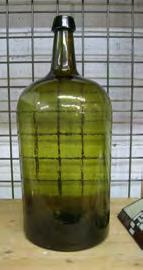
Ferdinand: You might like to see images of two flasks my digger partners and I unearthed in the Wilmington, Delaware, area this past year. These would otherwise have been a couple of ordinary amber strap flasks except for the angled slug plate embossing of Brobs & Rentschler of Reading, Pennsylvania. Brobst is spelled wrong on the pint by omitting a “T.” On the broken half-pint, it appears both names might be incorrect. The “S” is missing from Rentschler, and looking at the spacing of the bottom tips of the letters, it seems the “T” is missing from Brobst also.
I know these errors occur in manufacturing from time to time. Despite the errors in spelling, I don’t think there’s any doubt that it’s their product. There’s plenty of information, auction records, and so forth regarding their figural barrel-shaped “W.C. Bitters” bottle, but no one we’ve asked seems to have heard anything of the embossed flask. The half pint was dug last December, and the pint about a month ago in privies several blocks apart. The pint is also remarkable for the large blob of glass streaked down the interior of one side and the pinched creases near the bottom front and back. Not sure if the blower had the hiccups that day or exactly what, but the bottle is eggshell-thin on one side with the thick streak on the other.

6 Antique Bottle &
Glass Collector
FOHBC News From & For Our Members
[see the comparison picture of the demijohn and the Dyottville whiskey cylinders in Member Photos, p65 this issue]
[See another picture of the pint flask in Lost & Found, p61, this issue]
According to what I’ve learned, Franklin Brobst and Milton Rentschler were in business for 15 years beginning in 1880. Brobst was born in 1847 and served in the Union army during the Civil War. He seems inclined towards public service, having served as sheriff and a few other offices in the Reading area during his lifetime. Less is known about Milton Rentschler, but the last name can still be found in northeastern Pa. directories. Best regards.
David Smith
Pennsville, New Jersey
More on Anchor Hocking Ruby Red Glass Bottles and Lost Cecil Munsey Archives
[Editor] Last issue two architecture students from the Federal Institute of Technology in Zürich had questions about ruby red glass and if they could find an article by the late Cecil Munsey from his dormant and lost website archives.
[Response 1] Ferd, I have quite a few articles from Cecil Munsey that he was sending out a few years prior to his death. I know you mentioned that his online library is lost. I have maybe 20 -30 articles in a folder if the FOHBC could archive them. In one of them is the ruby red article that I attached.
Since I began my bottle collecting with the Ruby Red beer bottles I feel I’m a bit of an expert. I checked to see if my memory was correct as I always was told gold was used to make the color but it was actually copper oxide. The glass was reheated and the CuO was added. They were used in 1949, 1950 and 1963 non-returnable bottles which I was looking for. Being color blind to redgreen was a problem for me.
Here is the source of most of the information. The Mr. Jaeger is Bob Jaeger, a bottle collector from Milwaukee and active in our organizations. He passed away many years ago. https://www.antique-bottles.net/threads/red-royal-ruby-bottle-from-1950.530831/page-2

Michael Seeliger
Brooklyn, Wisconsin
[Response 2] Hello Sir, while reading an article in the most recent issue of AB&GC under News From & For Our Members there was a FOHBC reply to an inquiry mentioning that the web pages by Cecil Munsey have been lost. I stumbled across this website years ago in trying to find sites that were no longer active. https://web.archive.org/
If FOHBC is seeking his work, some if not all can be found here. Have a great rest of the day and even better tomorrows.
Deacon R. Bruce Mobley
Macon, Missouri
LANL Christmas Gift—What Is It?
As some of you know, I work at Los Alamos National Lab (LANL). A few facts about LANL. It is the premier research lab on EARTH, addressing topics such as new nuclear weapons, building new nuclear weapons, space-based weapons, global warming, artificial intelligence, COVID, physics, chemistry, biology, material science, space flight, game theory, statistics…and the list goes on and on. Almost 15,000 people work here, and Los Alamos County has the world’s highest education level per capita. Somehow I fit into this four-dimensional puzzle.

Now turn your attention to the picture below. We all received one of these for Christmas, and I’m asking you to figure out what this gizmo is. It is approximately four inches long, made of cheap-hollow plastic, has a soft black plastic nipple, and a small ring. No, it has nothing to do with fishing; it’s not sharp, it’s not a weapon, etc. When through, go to the end of this writing to find out.
OK…give up? Now, remember LANL’s mission and education lever. This “tool” attaches to the lanyard via the ring. The curved part…aka…hook…is to be used for opening things without touching it—germs—and the black nipple can be used for your smart pad or phone…without touching it, again, germs.
This device is among the dumbest things I’ve ever seen. A few comments: First, the hook fits nothing at LANL offices or buildings. Because it’s attached to a lanyard, you must bend over to use it. One person bent over and tried to open the door to the men’s room; he bent over, and the hook broke off; a person on the other side of the door opened it, hitting the guy with the hook in the head. As for germs, LANL researches biological weapons as well; who knows? My guess is if you use this on your iPhone, wouldn’t the germs be everywhere…just not on the face of the pad. All of this is too complicated for me, so I am donating mine to the Smithsonian Air and Science Museum. And the band played on.
 Chris Hartz Los Alamos, California
Chris Hartz Los Alamos, California
March – April 2023 7 FOHBC News
From & For Our Members
FOHBC News
From & For Our Members
FLORIDA ADVERTISING JUGS THE
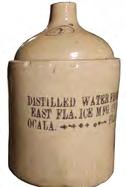
Also, included in this work in addition to the fore-mentioned jugs are advertising corkscrews, shot glasses, advertisements, and photographs. All of which, are shown within the pages of this informative account of this little known part of Florida’s long and colorful history.

Philip A. Pfeiffer author of:
Pensacola’s Currency Issuing Banks and Their Banknotes 18331935, Pensacola’s Soda Water Legacy 1837-1998, Pensacola’s Spirits - 1559-2110

A Brief Email to both of you with Congrats!
A new book by David Kyle Rakes & Corey Lee Stock
Florida Advertising Jugs – The Proprietors & Their Jugs
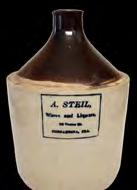


I highly recommend this newly published work entitled “Florida Advertising Jugs” to any and all readers and collectors of Florida’s History. Especially, ones that show an interest in the covered subjects of the production and usage of “stoneware” and glass containers that are commonly referred to as “jugs from Florida,” along with the proprietors that had them made and used such jugs in promoting their businesses. These one hundred plus years old jugs are adorned with the names and locations of the jug proprietors. In addition, many times other pertinent information is included, also a floral design may be applied to the jug’s surface. Thus the name “Florida Advertising Jugs.”
The authors, David Kyle Rakes and Corey Lee Stock, have accomplished a great service for anyone wanting to learn of this very interesting aspect of Florida’s history. That is, the industry of distilling and or marketing primarily spirits of alcohol, also water and other liquids. These jug proprietors were active in the mid to late 1800s up to the time when Prohibition killed this highly profitable industry in the state at the end of the second decade of the twentieth century.
David and Corey have left no stone unturned in the search for information on the lives of the men and their families as proprietors that were at the forefront of this industry in Florida for a half of a century. These two researchers have hunted down the numerous rare and hard-to-locate “Florida Advertising Jugs” on some seventeen cities and towns of Florida. They have documented the histories of the fifty-two jug proprietors, many for the first time.
Hello to the Meyer Team. I received the latest magazine in today’s snail mail box out front of my house. I have not been able to put it down since I started reading it. I stopped on page 34 to write to you about the most interesting digging experience article in this issue. I could not put your magazine down until I had finished reading the article, “A Line from the Past!” I have not personally dug for several years, but I was so caught up in this article that I could not put your magazine down! The author, Rick Weiner, told the story so well that I felt like I was right there witnessing his and his digging partner’s luck. I figured some good news goes a long way. Bad news weighs folks down. Good news promotes the subject matter! Just dropping in with some positive input. Now to get back to the magazine. ALSO: Great front cover with the youngster with blond hair and a look of achievement on his face. VERY ENCOURAGING for folks of any age! Sincerely,
Darlene Furda
Secretary and Contributing Editor for the Los Angeles Historical Bottle Club


New FOHBC Treasurer
The FOHBC board recently approved Kathie Craig as the new treasurer who will replace the outgoing Jim Berry. Kathie lives in Campbell, California and has been married to Mike Craig for 40+ years. She is the mother of four grown children and a grandmother of six. Kathie started collecting bottles when she started working for Mike’s father, Jack Craig, in 1987. She is still CFO and running his companies along with her husband to this day. She was also co-owner and CFO of their construction company for 40 years. She has been the president of the San Jose Bottle Club since 2000. For 28 years, she co-owned and ran multiple drag racing teams with her family. Still passionately collects Warners, Dr. Craig, inks and Owl Drug bottles and especially loves antiquing when she and her husband travel in their motor home.
8 Antique Bottle & Glass Collector
PROPRIETORS & THEIR JUGS DAVID KYLE RAKES COREY LEE STOCK PEACHRIDGE COLLECTIONS
Kathie & Michael Craig
Editor Note: With an abundance of reporting information and photographs this issue, we are placing the entire Regional Directors report on our website FOHBC.org. Please go to the homepage under Editors’ Pick for “The Rest of the Story,” as Paul Harvey used to say.
Northeast Region [Charlie Martin Jr., Director]
At the conclusion of my last report, I informed you about an upcoming antique bottle show in New Jersey. Well, as promised, here is their show report, albeit a bit late, but nonetheless, another very successful show for bottle collectors in the Northeast Region.
The New Jersey Antique Bottle and Collectors Association (NJABCA) hosted its 52nd Annual Antique Bottle and Collectors Show on November 27, 2022, in Compton Lakes, New Jersey. Show Chairman Ed Natale reports that it was a successful event. Approximately 40 dealers set up 40 tables. A strong crowd came through the doors “to pursue bottles, stoneware, glassware, postcards, antiques, and more.” Ed wanted to be sure to thank all who came out, as well as all of those who helped with putting on the bottle show. Plans are already in the works for next year’s event to be held the Sunday after Thanksgiving, November 26, 2023.
The New Year “2023” hardly began when The Little Rhody Bottle Club held its Annual Winter Show on January 8 at the Clarion Hotel in Taunton, MA. Forty buyers paid $15 for early admission, while $3 for general admission was garnered from 190 bottle hunters. Shoppers had over 40 dealers spread out over 75 tables to peruse. Bill and Linda Rose, Co-Chairs for the Show, spoke about all of the wonderful activity between buyers and dealers. This author agrees with the summary review, having spent the whole morning talking with dealers and fellow buyers. The variety of material available was outstanding.
Remember, it is Winter here in the Northeast. Our bottle shows are few and far between. However, listed below are a few upcoming events you may want to put on your calendar.
February 5, The New Jersey Antiques Bottle club (NJABC)

March 12, The Baltimore Antique Bottle Club (BABC)
March 19, The Somers Antique Bottle Club (SABC)
April 16, The Rochester Bottle and Antique Show (GVBCA)
April 30, The Dunkard Valley Antique Bottle Stoneware Show and Sale
Check out the locations and show times in the current issue of the Antique Bottle & Glass Collector or, better yet, FOHBC.org Show Listings.
Look for my report on the above shows in the next edition of AB&GC. I hope many of you will mark your calendars more often this New Year and get out and support your local club’s event. Your participation makes a difference! Until the next issue, Happy Hunting!
Midwest Region [Henry Hecker, Director]
With the ground frozen in most of the Midwest region, digging has slowed but not bottle collecting. The Milwaukee Antique Bottle and Advertising Club has its annual show on February 5 at the Waukesha County Expo Center. The sales tables will number over 120, and space is sold out. As a countermeasure to inflation, the sales table cost was raised this year to $40 from $35, but admissions were held flat, including early admissions, which have allowed the club to put the show back in “the black” the last several years.
February 12 marks the date of the 52nd annual show for the Central Ohio Club at the Doubletree Inn in Columbus. The West Michigan Bottle Club will hold its 32nd annual show on February 25 at the Fonger American Legion Post in Grand Rapids. The North Star Club of Minnesota is hosting its show on April 16 at the Knights of Columbus Event Center in Bloomington. The Ohio Bottle Club holds its Mansfield show at the Richland County Fairgrounds on May 13.
So, for collectors in our region, there are plenty of venues to acquire bottles above ground over the next couple of months. One may have to drive a ways, but shows are the ultimate entertainment...after digging, in our hobby. As Regional Director, as I get more connected with the various clubs, I will heavily promote advertising these various shows in all the club newsletters. As clubs, we tend to be too provincial and focus on our own shows in our communications. We certainly don’t have to worry about competing with each other, and more collaboration can only help in promoting the hobby more effectively.
Eric McGuire’s report in our last issue about how a library staff barely tolerated him for doing bottle research struck a chord with me. His research was viewed as mere whimsy. He went on to say, “It is true that the traditional ‘keepers of history’ seldom have extensive knowledge on the subject.” In my experience, I have encountered an industrial archeologist surveying a site and finding a Hutchinson soda. I introduced myself and told him the entire history of the bottler from my own acquired knowledge. He seemed unimpressed and dismissed me as some sort of charlatan. He probably never did his own research. Several years ago, I found a Comanche Indian Muskwa bottle from Mukwonago, Wisconsin, that our local historical society members scoffed at, “It can’t be a real one! It certainly is not part of OUR history,” one longtime member exclaimed. When the research was finished, the bottle and its progenitors proved to be an amazing story which I will tell in a future article. As I am now president of the historical society, I will do a presentation on the Comanche Medicine Company at one of our museum open dates this year. We do need to make friends with our local historical societies as we both have a lot to offer each other.
Editor Note: Continued at FOHBC.org.
March – April 2023 9
FOHBC Regional News
VIRTUAL MUSEUM NEWS
By Richard T. Siri, Santa Rosa, California
The FOHBC Virtual Museum has been established to display, inform, educate, and enhance the enjoyment of historical bottle and glass collecting by providing an online virtual museum experience for significant historical bottles and other items related to early glass.
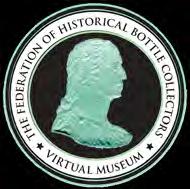
Note from Richard:
Almost daily, there is a new bottle placed in a museum. The first thing I do in the morning is to see if our museum team has placed another bottle in one of the galleries. I’m always looking forward to seeing what’s new.
Of course, knowing about the museum gives me a heads-up about viewing the new additions. What needs to happen is for us to introduce the Virtual Museum to those who do not belong to the FOHBC or don’t even collect bottles. I have gotten a few non-bottle collectors to view the museum, and everyone was very impressed with the website. I don’t know if they became bottle collectors, but maybe a few did.
So make it a point to tell whomever to visit the museum. Besides the great bottles and glass, the catch could be the history and story that goes with them. That’s always very interesting, and our research and write-up group does a great job with this component.
With the financial support we have been getting from donors, the museum is still free to visit. Hopefully, we will continue to maintain that support level of giving. We are getting close to offering a significant commercial donor the opportunity to sponsor a gallery. We need to show a complete gallery like Jars or Spirits to show a sponsor that it would warrant their investment.
Recently Added
Since the last issue of the magazine, we added a couple dozen new examples to the Virtual Museum including a rare amber J. C. Buffum & Co. City Bottling House Pittsburgh, Pa. Hutchinson, a pint “Lafayette” (profile of Lafayette) jar, a pint GXV-25 “Old Rye” “Wheeling Va” lettered flask, a GXII-13 “Union” Clasped Hands “L F & Co” – Eagle and “Pittsburgh, Pa” historical flask, an extremely rare Drakes Plantation Bitters (5-Log variant) in green glass, a “Class of 1846” spirits or wine bottle, a dense, black-amethyst quilted Gablonz Target Ball, a super rare “Georgia Bitters” from Augusta, an outstanding labeled “Kellogg’s Nelson County Extra Kentucky Bourbon Whiskey” fifth, a rare half-gallon “Favorite” jar, and a rare “The Denver” jar, a Fulton’s Radical Remedy Sure Kidney Liver and Dyspepsia Cure, and a grouping of Wishart’s Pine Tree Tar Cordial bottles to name a few.
Annual Virtual Museum Team Meeting
A Zoom conference call occurred on January 17, 2023, from 10:00 to 11:30 am CST facilitated by Ferdinand Meyer V. The call was attended by Brian Bingham, Kathie Craig, Alan DeMaison, Richard Kramerich, Eric McGuire, Ferdinand & Elizabeth Meyer, Gina Pellegrini-Ott, Miguel Ruiz, Michael & Alice Seeli-
ger, Bruce Shephard, Doug Simms and Richard Siri. An abbreviated accounting of the meeting is noted below. You can read the full meeting minutes at Member News at FOHBC.org.
The Houston 24 Exhibition was discussed. Most of the conversation centered on this being the Virtual Museum’s first exhibition which will parallel the actual exhibition at the Houston Museum of Natural Science, which will be the feature component of the FOHBC national event. This could be the most comprehensive grouping of great American bottles and glass in one setting ever. Two premier hair and barber bottle collections are also being displayed.
Alan DeMaison gave an overview of the VM accounting, expenses, fundraising, donor wall, bank account, etc. His latest report was projected. Artwork for Phase 4 using a Wishart’s Pine Tree Tar Cordial bottle was presented. We have started to fill since we broke the $90k Phase 3 threshold.
The latest VM floor plan was reviewed making specific note of galleries where we have been working of late and galleries that we have not started. Future 3D modeling of the museum was briefly discussed but will not start for a few years. The VM Google.docs master list of items in the museum was reviewed.
Miguel Ruiz gave an overview of website performance issues and monthly work. Short-term vs long-term projects were discussed. Miguel is working in several areas to improve the website’s performance. Memory and storage space was previously increased and is sufficient. It was noted that there are very few, if any, websites trying to do what we’re trying to do with the Virtual Museum and that there are many thousands of images. For example, each spinner has 36 images x 700 = 25,200. Each page has an average of eight supplemental support images x 700 = 5,600. This means we have at least 30,000 plus images. This does not include the website museum framework and all the graphics associated with the website.
Alan DeMaison, Gini Pellegrini-Ott and Eric McGuire gave an overview of their imaging progress and plans for 2023. Alan is proposing a Northeast trip planned for Tod von Mechow (sodas and beers) and Joan Cabaniss (poisons). He will also visit a local Ohio region collector to practice and start out our Soda Pop Gallery. Tom Pettit Atlanta trip mentioned. New files have been put into Dropbox. In future years, Gina could travel to Belgium, Germany and England to image some of the great collections. Eric was determined to move into creating spinners using his own technology and work process. He has many bottles of great interest to the museum and will keep everyone abreast of his progress.
Museum History, Research Library, Gift Shop and Marketing was discussed in depth.
10 Antique Bottle & Glass Collector
Please help us fill our Phase 4 Wishart’s Pine Tree Tar Cordial bottle









Please help us in our Phase 4 fundraising capital campaign to continue development of the FOHBC Virtual Museum. The FOHBC and the Virtual Museum team thank our many donors who have helped us raise over $91,800 to date. We have $27,462 in available funds to continue development to build our galleries, exhibition hall, research library and gift shop. Donations are tax deductible. All donors are listed on our Virtual Museum Recognition Wall. With one salaried website technician averaging $1,200 a month, we need help. Plus, we are now traveling to collections with the Pandemic hopefully behind us, so more costs will be incurred. All other time is donated by the Virtual Museum team out of our love and passion for the hobby and the FOHBC. Thank you!

FOHBCVirtualMuseum.org



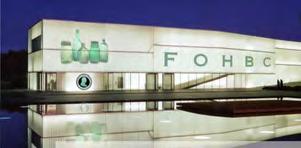

For gift information contact: Alan DeMaison, FOHBC Virtual Museum Treasurer, 1605 Clipper Cove, Painesville, Ohio 44077, a.demaison@sbcglobal.net




March – April 2023 11 EHT EF D E RATIONOFHISTORICALBOTTLECO L L E SROTC VIRTUAL MUSEUM 5k 10k 15k 20k 25k 30k
Phase 2 Jar Filled Dec. 2021 Phase 1 Flask Filled Dec. 2018 Phase 3 Barrel Filled Dec. 2022 Phase 4 Medicine Bottle
You like fluters...or crimpers?
Perhaps 99.8 percent of the people reading this magazine are interested in glass, pottery, or ephemera-related items. (And, OK, one weird-o in Michigan who collects old toilet paper!)
But, if we could wander through these people’s homes, I bet we might spot at least one item that would make us stop and think: “What the...? That doesn’t belong here; what’s the story behind it?”
If you visit the Finch Fantasy Home of...stuff, that will happen since many things cause people visiting here to shake their heads and wonder why, like a salesman’s sample toilet, a 1940’s children’s toilet paper holder that, when used, plays Whistle Why You Work, an 1899 cast-iron child’s tricycle, and the list goes on and on. Oh—and a 61-year-old sumo match umpire’s “bat.” (A souvenir of two-plus years living in Japan.)
So, I am going to ask a few collectors to look around their homes and reveal that strange item that just doesn’t seem to belong.
But first, let’s talk about fluters. I like them and have had one for at least 40 years. Now, since a few weeks ago, I have two.
For those who are curious—and most bottle collectors are, so be patient—we are not talking about a flute, an instrument. Nor are we talking about a flute, as in a tall-stemmed glass for drinking wine.
We mean a fluter, a specialized kind of “sad iron” used to press the fluted ruffles on linen cuffs and collars and other trim. Made from cast iron, the fluter would have been heated by coals in the hearth.

(And fluters are still popular, although now heated electrically. Ask any woman who uses a crimper to curl her hair.)


Here’s a brief review of a popular item from the 1800s. When found on eBay, they are offered at $68-$88. Our example was made in Geneva, Ill., and when found on eBay, runs $70-$100.
Our cast-iron hand fluter is embossed “Pat.d Aug, 21, 1866.” There’s a slot in the side where a handle could be placed to lift it off the fire or stove. The rounded top part is embossed “Geneva Ill.” on the handle and “Geneva Hand Fluter” on the rounded top. The base measures 3 7/8 inches by 6. Many late 19th-century women would probably have recognized this fluter as a specialized kind of “sad iron” used to press the fluted ruffles on
12 Antique Bottle & Glass Collector
b.
*You like tomato ... and I like tomahto?
Looking askew with Ralph Finch a.
c.
linen cuffs and collars and other trim. The fluter would have been propped before the coals in the hearth to heat. The piece to be ironed would be moistened and laid over the grooved base. Then, with a potholder wrapped around the handle, the heated iron would be rocked over the cloth, producing perfectly pressed rows of narrow flutes or pleats.

The weight of the iron and the heat would do most of the work, and compared to pleating and pressing the narrow ruffles individually, this must have been a labor-saving—yet still grueling— item.

The Internet adds: Two-piece hand fluter consisting of a wire handled, convex rocker or presser...Maker is W. H. Howell Co. of Geneva, IL; Eben Danford and William H. Howell established the foundry in 1862, and Howell continued the business in 1866. Reference books cite Charles A. Sterling of New York, N.Y., who received U.S. Patent No. 57,403 for his “improvement in fluting-machines”…However, Illinois histories in the 1870s credit Walter D. Turner (an employee or partner of Howell). The popular hand fluters were made from 1866 to 1920 and were exported around the world.
*FYI: Let’s Call the Whole Thing Off is a song by George and Ira Gershwin for the 1937 film Shall We Dance, where it was introduced by Fred Astaire and Ginger Rogers as part of a celebrated dance duet on roller skates. The song is ranked No. 34 on AFI’s 100 Years of 100 Songs and is most famous for its You like tomato, And I like to-mah-to lyric.
Now, I bet few collectors of antique glass also collect cast iron. That aside, what odd item do you have sitting around the house? Please email me at rfinch@twmi.rr.com. In an upcoming AB&GC, we’ll take a peek again at some collectors’ homes and reveal…


[Editor Note] Read or revisit Nosy writer Ralph Finch wants to poke around your…privates in the March–April 2022 issue of AB&GC.
The Finch Fluter photos, courtesy of Janet Finch, who does like to iron (but not cuffs).
[a] American Machine Co. Philadelphia, Pa, Crimper, Ruffler, Fluter Rolling Iron, Finch collection.
[b] 1877 Fluter, American Machine Co., Philadelphia, Corrugated. Pat. 1875-1877. Finch collection.
[c] Fluter came with a crank and embossed “EAGLE” and “Pat. Nov. 2, 1875.” On the base is “American, Machine Co Philadelphia, Pa.” Finch collection.
[
d] Advertising trade card for the American Machine Company, Philadelphia. Three children with a table and an American Fluting Machine.

[e] Reverse of American Machine Co. advertising trade cards.

[f] Three pictures of an antique cast iron Geneva rocker fluter. “Heat This Pat’d 1866” on bottom. Finch collection.
[g] Hand fluter in action.

March – April 2023 13
G. d. e. f.
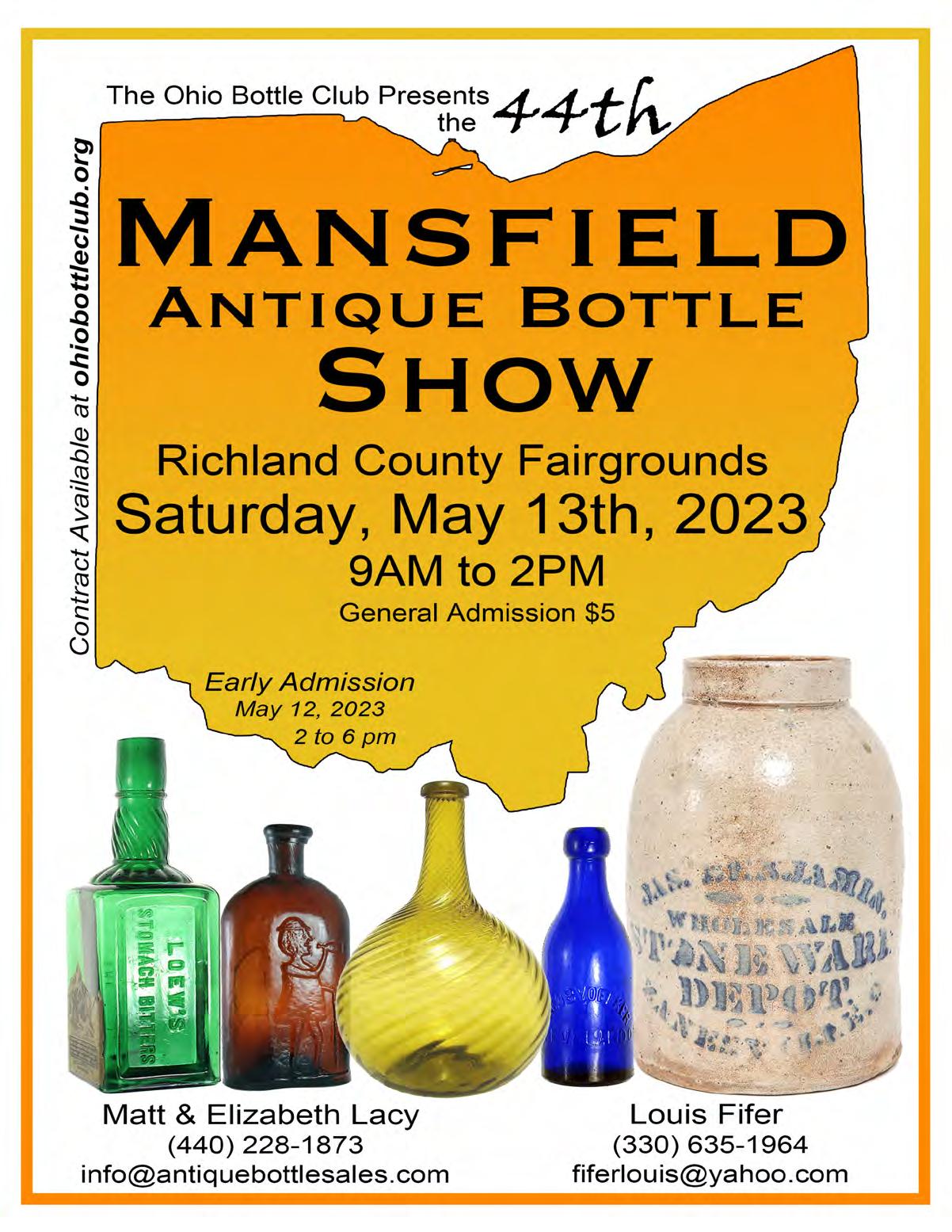
14
Antique Bottle & Glass Collector


Glass Works Auctions proudly presents Part 2 of The Neil Moore Collection of Saratoga and Saratoga type bottles. Closes March 20th, 2023 @ 10:00PM (Lots 90 through 175) Opens for bidding March 13th A limited edition catalog is available for $25.00. (Only a few left!) For more information contact: Glass Works Auctions, P.O. Box 180, East Greenville, PA 18041 Phone: (215) 679-5849 ~ Email: info@glswrk-auction.com ~ Website: glassworksauctions.com
March – April 2023 15
Neil Moore with the ‘Top Ten’ Saratoga County Spring Water bottles at the F.O.H.B.C. National in Chattanooga, Tennessee, 2015.
Marie-Joseph Paul Yves Roch Gilbert du Motier, Marquis de La Fayette
or “Lafayette” and “Laugh-ayette” dans les nouvelles.
By Ferdinand Meyer V
Lafayette was on the Federation radar the first couple weeks of the new year, so we titled this piece in French, “Lafayette...in the News.”
The first Lafayette “touchpoint” was when west coast collector, Brian Bingham, sent a link to the website of the New-York Historical Society, Museum & Library showing their cobalt blue “Laugh-ayette” impostor flask. The second was the inclusion of a rare pint “Lafayette” pictorial bust jar that was added to the FOHBC Virtual Museum Jar Gallery, and the third was a series of very interesting “Lafayette” emails supporting the “Every Bottle has a Story” mantra that many of us subscribe to.
For a quick history recap, Wikipedia says Marie-Joseph Paul Yves Roch Gilbert du Motier, Marquis de La Fayette (September 6, 1757–May 20, 1834), known in the United States as Lafayette, was a French aristocrat, freemason and military officer who fought in the American Revolutionary War, commanding American troops in several battles, including the siege of Yorktown. After returning to France, he was a key figure in the French Revolution of 1789 and the July Revolution of 1830. He was considered a national hero in both countries. His nicknames were “The Hero of the Two Worlds (Le Héros des Deux Mondes),” and “America’s Favorite Fighting Frenchman.”
Lafayette is pretty familiar with antique bottle collectors because his portrait is embossed on historical flasks. In the FOHBC Virtual Museum, we have eight G-I Lafayette portrait flasks in various stages of development and three that are on display; GI-80, GI-81 and GI-86 which are pictured on the left.
[A] Lafayette as a lieutenant general in 1791; portrait by Joseph-Désiré Court.

[B] GI-86 Half pint “La Fayette” Bust of Lafayette “Coventry C-T”–Liberty Cap on a Stick “S & S” Historical Flask, Coventry Glass Works, courtesy Rick Ciralli, FOHBC Virtual Museum.

[C] GI-80 Pint “La Fayette” Bust of Lafayette “T.S.”–“De Witt Clinton” Bust of Clinton “Conventry (sic) C-T” Portrait Flask, Coventry Glass Works, courtesy Rick Ciralli, FOHBC Virtual Museum.
[D] GI-81 Half pint “La Fayette” Bust of Lafayette “S & C”–“De Witt Clinton” Bust of Clinton “C-T” Portrait Flask, Coventry Glass Works, courtesy Rick Ciralli, FOHBC Virtual Museum.
[E] New-York Historical Society website example GI-81 half pint “La Fayette” Bust of Lafayette “S & C”–“De Witt Clinton” Bust of Clinton “C-T” Portrait Flask.
[F] Elie Nadelman with his bronze sculpture Man in the Open Air, c. 1915. George Grantham Bain Collection, Library of Congress, Washington, D.C.
[G & H] “Lafayette” (Profile of Lafayette) pint aquamarine jar imaged on location by Alan DeMaison, FOHBC Virtual Museum Midwest Studio. Phil Smith collection. “Lafayette” jars on display at the FOHBC Virtual Museum Jar Gallery.
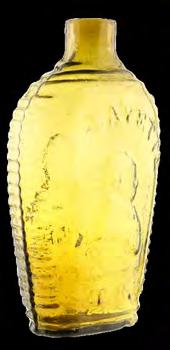 & Glass Collector
& Glass Collector
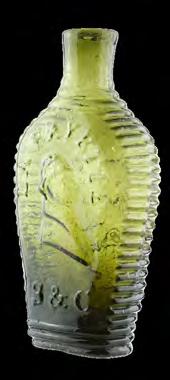
Antique
Bottle
[A] [B] [C] [D]
Laugh-ayette
The “Laugh-ayette” touchpoint started on January 7, 2023 with an email from a west coast collector. “I stumbled on this magnificent flask. The NYHS website search/navigation is not very good but they have a considerable collection of old glass, most of which does not have a picture and if they do, they are insufficient. Someone should do something about that.” This prompted a Virtual Museum Facebook post showing this oddity placed with the outstanding GI-81 examples we already have on display. Historically speaking, there has never been a mention of a cobalt blue example. Well, the Facebook community erupted with laughter as this flask is a known imposter in some circles. Hence the name “Laugh-ayette.” Why it is on display after all these years is perplexing. The flask is old, maybe 100 years but it was not made at the Coventry Glass Works in 1825 or so.
The story behind the flask, according to the NYHS, recounts that the flask was once part of the folk art collection of Elie Nadelman (1882–1946), the avant-garde sculptor. From 1924 to 1934, Nadelman’s collection was displayed in his Museum of Folk Arts, located in the Riverdale section of the Bronx. The Historical Society purchased Nadelman’s entire collection in 1937. The flask was part of “French Founding Father: Lafayette’s Return to Washington’s America,” New-York Historical Society, November 16, 2007-August 10, 2008. We understand Mark and Andrew Vuono went to see this flask and confirmed it was made later. The FOHBC will contact the NYHS in person or via letter so this flask can be removed or have the description updated.


“Lafayette” (Bust of Lafayette) Jar
On January 13, 2023 our second touchpoint with Lafayette was when we added a rare aquamarine “Lafayette” (Lafayette pictured in profile) pint from the Phil Smith collection to the FOHBC Jar Gallery. There are at least three primary “appearance” versions of this jar. One is embossed ‘THE LAFAYETTE’ in block letters. The second is embossed ‘Lafayette’ in cursive initial cap underlined letters. The third, like our museum’s primary example, is embossed ‘Lafayette’ in cursive initial cap letters that are beneath an embossed pictorial profile bust. The jar dates from 1883 to 1884. Please visit the musem gallery for the spinner, full history and many other support images.

We are not sure it is “the” Lafayette but who else could it be? Maybe the local grocer had his image embossed on a jar? I doubt it. There were at least three different molds made for the “bust”

March – April 2023 17
[G] [H] [E] [F]
variation of the jars and three distinctly different line drawings of the bust. One shows an apparently younger man. It is possible that the “younger” bust variation was made after the other one wore out, or the molds were used simultaneously. The mold makers had their work cut out for themselves as there were many period illustrations and paintings to reference.
Lafayette Follow-up
[Eric McGuire, Petaluma, California] When I see bottles commemorating Lafayette, a true American patriot, it reminds me of my search, about ten years ago, for his burial place. I am a “closet collector” of tombstone images. I knew he was buried in Picpus Cemetery in Paris but had no idea where that was. I had taken many photos at Pere Lachaise and Montmarte but had no idea where Picpus was. After walking down the street where it was supposed to be located, I found the correct address but was confronted with a huge gate and no indication of where a cemetery might be. Taking a chance of being chased out of someone’s private property, Lisa and I opened it but saw no cemetery. I found a man in a little office and asked if a cemetery was nearby My French is minimal at best, but I clearly understood when he pointed toward the back of a large area at yet another large wooden gate. Lisa and I kept walking, with no indication of a cemetery, but came upon a stone wall with an entrance. We entered and finally found what must have been Picpus. The first attached photo shows roughly one-half of the cemetery. Lisa is at the far right, checking out the stones of many of the graves of those who lost their lives during the French Revolution of 1794.
After walking nearly the entire cemetery, we finally found the plot for Lafayette in the most distant corner. See the second attached photo. I think what struck me the most is all the funerary additions that have accumulated over the years which have been placed in his plot. They include a variety of plaques and medallions from various organizations—all American—who have had some connection with Lafayette during his lifetime. He was truly a loved patriot for the “American cause.”
[I] Assorted examples of how Lafayette was portrayed in paintings.

[J] Roughly one-half of the cemetery. Lisa is at the far right, checking out the stones of many of the graves of those who lost their lives during the French Revolution of 1794.

[K] The plot for Lafayette in the most distant corner.
[L] Funerary additions that have accumulated over the years which have been placed in his plot.


[M] Historical marker approximately 15 miles east of Montgomery, Alabama.
[N] Lafayette Ginger Ale. Lafayette Mineral Springs Company. Derry, New Hampshire.
[O] Promotional glass from the Lafayette Mineral Springs company.
[Doug Simms, Prattville, Alabama] Thanks for this, Eric! Dad and I love Lafayette flasks, and it’s great to see some good research/perseverance in finding his gravesite. Lafayette is/was a big deal around the Montgomery, Alabama, area as he came through here in 1825 as the last surviving General of the Revolutionary War. The state celebrated him with many stops and
18 Antique Bottle & Glass Collector
[I] [J] [K] [L]
steamboats down the Alabama River, spending $17,000 entertaining and celebrating him—more than they had in the treasury at the time. Fifteen miles east of Montgomery, just off the old Federal Road, is the site of the old Lucas Tavern, where Lafayette stayed on April 2, 1825. The city moved the tavern building to downtown Montgomery in 1978, and the previous site is now a large and deep gravel pit (much to the chagrin of a hopeful bottle digger). More info and pics of the tavern here: http://www.goathillhistory.com/blog/2016/4/5/lucas-tavern
Also pictured is a promotional glass from the Lafayette Mineral Springs company sporting Lafayette in the same finery. Not sure of the age of the glass, but certainly from the same era, if not later. Etched and embossed ginger ale glasses were popular at the turn of the 20th century and beyond.

Thanks for your illuminating thoughts. History is there for us to learn from, and in many ways.
[Ken Previtali, Prattville, Alabama] Hello Doug and Eric, Ken Previtali here (Danbury, Connecticut), whom you may or may not recognize as the “Ginger Ale Guy.” As I watch the parade of bottles entering the Virtual Museum, other than exclaiming about the stellar work Ferdinand and the team consistently do, there is little opportunity for me to comment from my collecting perspective. Then your remarks about Lafayette showed up.
From 1824 to 1825, Lafayette made a “farewell” tour of the states. Of the 24 states he traveled to, New Hampshire, has the most markers noting the details of his visit to each location. On May 4, 2021, Derry, New Hampshire, received its historical marker. But long before that, many honors and place names in New Hampshire were given to Lafayette.

However, the namesake I found most interesting was the Lafayette Mineral Springs Company of Derry. One of my prized ginger ale bottles is a “Lafayette.” The bottle is a BIMAL crown top made before or around 1906. The die-cut image of the General speaks for itself.


In nearly 40 years of collecting, I have seen only two of these, both of which I bought at least 30 years ago. One is in my collection, and the other I gave to a dear friend, an old-time native resident of Derry. Even though she was an antique “browser” and collector, she had never seen one, and it sits proudly in her cabinet. I suspect that there are more of them sitting in dark, dusty corners of New Hampshire houses, waiting to be discovered.
Doug Simms, Prattville, Alabama] This is great info Ken provided, and I’m glad to see you are doing a follow up Lafayette story in the magazine. Ken’s promotional bottles and glass make me wonder if there is a Lafayette bottle and glass trail that could be figured out and mapped to go with the magazine story, or as a later expansion. Dad has seven or eight Lafayette molds, most made in New England, and just got the GI-93, which was Wheeling’s tribute. There are two midwestern Lafayettes, GI-92 and GI-93. Helen McKearin goes into great detail about the two. Both have Wheeling on the flask, but she makes a good case for the 93 being made outside of Cincinatti in Moscow, Ohio. So, if we pursued a glass trail based on a map of his visit (https://www.thelafayettetrail.org/map/), and the associated glass houses making the bottles, we could come up with something pretty interesting.
March – April 2023 19
[O]
[M] [N]
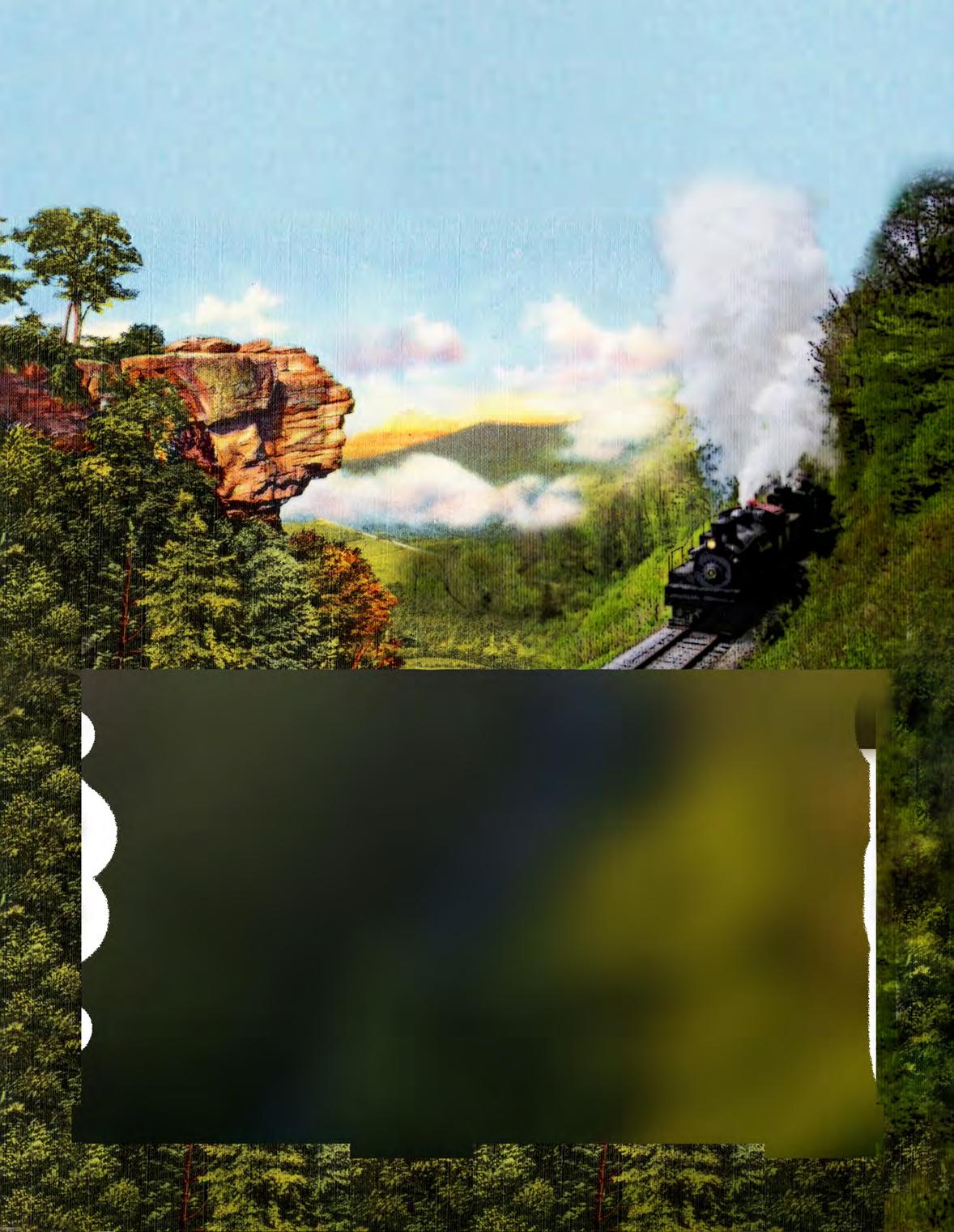


20
Antique Bottle & Glass Collector






March – April 2023 21 Pleasenote:EmailSign Up is Now Required for NotificationofStartDates for Premier&Impromptu Auctions! MakeSure You Are Registered &OnOurMailingList!
ACL CORNER #3
Chief Washakie Beverages, Wyoming Product, 1960



NATIVE
Americans, of course, were the first human beings to inhabit North America and lived in every corner of the continent before the arrival of the Europeans. One of the most popular categories of ACL soda bottles to collect (and my personal favorite) is Indian bottles. Although many brands depicting Indians were bottled in the Western states, the bottles come from across the U.S. Approximately a hundred or more different ACLs depict Native Americans.
“Chief Washakie Beverages” is a 10-ounce soda brand bottled by the Worland Bottling Co. of Worland, Wyoming, the county seat of Washakie County, in 1960. The ACL features a dramatic and realistic
portrait of the noble-looking Chief wearing his eagle-feather battle headdress, framed by a Native American geometric design. Born sometime between 1798 and 1804, Chief Washakie was a fearless and ferocious warrior who led the seminomadic Eastern Shoshone Tribe of Wyoming and Idaho. Proficient horsemen and fierce fighters, the Shoshone battled their traditional tribal enemies and, for a time, the growing influx of white settlers and travelers encroaching on their land. Washakie, however, came to realize that the white tide was unstoppable and made his peace.

He must have had a remarkable intellect, learning French and English from the famed trapper Jim Bridger, who married one of Washakie’s daughters. He signed treaties with the United States Government in 1863 and 1868, thereby acquiring the vast reservation in which his people still live today. Then, he and his warriors fought alongside the U.S. Calvary in the Battle of Rosebud in 1876 against the

22
Antique Bottle & Glass Collector
[Mike Dickman]
Crown cap from Sioux Beverages. Many ACL bottle collectors, including the author, also collect the colorful bottle caps which in some cases are harder to find than the bottles.
[Below] Photograph of Chief Wadena (left) and Joe Critt (right), an Ojibwe and U.S. Army veteran who fought for the Union during the Civil War, circa 1910. It is noteworthy that the other tribal members are wearing Western attire. Photo courtesy of Minnesota Historical Society.
[Above] Undated photograph of Chief Washakie, from the Smithsonian Institution. Late in his life, Washakie was challenged by a group of young braves as being too old to lead. Saying nothing and notwithstanding his Christian faith, Washakie left and returned after several days with the fresh scalps of enemy warriors. Apparently, this ended the debate.
[Below] An encampment of Blackfoot tipis (also spelled teepees) on the Great Plains, circa 1910. Photograph by Arthur Rafton-Canning (18641952).
Shoshone’s enemies, the Cheyenne and Sioux. In 1886, Chief Washakie’s friend Brigham Young baptized Washakie into the Church of Jesus Christ of Latter-day Saints, and in 1897 he was baptized again into the Episcopal Church.

Washakie became known as “the Great Peace Chief” and was admired and beloved by his tribe as well as his Wyoming neighbors. The U.S. Army named one of its military outposts Ft. Washakie (which, as far as I can tell, is the only fort named for a Native American), and, in another unusual honor for the era, he was given a full military funeral and interred at his namesake fort when he died in 1900, well into his nineties. Although scarce, the bottle appears on the market from time to time and a nice example can be obtained for $100 to $150.
Chief Washakie embodied President Reagan’s famous dictum, “Peace through Strength,” but another peace-loving Indian chief lived the uglier side of America’s treatment of natives.
“Chief Wadena” is a 7-ounce soda bottle put up by the Wadena Bottling Works of Wadena, Minnesota in 1939. It is a rare bottle typically found with scuffs, scratches and case wear from repeated refilling and reuse. The black-and-white ACL depicts a full-length portrait of Chief Wadena holding a long gun and dressed in traditional Ojibwe attire which he wore throughout his life, eschewing white man’s attire.


Wadena succeeded his father as the Chief of the Mille Lacs Band of Ojibwes in northern Minnesota, and he refused to wage war on the encroaching settlers, miners and federal troops as they took over more and more of the traditional lands of the Mille Lacs. That seems to have been Wadena’s nature since a local historian wrote, “Chief Wadena was not a warrior by disposition, and I have never heard that he ever joined war parties against the tribe’s hereditary enemies, the Sioux, who were at war with the [Ojibwes] for a couple of centuries.”
[Below Right] Mound of buffalo skulls, circa 1870. From a continental herd of sixty million animals in 1800, buffalos had dwindled to just 541 animals by 1900. Conservation efforts by various tribes, states and the feds increased the herd dramatically during the twentieth century.

March – April 2023 23
Sioux Brand Beverages, 1948
[Below] “Hunting Buffalo” by George Catlin, 1844. Although colloquially called buffalos, the animals are actually American bison, and are only distantly related to the true buffalos of Africa and Asia.
[Above] Chief Wadena, 1939. The population of Wadena, Minnesota, where the soda was bottled, was less than 3,000 souls in the 1940 census, which helps explain why the bottle is so hard to find.
A treaty in 1864 creating a reservation was repeatedly violated by squatters and timber companies, and a subsequent act of Congress attempted to force the Ojibwes off their reservation to open the land to development. Although many in his band gave up and moved onto allotments, Chief Wadena refused to go until a sheriff’s posse burned down his village in the early 1900s and forced him and his followers off their land.

Notwithstanding the unfair situation, Chief Wadena apparently turned the other cheek and continued to lead and govern his people in peace. Wadena was revered by his people and died in 1925, over 80 years old (although nobody is certain about his birth date). Subsequently, white men named their city and county in Wadena’s honor, as did another City of Wadena in northwest Iowa, near the Minnesota border. The “Chief Wadena” soda brand, with its dignified portrait of the Chief, seems to reflect the esteem in which the local populace held Chief Wadena, despite the wrongs they had done to him and the Ojibwe. After Wadena’s death, his tribe dwindled in size and became mired in poverty. Their circumstances changed,
however, after the tribe opened two highly successful tribal casinos in the early 1990s. In 1999, the U.S. Supreme Court restored the Ojibwe’s right to hunt, fish and gather on their ancestral lands, and the tribe today has a thriving self-government, a growing population and a decent standard of living.
A collector looking at the two bottles may well ponder the difference in attitudes between the two great chieftains, Washakie and Wadena, and what lessons they might hold for today.


No group of Native Americans has captured the imagination more, both now and during the nineteenth century, than the tribes who hunted buffalo across the Great Plains. In the 1500s, the tribes acquired horses traded and stolen from Spanish troops and settlers, and they developed a nomadic, equestrian culture that followed the vast herds of migratory buffalos. The Plains Indians include some of the most storied tribes, including the Arapaho, Blackfoot, Cheyenne, Comanche, Crow, Pawnee, Shoshone and Sioux, and portraits of their people grace many of the most artistic of the Indian ACLs.
“Sioux Brand Beverages,” bottled by the Seven-Up Bottling Co. of Sioux Falls, South Dakota in 1948-52, and “Red Lodge Beverages,” bottled in Red Lodge, Montana by Red Lodge Beverage Company in 1947, are two ACL soda bottles that I love. Both bottles contained just seven ounces of soda pop, which seems a remarkably small amount of product in today’s age of the 64-ounce Big Gulp. The bottles depict realistic renditions of a Sioux warrior and a Plains Indian encampment, flanked by distinctly Native American design elements. Neither bottle is terribly hard to find or expensive. In August of 2022, a mint example of the Sioux warrior bottle sold on eBay for $125, with six bidders vying for it.

24 Antique Bottle & Glass Collector
Sioux Brand Beverages, 1948
Big Chief Beverages from Denver, Colorado, 1950
[Right] $5 Silver Certificate, Series of 1899, depicting a portrait of Chief Running Antelope of the Sioux Tribe. After the note was issued, critics pointed out that the chief’s war bonnet was Pawnee, not Sioux.
Dramatic renditions of Plains Indians also are found on two versions of “Big Chief Beverages,” one from Denver, Colorado in 1946-50 and another from Falls City, Nebraska in 1958. Big Chief was a brand owned primarily by local Coca-Cola Bottling Companies in the West, Midwest and South and were bottled in dozens of cities using many different ACLs. I know several collectors who are attempting to obtain an example of every Big Chief soda bottle made, which is no easy task!
A wonderful ACL of a bison head is depicted on “Calgary,” a 12-ounce bottle from Calgary, Canada, located on the western edge of the Canadian Prairie, north of the U.S. states of Idaho and Montana. Buffalo herds numbering in the tens of millions once roamed throughout the North American plains and were the staff of life for the Plains Indians, who used every part of every animal they killed. However, buffalo were slaughtered to near extinction by Anglo sports hunters during the late 1800s, who would take the skins or trophy heads (or nothing at all) and leave the carcasses to rot. Some hunters shot hundreds of buffalo a day from the windows of trains traveling across the prairies. This, of course, was one of the grievances—and a cause for going to war—of the Plains Indians.
We’ve only scratched the surface of Native American ACL soda bottles, but let’s conclude with “Mingo Beverages” from the Mingo Bottling Company of Williamson, West Virginia, bottled in 1954. Williamson is the seat of Mingo County, named for the Mingo Tribe of Iroquoian Indians who migrated into the area in the 1700s from western New York. The bottle holds nine ounces of soda pop and also comes in a scarcer (but in my view, less attractive) red-and-white ACL depicting the same pretty maiden. The orange-and-black version makes a very dramatic statement on the bottle shelf! And an example won’t break the bank, either: my bottle is mint and cost $65.



If you enjoy attractive, colorful, historically interesting bottles that are reasonably priced and reflect quintessentially American themes, why not start a collection of ACL soda bottles?
BIBLIOGRAPHY:
Bowers, Q. David and Sundman, David, 100 Greatest American Currency Notes, Whitman, Philadelphia, 2006.
Mille Lacs Band of Ojibwe website, under “History.” The Ojibwe are also known as Chippewa.

Sweeney, Rick, Collecting Applied Color Label Soda Bottles, 3d edition, 2002, PSBCA.
Wikipedia, entries for American Bison, Buffalo, Calgary, Mingo, Plains Indians, Shoshone, Sioux, Wadena, Washakie, Williamson, and Wyoming.
March – April 2023 25
[Above] Calgary, undated and with no bottling company shown. A more common version of the bottle depicts the bison head in white paint, rather than black.
[Left] Roadside marker near Worland, Wyoming, where “Chief Washakie Beverages” was bottled.
[Right] Mingo Beverages, 1954
[Above] Big Chief Beverages, Falls City, Nebraska, 1958
The Sprinkles of Whiskey: Distilling Their Story

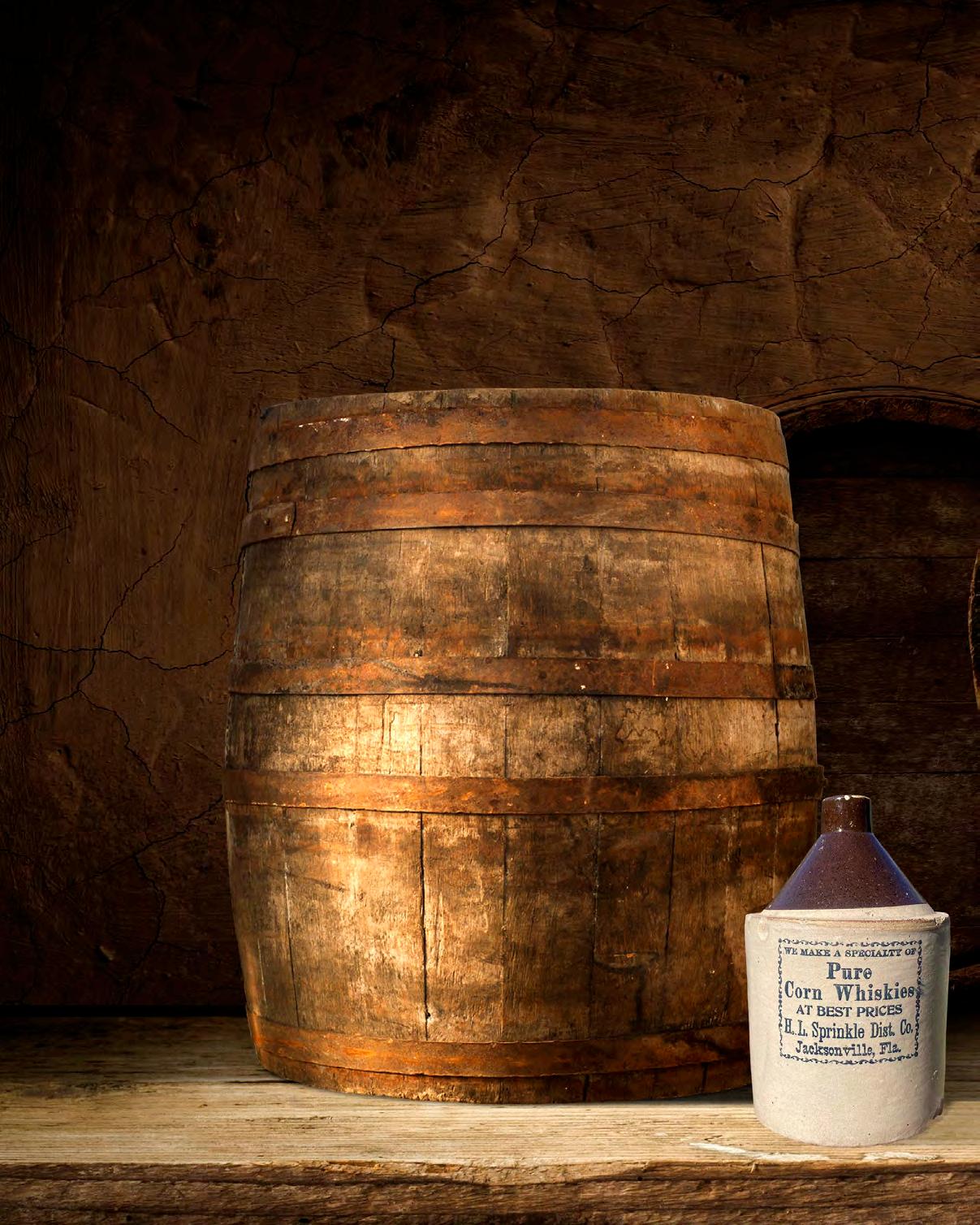 By Jack Sullivan
By Jack Sullivan
26
Antique Bottle & Glass Collector
on his farm in Liberty Township, Yadkin County, North Carolina, the elderly Hugh Sprinkle must have thought frequently about how distilling whiskey had impacted his life, the lives of his sons, and even the lives of his grandsons. It had been a bumpy, three-generation ride, but the Sprinkles had persevered.

Shown here (Fig. 1) with his wife, Martha, Hugh Sprinkle was born in 1883 into a family with deep roots in Yadkin County, located in the northwestern Piedmont region of the state. The county was rife with distilleries, most of them small but legal, operations on farms that used homegrown corn and rye to make small quantities of whiskey for local sales. It is possible but not documented that Hugh’s father had such an operation.

Hugh himself first appears in the public record during the Civil War. By the end of March 1862, the Confederacy was running short of soldiers. President Jefferson Davis proposed that all men between the ages of 18 and 35 should be enrolled in Confederate service, and 19 days later, the Confederate Congress passed the first conscription law in U.S. history. Sprinkle was 29, married, with two small children at home and like many Southern hill farmers without slaves, not passionate for Dixie’s cause.
In 1863 a group of Yadkin men, among them Hugh Sprinkle, resisted being conscripted against their will and precipitated what came to be known as the “Bond School House Affair.” In February, a group of resisters, numbers differ, gathered in a one-room log school building near a Quaker Meeting House. With the help of
the Quakers, they planned to hike over the mountains to Union territory. Alerted to this gathering, the local North Carolina militia rode up to arrest the resisters and gunfire broke out. Two members of the militia were killed, including a captain, as well as two of the resisters. Many escaped but a number were arrested and charged with murder, among them Hugh. A historical marker notes the spot. (Figs. 2, 3)
Friendly local officials wrested the resisters from military control and a firing squad, putting prosecution into civil justice hands. Bail was set at $250 each, and a future trial date was set. It appears that the judge was willing to hold Sprinkle not guilty of the shootings and drop any charges if he joined the Confederate Army. The record shows that in November 1863, Sprinkle enlisted as a private in the 31st Infantry at Camp Holmes, North Carolina. Subsequent to his joining, the 31st fought at White Hall, then moved to the Charleston area where it was engaged in various conflicts, including the battle at Battery Wagner. Ordered to Virginia, the regiment took an active part in the battles at Drewry’s Bluff and Cold Harbor and later endured the hardships of the Petersburg siege north and south of the James River. In 1865 the 31st fought its last battle at Bentonville, North Carolina. The history of his unit would indicate that Sprinkle saw plenty of combat but managed to survive.
After the war, Hugh returned to Yadkin County and resumed farming. The 1870 U.S. Census recorded him there, living with his wife, Martha, and four children, including the eldest son, named Benjamin Franklin (known as “B.F.”) Sprinkle. During ensuing years, Hugh
March – April 2023 27
LIVING
[Fig.1] Hugh Sprinkle and his wife Martha.
ran a distillery in connection with his agricultural pursuits. A North Carolina directory listed the following: “Distillery (whiskey), Yadkinville, Hugh Sprinkle.” Moreover, in the 1880 census B. F. Sprinkle, age 21, gave his occupation as “working in distillery.”

The Sprinkles continued making whiskey without important intrusions until 1903. That year the North Carolina legislature, in an attempt to appease Prohibitionist forces, passed a law that required all distilleries to operate in incorporated towns. Some whiskey makers were forced out of business, and others took the expedient of incorporating. It appears that Hugh and his sons took that step. U.S. internal revenue documents for that year record the town of Sprinkle, N.C., where several distilleries were registered. Sprinkle was listed as having a post office. If it was like other distillery incorporations, the town elected a mayor and aldermen, wrote bylaws and ordinances, often with tongue in cheek.
By this time, the distilling torch had been passed to Hugh’s sons, Benjamin and Hugh Clinton. Although evidence is scant, they appear to have expanded production and sales to some degree while still farming. In 1880 B. F. Sprinkle married a woman named Martha Gross of Yadkin County and they raised a family in neighboring Rockingham County. Shown here is a photo of the couple surrounded by six of their children (Fig. 4). All four boys pictured—Benjamin Jr., James T., Henry “Hence” and Hugh “Clint” Sprinkle—would follow in the family tradition of whiskey making.
Whatever distilling operations the Sprinkles engaged in after 1903 were terminated in 1909 when North Carolina dealt its whiskey-making industry a final blow by passing a statewide ban on all alcohol production. Soon after, the state legislature revoked the incorporation of “whiskey towns.” Some displaced distillers moved to Virginia, where
liquor was still legal. Others headed to Florida. The whereabouts of the Sprinkles immediately after 1909 is absent from the public record.

The first evidence I can find of the H. L. Sprinkle Distilling Company—named for Henry L. “Hence” Sprinkle, the son of B. F., was its 1912 incorporation in the town of Girard (now Phoenix City), located in Russell County, Alabama. The purpose of the business, as recorded with the state, was the “manufacture, purchase & sale of whiskey.” During this period, the Sprinkles also appear to have operated a distillery in or near Pensacola, Florida. It was incorporated in 1914 with a capitalization of $15,000. Unfortunately, Florida documents do not record the individual incorporators. The Sprinkle company letterhead claimed that this facility was the only distillery in Florida “operating both dryer and compressor, saving all the byproduct of the grain for feed” (Fig. 5)
B.F. SPRINKLE & FAMILY HISTORY
[Fig. 4] B. F. Sprinkle and his wife Martha. Shown here is a photo of the couple surrounded by six of their children. All four boys pictured: Benjamin Jr., James T., Henry “Hence” and Hugh “Clint” Sprinkle would follow in the family tradition of whiskey making.

28 Antique Bottle & Glass Collector
[Figs. 2 & 3] Bond School
House historical marker (front and back)
DISTILLERIES ADVERTISING


Although the Sprinkles almost certainly had relocated to Jacksonville several years earlier, their company first showed up in a 1916 local directory. That likely is the result of a gap from 1905 to 1916 in extant Jacksonville directories. When the company did appear, it was listed as located at 34 East Bay Street. Hence Sprinkle, Hugh’s grandson, was recorded as the president and his brother, James T., as the secretary-treasurer.



By the following year, a major change had taken place in the management. Now James T. Sprinkle was named as President, Hugh Clinton Sprinkle was vice president, and B. F. Sprinkle was secretary and treasurer. B. F.’s third son, Benjamin Franklin Jr., was working as a clerk. According to the directory, James was residing in Pensacola, where I surmise that he was in charge of the distilling operations and that the other Sprinkles were managing sales operations at the family liquor store in Jacksonville, where the three were recorded living. The following year saw further changes in the directory entry. James was still the president, but now B. F. was vice president, Hugh Clinton was secretary-treasurer, and Benjamin Jr. was the manager of the H. L. Sprinkle Distilling Co. James was still living in Pensacola and B. F. was recorded living in Reidsville, North Carolina.
Because of its proximity to rail lines up and down the East Coast, Jacksonville had become a hub of whiskey dealers, many of them displaced from other states and now emphasizing mail-order sales. Some 77 were listed in the 1916 city directory. Among them was I. C. Shore, who arrived from North Carolina via Virginia. Another was John Casper, originally from North Carolina, who


March – April 2023 29
[Fig. 5] Illustration from a Sprinkle company advertisement showing one of the distilleries in Girard, Alabama or Florida operating both dryer and compressor, saving all the byproduct of the grain for feed.
[Fig. 6] Five H. L. Sprinkle Distilling Co. newspaper advertisements. “This is the original NORTH CAROLINA CORN shipped direct to you, just like it comes from the Distillery” and “Sprinkle’s Square and HONEST PURE North Carolina WHISKEY.” Express PAID to your Door.
1915Greenville
1910Valdosta
1910Valdosta
1910Atlanta
1910Valdosta
changed the name of his firm from The Casper Co. to Atlantic Distilling in Jacksonville. One Sprinkle ad seemed pointed at Casper, who was something of a scoundrel, emphasizing that their company had always advertised under the Sprinkle name: “Our reputation is so well known that we never have to change our name.” As shown in a 1915 ad, the firm also stressed its North Carolina roots, saying: “This is the original NORTH CAROLINA STYLE CORN, shipped to you just as it comes from the Distillery” (Fig. 6).
As shown here, much of Sprinkle’s whiskey was sold in gallon glass jugs with the embossed motto, “Sprinkle Whiskey Wants Your Business” (Fig. 7). Three cities appeared on each bottle. Early jugs bear the Girard address. Clear quarts (Fig. 8) were also used. After Alabama went dry, the Sprinkles moved that retail outlet to Monroe, Louisiana. The Monroe outlet appeared on clear quarts. The Sprinkles also used ceramic jugs to bottle their whiskey (Fig. 9). In addition, the company became known for issuing a variety of small ceramic mini-jugs, many of them bearing the name of the family’s flagship brand, “Ridgeway Straight Corn Whiskey” (Fig. 10)



The Sprinkles’ advertising throughout the South, both for whiskey and beer, emphasized mail-order sales, suggesting buying by the case. The messages were carried in their newspaper ads, such as this example from a 1915 Atlanta Constitution (Fig. 12) and on colorful celluloid pocket mirrors (Figs. 13, 14). While mail order was a lucrative trade, it was not without its problems. Although Georgia had voted itself “dry,” the law allowed residents to have limited amounts of alcohol shipped to them monthly from out of state. Frequently, however, local authorities would seize such shipments and arrest the express agents. As a result, express companies often refused to carry “wet” goods into dry states. In 1913 the Sprinkles took a proceeding to the Georgia Supreme Court to force the Southern Express Company to carry their liquor to its destination. Moreover, in 1916 B. F. Sprinkle Jr. was forced to apologize for a situation in which a liquor shipment had been sent to an individual identified as a minor. He promised to reimburse the 70 cents in express charges if the whiskey was returned for reshipment to an adult.
Because of their struggles with “dry” forces in North Carolina, the Sprinkles must have been keenly aware of the tightening
GLASS
Despite their exile from their old home place in North Carolina, the Sprinkles seem to have found success in a short time with their Florida base. Not only did the company provide its customers with whiskey, it also bottled and sold its own brand of beer, Sprinkle’s “Dixie Delight.” As shown in an ad here (Fig. 11), the company emphasized that its brew was “The Good Wholesome Brand” and suggested that “All people should drink good wholesome beer daily with their meals.” This merchandising mix of liquor and beer is itself enough to set the Sprinkles apart. At this time, a feud was raging between distillers and brewers, with some of the latter blaming the Prohibition movement on the liquor industry, apparently in the hope, fruitless as it turned out, that beer would escape a national alcohol ban.

noose of National Prohibition around the liquor industry. With the passage of the Volstead Act in 1919, the H. L. Sprinkle Distilling Company shut down its distillery and sales offices. According to Sprinkle descendants, the family had a stock of liquor when America went dry but was allowed to book passage on ships and take their wares abroad to sell. After their supplies were gone, B. F. and Hugh Clinton began investing in gas stations in North Carolina. In the 1920 U.S. Census, the occupation of James T. Sprinkle was listed as “green grocer” in Pensacola.
The man who had launched the family into distilling, Hugh Sprinkle, died in 1914. B. F. Sprinkle died in 1936, living long enough to see Prohibition repealed. Shown here is a Sprinkle family burial plot with its identifying marker
30 Antique Bottle & Glass Collector
[Fig. 11] Sprinkle’s Dixie Delight Beer advertisement.
[Fig. 7 Left] Sprinkle’s whiskey was sold in gallon glass jugs with the embossed motto, “Sprinkle Whiskey Wants Your Business.” Three cities appeared on each jug.
[Fig. 8 Right] Sprinkle’s whiskey was also sold in clear fluted quarts, this example embossed, “One Qt. Sprinkle Whiskey Wants Your Business Jacksonville, Fla., Pensacola, Fla., Girard, Ala.”
located in Greenview Cemetery, Rockingham County, North Carolina. (Fig. 15). B. F.’s grave is in the foreground. Around him are other family members, including Hence and James. Thus ended a whiskey dynasty that fought the good fight against the forces of Prohibition and, although losing in the end, prospered for a time and left behind the bottles and other artifacts by which we can remember the Sprinkles of whiskey.

Note: My gratitude goes to two individuals who have a kinship with the Sprinkle family. A direct descendant, Margaret Sopp, keeps a website devoted to the Sprinkles. The other contributor, Wanda Sprinkle, is related through her husband. Both have provided important information and photos for this profile. Their contributions include the family pictures, the color illustration of the distillery, and the ad for Dixie Delight beer.

JUGS

a brown cone top and advertising in a rectangular border that reads, “We Make A Specialty of Corn Whiskies



MIRRORS

March – April 2023 31
[Fig. 13] Oval H. L. Sprinkle Distilling Co. give-away pocket mirror.
[Fig. 14 Below] Circular H. L. Sprinkle Distilling Co. give-away pocket mirror.
[Fig. 9] At least two types of stoneware whiskey jugs were made for H. L. Sprinkle Distillery. Pictured is a two-gallon, cream-colored jug with
At Best Prices H. L. Sprinkle Dist. Co. Jacksonville, Fla.”
[Fig. 10] H. L. Sprinkle Dist. Co. also issued a variety of small ceramic mini-jugs, many of them bearing the name of the family’s flagship brand, “Ridgeway Straight Corn Whiskey.”
[Fig. 12 Right] H. L. Sprinkle Distilling Co. advertised throughout the South, both for whiskey and beer, emphasizing mail-order sales. The Atlanta Constitution, March 12, 1915
[Fig. 15] Sprinkle family burial plot in Greenview Cemetery, Rockingham County, North Carolina. B. F.’s grave is in the foreground. Around him are other family members, including Hence and James.
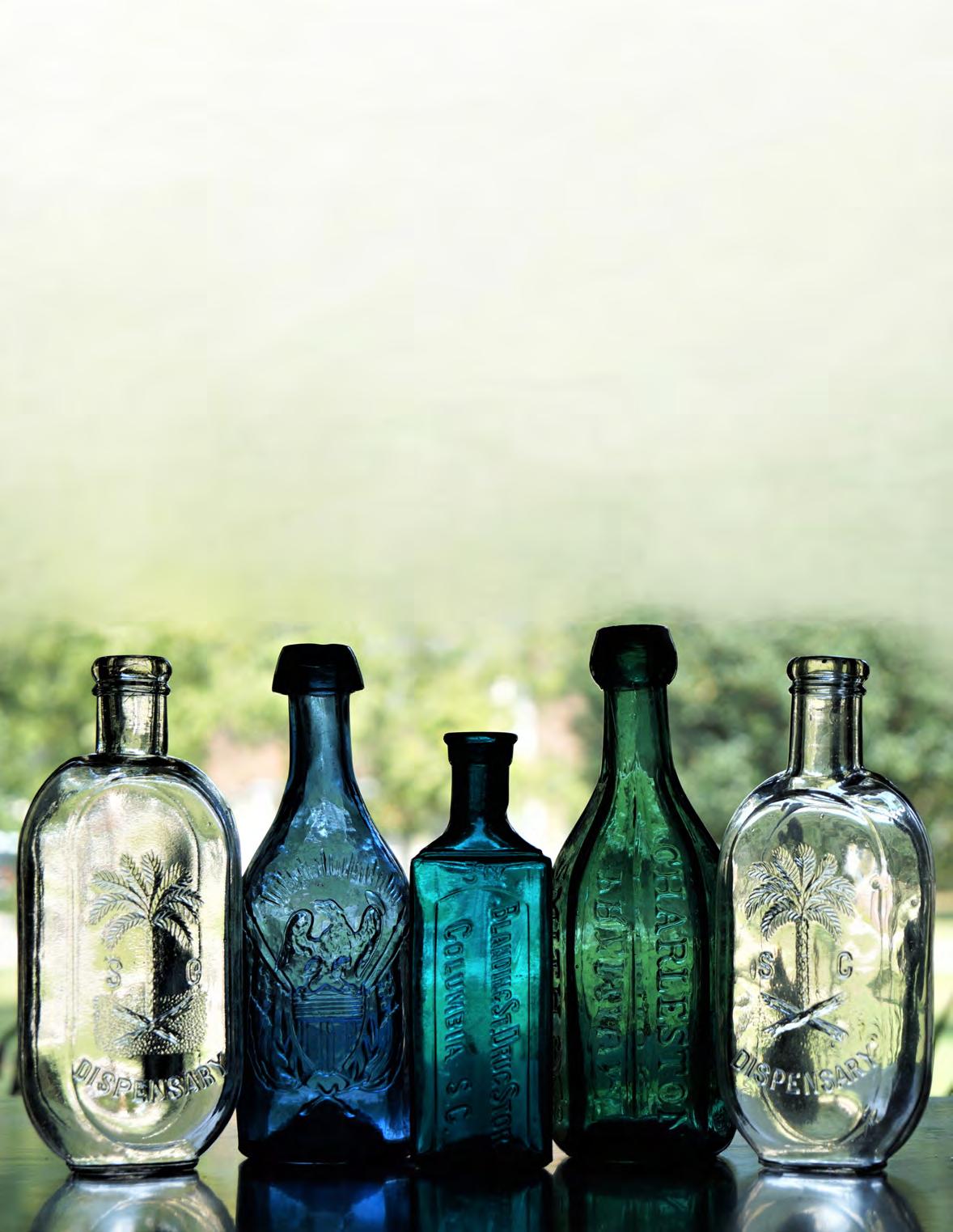


32 Antique Bottle & Glass Collector 50th Annual COLUMBIA, SOUTH CAROLINA BOTTLE CLUB SHOW & SALE Saturday, April 22nd 2023 Contact: Marty Vollmer 803.629.8553 or martyvollmer@aol.com or Art Gose 803.840.1539 or scbottlehunters@gmail.com or visit southcarolinabottleclub.com DONATION AT DOOR REQUESTED ONE DAY SHOW 172 TABLES LAST YEAR WITH ROOM TO GROW Jamil Shrine Temple 206 Jamil Road Columbia, S.C. 29210 Saturday: 9:00 am to 4:00 pm Dealer Set-up Saturday: 7:00 am to 9:00 am
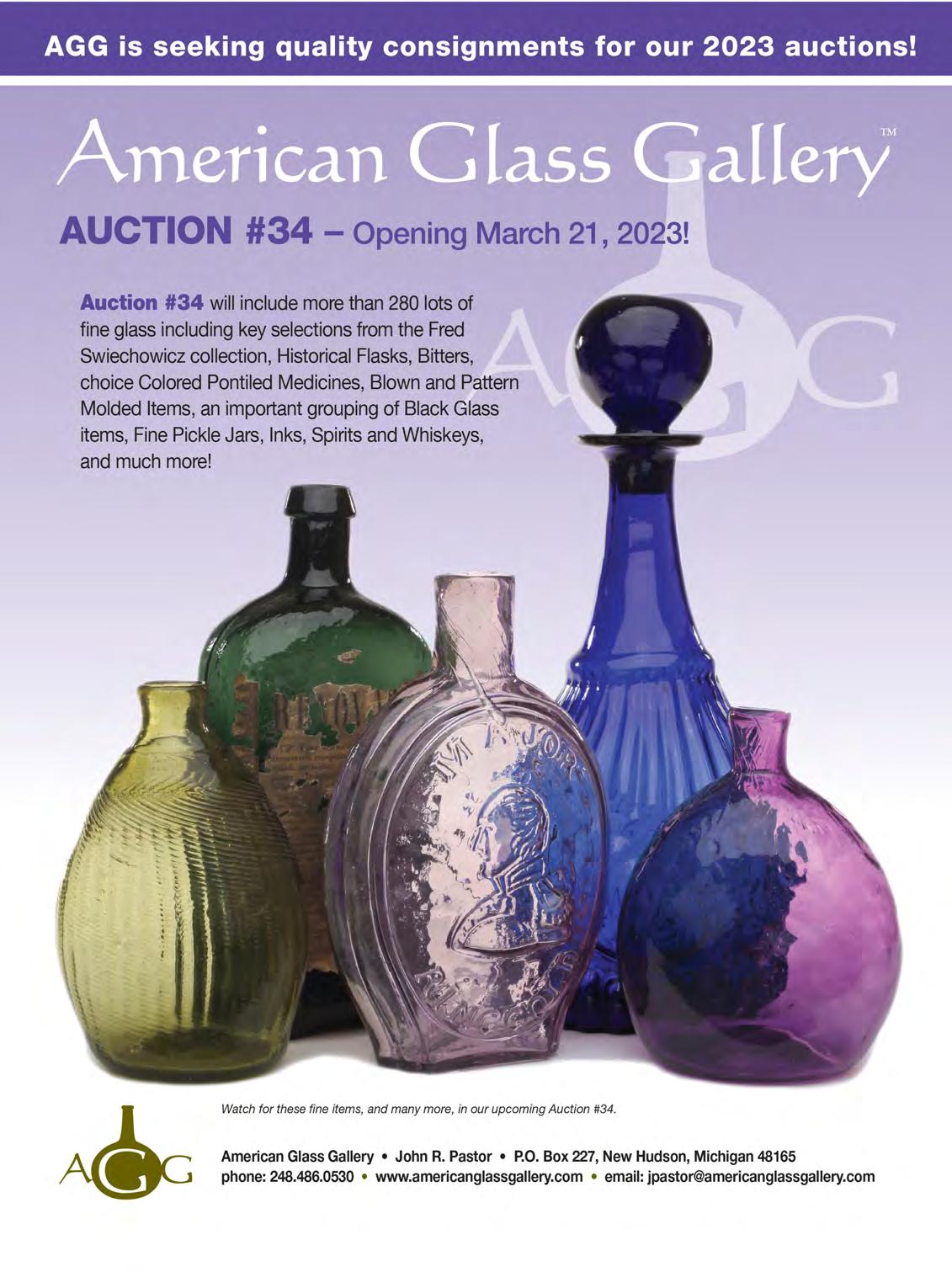
March – April 2023 33
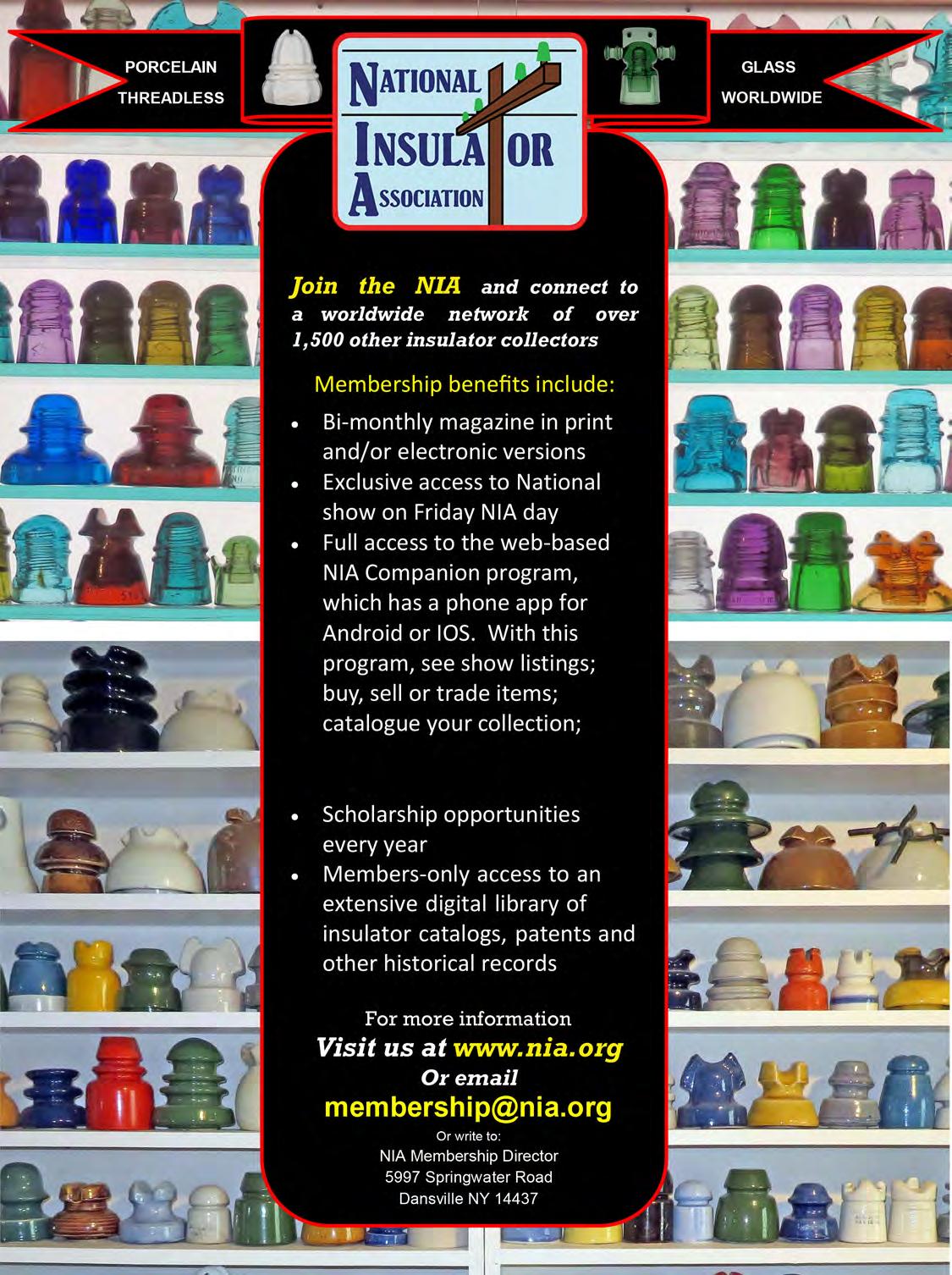



34
visit
Antique Bottle & Glass Collector
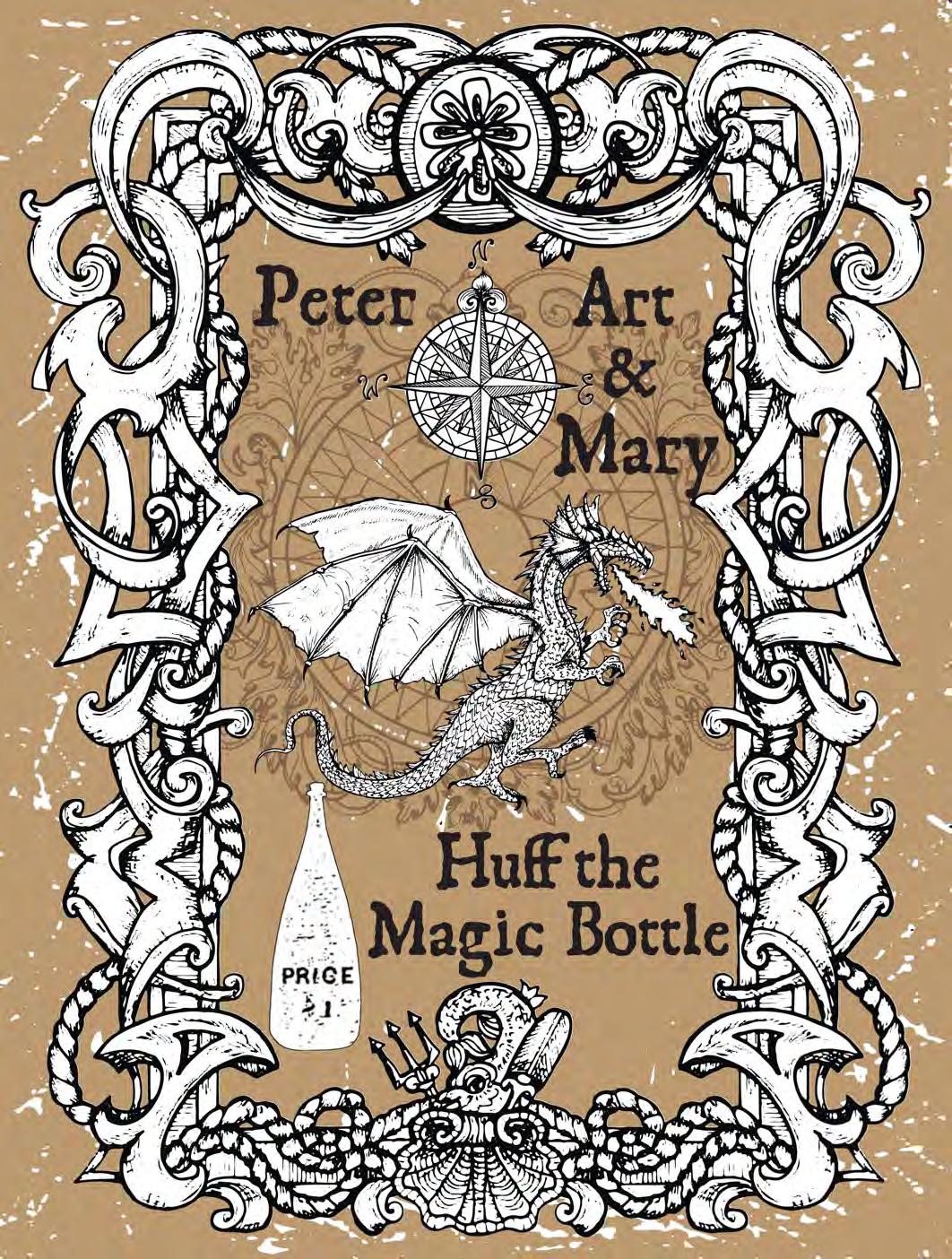
March – April 2023 35
PETER, ART & MARY Huff, the Magic Bottle, Lived by the Tree, in a Magic Land they call PRIVALEE.
By Peter Jablonski
What do you do when no one can go to the Mansfield, Ohio Antique Bottle Show with you? It’s a Friday, and you don’t want to go to work due to a bad case of Spring Fever. Well, you have to get your bottle fix on somehow, so you go privy digging. What better digging trio is there than... Peter, Art & Mary?

I connected with Mary Kummer of Geneseo, New York a few years ago on Facebook, requesting permission to dig, and she has been lining up approvals in Western New York ever since. You might say she also suffers from a chronic case of privy digging fever. She is brazen, bold, and not afraid to ask if we can dig up your privy.
* * *
Fast forward, I found the privy relatively quickly, and the best part was there was no sod that needed to be cut. It was shallow and the only bottles to come out were a slick pharmacy and the dreaded warranted flask that is like a kiss of death for the privy digger.
The house was circa 1850 in this Erie Canal town, so surely there had to be another privy on the
36 Antique Bottle & Glass Collector
DR. S. A. RICHMOND’S SAMARITAN NERVINE
18,714.—REMEDY FOR EPILEPSY AND OTHER NERVOUS DISEASES.—Samuel A. Richmond, Tuscola, Ill. Application filed November 14, 1890. Used since December 1, 1889. “The representation of a fountain, and landscape, the words ‘SAMARITAN NERVINE,’ and the motto ‘IN GOD WE TRUST.’”
THE TEMPERANCE FOUNTAIN
Trade-Mark. S. A. Richmond, for Dr. S. A. Richmond’s Samaritan Nervine. A Remedy for Epilepsy and other Nervous Diseases. No. 18,714. Registered Dec. 16, 1890.

Created / Published, 1890 Dec. 16. U.S. Patent Office trademarks (Library of Congress) Repository, Library of Congress Prints and Photographs Division Washington, D.C. 20540 USA

March – April 2023 37
PETER ART

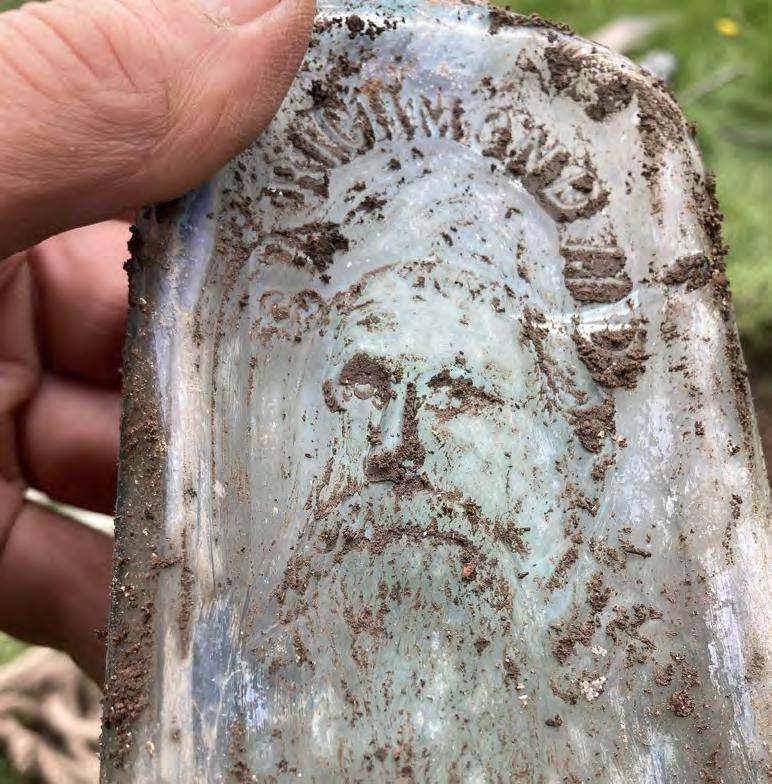
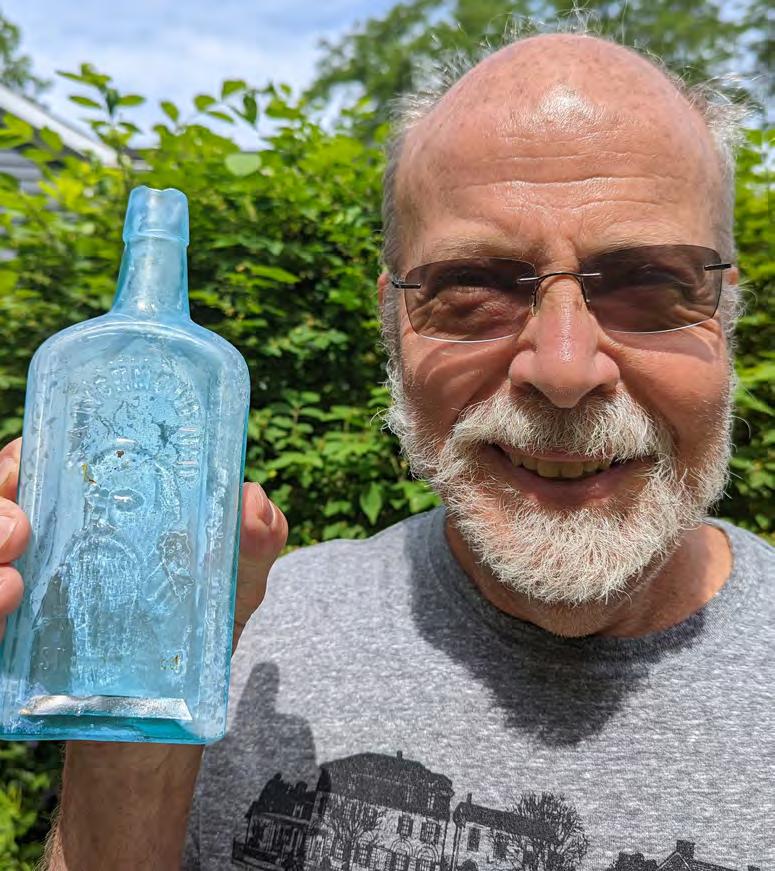
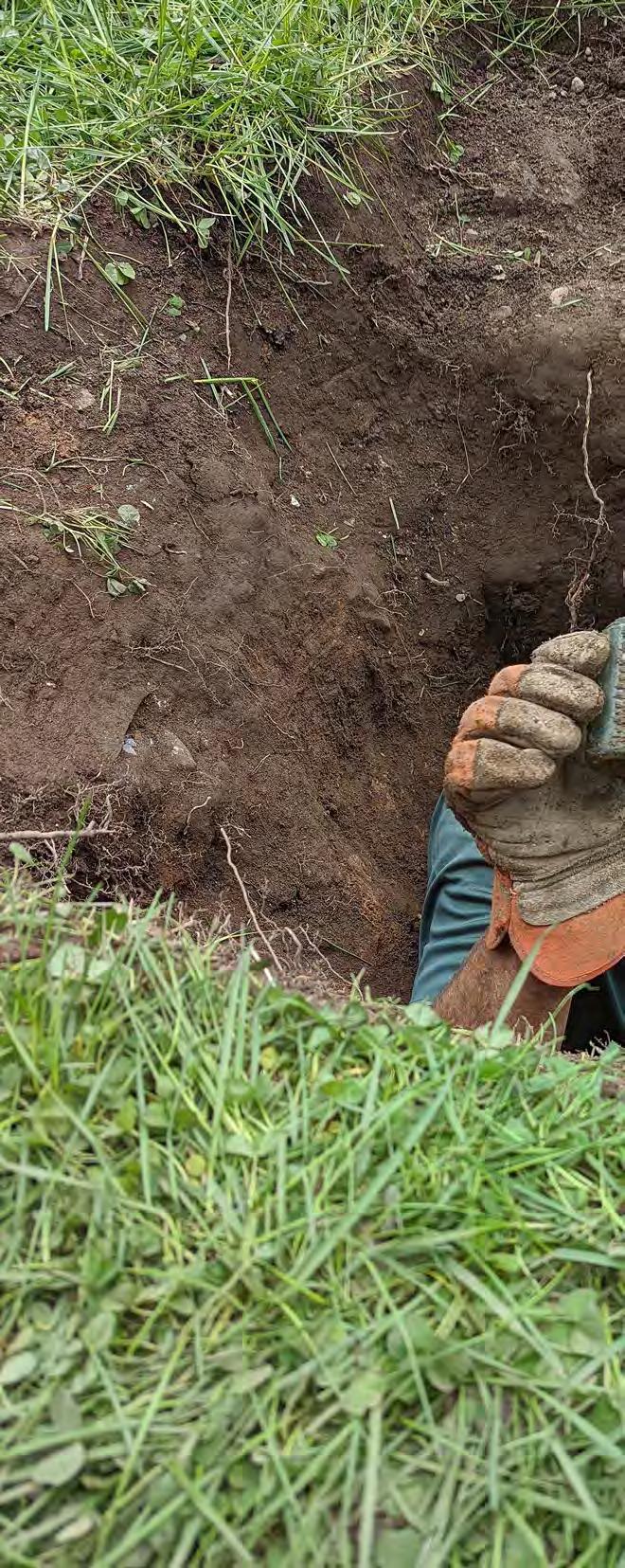
INTRODUCING
LEFT: Perhaps Art Ward hopes to grow his beard as big as Dr Richards!
Art Ward holds a Dexter fruit jar and bearded “Dr. Richard’s Samaritan Nervine. St. Joseph’s Missouri”
PETER & MARY


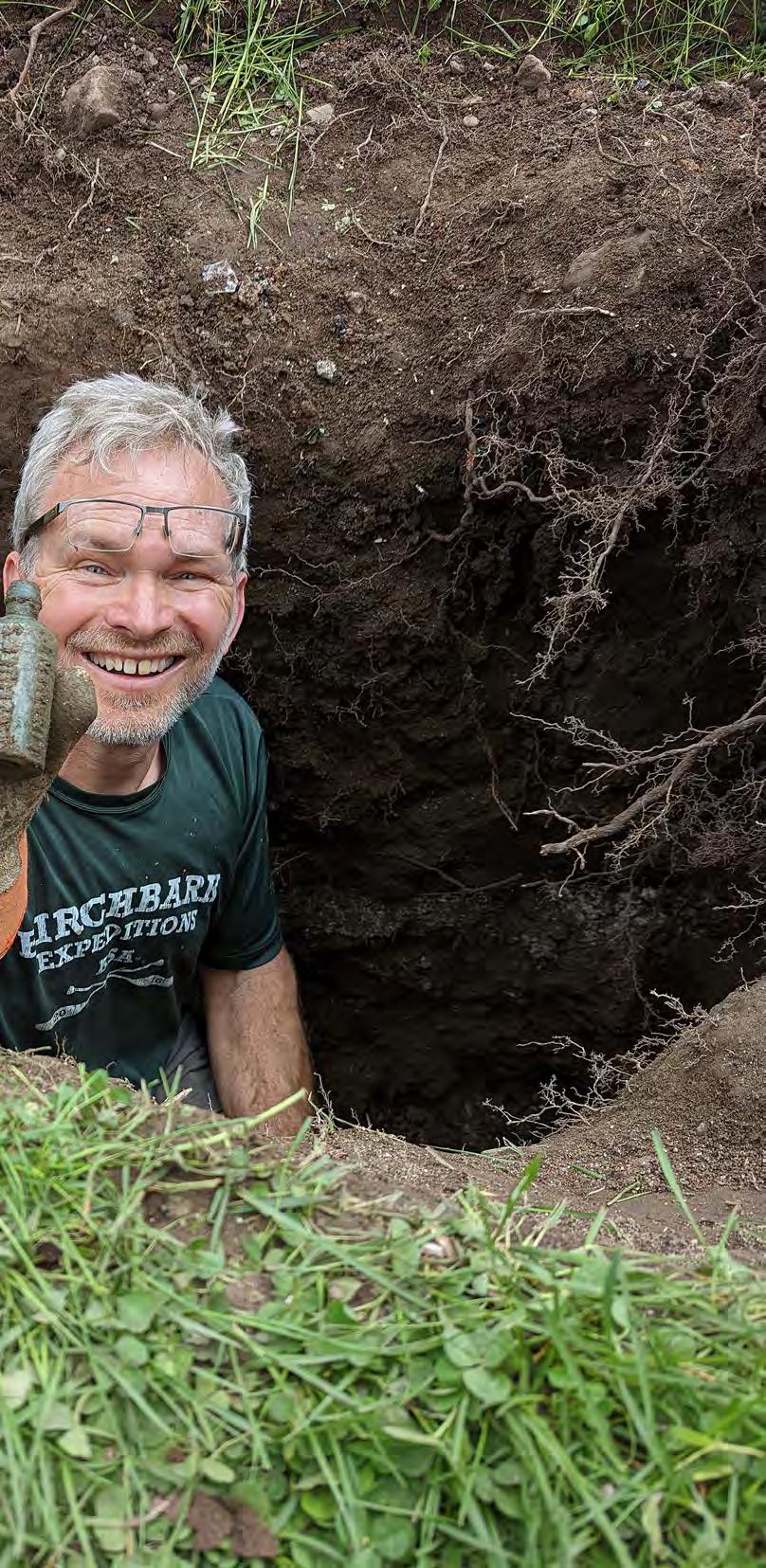
INTRODUCING
RIGHT: Mary Kummer holds a partially reassembled Cornucopia and Urn historical flask from the dig.
Peter Jablonski seems really happy about finding this “W. W. Huffs Liniment”
Mary Kummer pulled out another Dr. Richards bottle, but this one was not with the bearded image.
premises. I probed near a tree and I hit water and ash on the probe which in the spring is very common.
It will be a wet one for sure, as the groundwater table is high. Art Ward, my digging partner, and I pulled rock after rock and bucketed water, but there was no glass to be found in this pit, and the rocks made it dubious that this was even a privy.
Well, it was time to fill in and move to greener pastures. Mary had another permission lined up. She was really hungry to find some bottles and didn’t waste time in locating her first privy. The good news was the tip was bone dry. We had the sod cut quickly and were ecstatic not to hit any rocks. We started finding shards of wax sealer fruit jars, Buckeye and Dexter jars without bases but a nicely embossed wreath of fruit. Mary pulled out a tear-jerker shard of a Cornucopia historical flask. Art hopped in and, in no time, pulled a medicine bottle with an image of a bearded man whose beard was much larger than Art’s beard. It was a Dr. S. A. Richmond’s Samaritan Nervine from St Joseph, Missouri.
In his newsletter, The World’s Journal of Health, Dr. Richmond published testimonies from patients and their families about how miraculous this elixir was. Interestingly the main ingredient was belladonna, also known as deadly nightshade. This is a hallucinogen of huge proportions.


An advertisement from the 1883 Phoenix Herald reads: Cures epileptic fits, spasms, convulsions, St Vitus Dance Vertigo, hysterics, insanity, apoplexy, paralysis, rheumatism, neuralgia, and all nervous diseases. The infallible remedy will positively eradicate every species of nervous derangement and drive them away from whence they came never to return again. It utterly destroys the germs of disease by neutralizing the hereditary taint or poison in the system and thoroughly eradicates the disease and utterly destroys the cause. Cures female weakness, alcoholism, drunkenness and the habit of opium eating.

Dr. Richmond lived in an ornate home with his family. There was an elaborate fountain statue in the yard called “Venus Rising from the Sea.” At one entrance were two crouched lion statues, and at the south steps were two cocoa-colored elk with bronze antlers. The home had an eight-sided gazebo with winged arbors and a conservatory where the doctor housed the medicine factory.
Life for the Richmonds changed in 1886 when the managing editor of the St. Joseph Daily Herald, Col. James W. Strong, wrote something that apparently did not please the doctor. He got mad and went down and shot him, killed him dead, right in his office!
Dr. Richmond was tried and convicted, but he was determined insane, so he was committed to State Lunatic Asylum No. 2. Then he escaped. He basically left town and left his wife and five children. The doctor was never
40 Antique Bottle & Glass Collector
apprehended, but the elixir started showing up in a little town outside Chicago. The house they lived in is now said to be haunted by his daughter Clara Fannie.
Mary pulled out another Dr. Richards bottle, but this one was not with the bearded image.
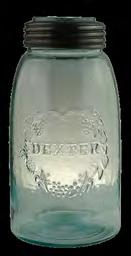

I had the pleasure of unearthing an aqua open pontiled “W. W. Huffs Liniment.” This bottle comes in a lovely Lockport green glass color as well. William Huff was a veterinary surgeon in Buffalo, New York, in the 1850s. His liniment was along the lines of Merchants Gargling Oil in that it was a “Cure for Man or Beast.”

In 1860 Dr. Huff moved his operations across the border to St Catharines, Ontario, Canada. In 1895 after the death of Dr. Huff, there was an injunctive court case started by his daughter against his uncle Mr. R. Huff who began selling R. Huff’s Liniment—the original Huff’s.

We didn’t let the first two pits of nothingness stop us from succeeding.

Privy digging keeps childhood dreams alive, searching and not knowing what treasures will be found. So let us keep Huff the Magic Dragon alive and not lose sight of our dreams.
LEFT: We started finding shards of wax sealer fruit jars, Buckeye and Dexter jars without bases but a nicely embossed wreath of fruit.
“DEXTER” / (Wreath of Fruits) “IMPROVED”, (SFJR, #334), Pennsylvania, ca. 1865 - 1875, aqua quart, smooth base. An example from the FOHBC Virtual Museum is shown on the right.
LEFT PAGE: “S. A. RICHMOND MD (embossed man and beard) ST. JOSEPH, MO, / DR. S. A. RICHMOND / ST. JOSEPH, MO.” aquamarine rectangular medicine. Advertisement: The Watchman and Southron (Sumter County South Carolina), April 18, 1882.

RIGHT: “W. W. HUFF’S / LINIMENT” (Odell, pg. 119), New York, ca. 1840 - 1860, aquamarine cylinder (they are also found in deep bluish green glass), 4 ½”h, open pontil, applied tapered collar mouth. This is the smaller of two sizes and both are equally rare. Looking at the advertisement at the upper right, there looks to be a third size! Certainly a different shaped bottle though. Advertisement: Detroit Free Press, November 29, 1847.

March – April 2023 41



42
Antique Bottle & Glass Collector



March – April 2023 43 St. Louis 53rd Annual Antique Bottle & Jar Show NO EARLY ADMISSONS March 19, 2023 9:00am - 2:00pm Adult Admission: $3.00 Child Admission: FREE $1 OFF With Flyer Refreshments Will Be Available Old Bottles Fruit Jars Pottery Breweriana Insulators & Advertising Orlando Gardens 4300 Hoffmeister Ave. St. Louis, MO Hosted By The St. Louis Antique Bottle Collectors Association Pat Jett (Showchair) 71 Outlook Drive Hillsboro, Mo (314)-570-6917 patsy_jett@yahoo.com There Will Be Over 115 Tables
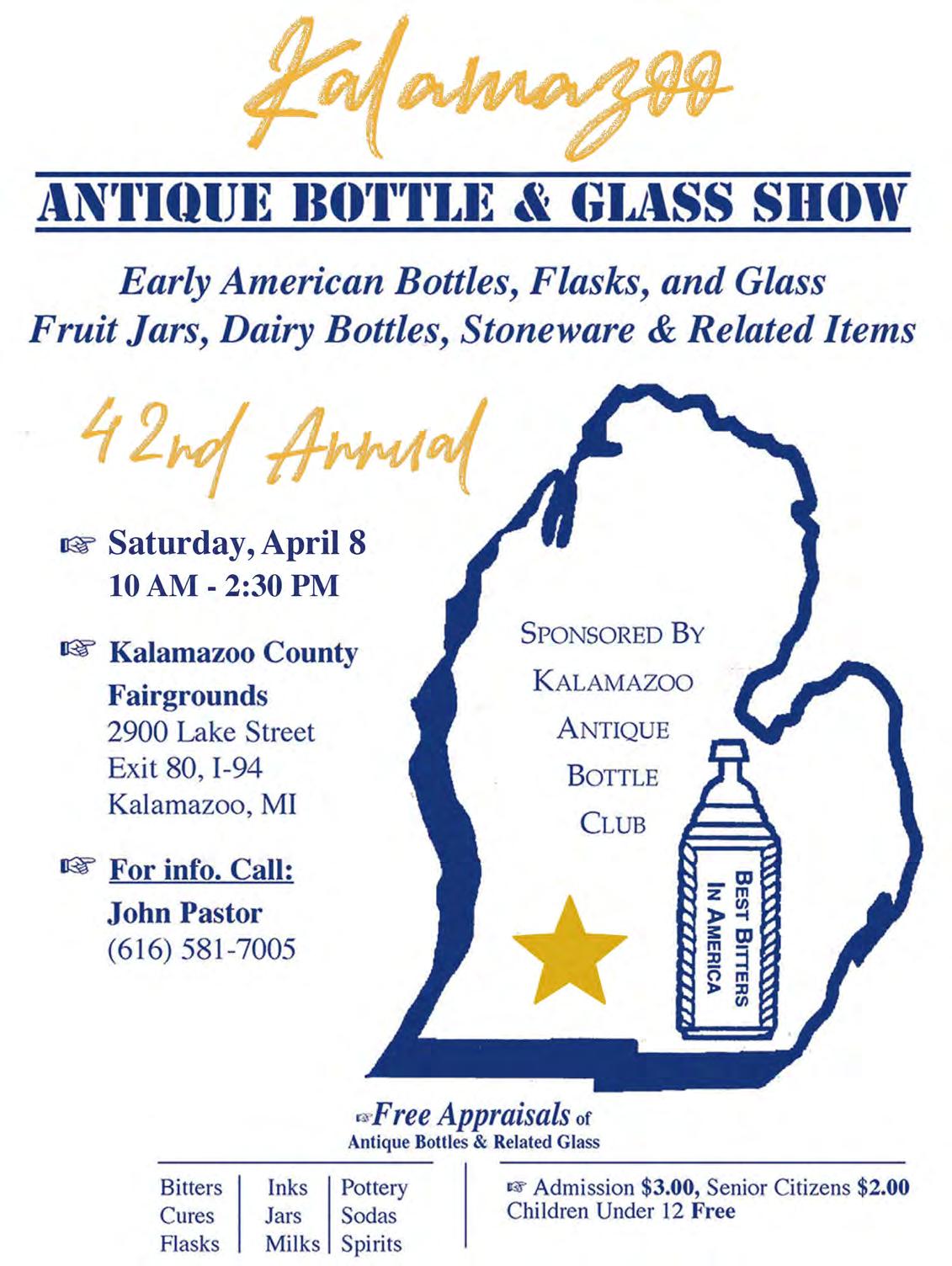
44 Antique Bottle & Glass Collector




March – April 2023 45
Knights’ Product Jar
By Barry Bernas
Figure 1 contains a photo of a decorative packer jar. It is just one example in a series of hand-blown or machine-made glass containers from different manufacturers with an elaborate outer design and a glass or metal screw or otherwise-fashioned cap that were made between 1890 and the 1920s.

Hand blown in a mold, this approximate quart-size edition is 6 1/16 inches in height (measured at the lip without the screw cap). Chrysanthemum-shaped eyelets on either side of the 1 1/2 inch tall glass screw cap with a swirled rib outer design serve as anchors for a wire-carrying bail. It has a base embossed with the inscription ALONZO A. KNIGHTS, BOSTON, MASS. See Figure 2.
Figure 3 illustration comes from a Specialty Glass Co. circa 1891-92 catalog, which was reprinted by the West Virginia Museum of American Glass, Ltd. in Weston, West Virginia. The caption accompanying this item indicated it was “entirely new” and could hold either 34 fluid ounces or 32 ounces of candy, preserves or something else.
Ancestry records indicate Alonzo Albert Knights was born on a farm in Irasburg, Vermont on September 4, 1841. He was the first child of Alphronus and Chole Stoddard (Robbins) Knights. Shortly thereafter, the family moved to the Boston, Massachusetts area. Alonzo grew up there and was educated in the public school system at Eliot Grammar and then English High School, where he was a meritorious Franklin Medal Scholar.
The 1860 United States Census recorded Alonzo as a 19-year-old clerk living with his parents in Boston’s First Ward. Beantown City Directories for 1863-1864 listed Knights but without an occupation. During these two years, a Boston newspaper identified him as registering for the draft. Subsequently, he enlisted in the Massachusetts 6th Infantry in July 1864 as a private. Upon his honorable discharge 100 days later, his occupation was entered as a hackman.
After his brief Civil War service, Alonzo likely went to the family farm in Woburn, Mass., and stayed there until 1868 when he married Sarah Little Knights, his cousin. The couple moved to Boston and Alonzo took employment as a clerk in Charles T. Hamblen’s plumbers’ supply business.
The 1870 Boston City Directory had Knights as a bookkeeper employed by Caleb Poole, Jr., & Co., a pickle manufacturer. Departing Poole in 1875, Alonzo took a position with John J. Richards & Co. (canned goods) up through 1877. While there, he met Nathaniel F. Mayo, a future business partner. The 1878 city directory showed him as a clerk back in the pickle trade with Caleb Poole. See Figure 4. When that business ran into financial trouble, Knights and Mayo formed and
46 Antique Bottle &
Glass Collector
[Figure 1]
Decorative packer jar.
ran the firm of Nathaniel F. Mayo & Co. in 1879, dealing vinegar and preserves from 12 India Square in Boston.


A year later, Knights and Mayo was established to manufacture and market jams and jellies from a 98 Board St. address. This partnership dissolved at some point in 1885. Mayo left and Alonzo created his own business—Alonzo A. Knights—making and selling jams, preserves, and jellies from the same Broad St. site in Boston. Figure 5 announced the change.
By 1886, Knights relocated his business to 10 India St., where it would remain through 1895. From late 1891 to 1894, Alonzo was also the manager-agent for the Boston office of the American Preservers’ Co., as Figure 6 illustrates. Note the location was the same address as Knights’ own business.
Up until 1893, Alonzo’s firm was listed in Boston City Directories as a maker and marketer of jams, jellies and preserves. Starting in 1893, bakers’ supplies and grocers’ sundries were also noted as concern products. That same year up to 1896, Knights was advertising bakeries for sale. Whether he owned them or was simply acting as a broker isn’t known.


On March 19, 1896, The Boston Globe announced Alonzo was taking on a partner, his son Harry. This action resulted in the formation and subsequent incorporation of Alonzo A. Knights &
Son (preserves, jams and bakers’ supplies) with a new business address of 89 Commercial St. in Boston. Knights stayed active in this father-son enterprise until health issues took charge. He died in 1899 at only 58 years of age. His sons continued the business for several decades to come.
Considering the above background information and the date of the Specialty Glass catalog listing, it is possible to estimate when this stunning product jar could have been used by Knights to package any one of his products. It seems sensible that between 1891 and 1896, Alonzo contracted to have his business name and location embossed on the base of this packer jar. I would lean more toward the earlier part of this estimate because beginning in 1893 and continuing through most of this decade, the Panic of 1893 severely hampered growth in the business trade.

Identifying what Knights put in his proprietary jar is more problematic because no example has yet turned up with a label. Later ads from Alonzo A. Knights & Son showed earthenware crocks, glass tumblers and Phoenix-style jars as containers for their jellies and fruit sauces. Clues suggest Knights’ product jar may have held preserves or some sort of baking ingredient. However, this is just a guess. The real answer may still be in hobby land, waiting to be reported.

March – April 2023 47
[Figure 4] [Figure 5] [Figure 6]
[Figure 2] Base embossed with the inscription ALONZO A. KNIGHTS, BOSTON, MASS.
[Figure 3] Illustration comes from a Specialty Glass Co. circa 1891-92 catalog.
Henry Hogan
New Westminster Soda Water Manufactory 1864-1879
B.C.’s First Soda King
Or was he? His obituary in the Mainland Guardian on October 22, 1879 (pg 3) said this:
“He was the pioneer manufacturer of Soda Water in California, as he afterwards was in this Province.”
That is not exactly correct, but without a doubt, Hogan was a true pioneer in the soda water business. The “first soda water manufacturer” title goes to Peter Brader and W. H. Emerson of the Pioneer Soda Works in Victoria due to their advertisement in the Victoria Gazette on April 16, 1859 (pg 1). No earlier evidence has emerged for any other contender, although Alex Phillips often (incorrectly) made the claim. Then again, the Phillips family also held (in his obituary) that he was the first soda bottler in California, contrary to the Hogan claim. The facts remain in doubt, but here is what we do know.
Henry Hogan moved to New Westminster in December 1864. At that time, the city was part of British Columbia, a separate colony from Vancouver Island. Thanks to an amazing photograph by photographer Frederick Dally (dating 1866-1870), Hogan’s soda water business can be seen in a corner of the image. Henry Hogan was more than familiar with the soda water business, having previously worked at the Union Soda Factory in San Francisco. In 1861-62, he also had a short-lived partnership making syrups with Alex Phillips. In 1864, when the Cariboo Gold Rush was near its peak, Hogan left Victoria to set out on his own in New Westminster, opening a liquor store there. There was also a sign above the door: “SODA WATER MANUFACTORY.”
Hogan established the first soda water business in the Colony of British Columbia, carrying on until his death in 1879, so he earned the title of “B.C.’s First Soda King.” If he wasn’t the first soda bottler in the Province of British Columbia, at least in New Westminster, he stood alone for more than a decade.
By Bill Wilson
Brought to AB&GC publication
by Eric McGuire
Looking upriver towards the Golden Ears, Hogan’s false-fronted building sits alone on Columbia Street. The telegraph poles, wooden sidewalk, wood pile and the Fraser River all add to a sense of the pioneering era in which the photo was taken.


48 Antique Bottle & Glass Collector
Close up of Hogan’s premises. The sign reads “SODA WATER MANUFACTORY Licensed Liquor Dealer.”
BCARS #E02199 Accession #HP80093.
BCARS #E02199 Accession #HP80093.
Early Life
Henry Hogan was born in Sydney, New South Wales, Australia, in 1835 to Irish parents. At just 17 years old, he boarded the British barque William and James, commanded by a Captain Colls. The ship set sail from Sydney Harbour, carrying a cargo of 322 tons of coal plus 25 passengers. After a voyage of 120 days via Tahiti and Honolulu, it arrived in San Francisco on July 29, 1852.* Henry was accompanied by John Hogan who, according to the family, is “P. J. Hogan.” This man would soon leave a permanent mark in the history of soda bottling in California as one of the partners in the Union Soda Water Factory.
*Rasmussen’s San Francisco Ship Passenger Lists, Vol 4, pg 55 – June 17, 1852-Jan 6, 1853
California
The Union Soda Water Factory is thought to have started in San Francisco in early 1851 after its founder, George C. Thompson, came to the city on September 22, 1850. It was located at Union Place, at the corner of Union near Stockton Street. The year that P. J. and Henry Hogan joined the firm is unknown, but both were listed with the Union Soda Water Factory along with Thompson in Lecount & Strong’s 1854 San Francisco Directory (pg 71 & 132).
Recently, a more precise date has come to light with the discovery of a terse announcement in San Francisco’s Daily Placer Times, starting January 11, 1854:
“Notice is hereby given that the partnership heretofore existing between George C. Thompson and the undersigned, has been dissolved since the 1st day of January 1854, and that the said Thompson has no longer authority to sign the partnership’s name to any paper whatever, or in any manner bind the firm.
January 11, 1854 – 3w Peter J. Hogan”
This announcement is significant as it dates the iconic cobalt blue “Hogan & Thompson, San Francisco” soda bottle. Given P. J. Hogan’s arrival in San Francisco, the earliest possible date is August of 1852, and the latest date is the end of 1853. The bottle is still considered one of California’s most desirable soda bottles and likely dates from 1852 to 1853.
Whatever happened to the Union Soda Water Factory under the management of P. J. and Henry Hogan is unknown. In California, business conditions were strong, and gold shipments were still increasing each year. Despite this general prosperity, by 1856, neither Hogan was working in the soda business. In the 1856 Colville San Francisco City Directory (pg 103), Henry was listed as
A stunning soda embossed “HOGAN & THOMPSON SAN FRANCISCO CAL” with “UNION GLASSWORKS PHILAD” on the reverse. Iron pontil on the bottom. R3. Photo courtesy Jeff Wichmann, American Bottle Auctions, who sold one bottle in 2011 for $4,200 US plus buyer’s commission.

A woodcut of Thompson’s Soda Works as it appeared in 1860. A worker in front of the building is loading the egg-shaped dispensers that held soda water. Reprinted from Bottles and Extras, Nov-Dec 2014, page 38.

March – April 2023
a shoemaker, and P. J. (now just “John”) Hogan was listed as a laborer, both residing on Dupont Street, a short distance from the factory. Meanwhile, Thompson had found a new partner for the factory.
His name was James McEwen, and the firm was now listed as “McEwen & Thompson, union mineral water” in the 1856 Harris, Bogardus & Labatt Directory (pg 76). That partnership lasted until 1860; Thompson and his family went on to operate the bottling works themselves for decades. Ultimately it became the longest-operating soda works in the history of San Francisco, ending around 1906.
What happened to Henry and P. J. Hogan? One version of the story was relayed by the family. They contacted an unnamed bottle expert who said:
“Peter and Henry were swindled out of their interest in the soda water business in San Francisco” –
(email to the author May 11, 2017, from Kathleen Crain)
Whatever happened, Henry Hogan, now in his early twenties, began to look elsewhere for his future. As for P. J. Hogan, he died in San Francisco on April 2, 1862 (San Francisco Evening Bulletin). Another obituary provided a little more detail:
“Died…Peter J. Hogan, a native of Ireland, aged 43 years”
(California Farmer and Journal of Useful Sciences, April 4, 1862)
This notice suggests that Peter J. Hogan was an older relation of Henry Hogan, not a sibling. Being much younger, Henry still had his adult life in front of him, and by 1862 he was long gone from California.
British Columbia
The Fraser River Gold Rush brought thousands of gold seekers in 1858, and Henry Hogan was one of the hopefuls, according to his obituary (Mainland Guardian, October 22, 1879, pg 3). How he did and where he went during those early days are unknown. He surfaced again in 1860, when “Henry Hogan from Australia,” age 23, was enumerated in the United States Census at Port Townshend, working as a chemist. The age is off by a year or two, but the other facts all match—his name, country of birth and occupation (early soda bottlers crossed over as druggists and vice versa—for instance, Thomas Shotbolt).
“H. Hogan” was also listed as the agent for the British Weekly Colonist newspaper at Port Townsend from November 21, 1860, to August 7, 1861 (pg 1). At the time, crossing the border for work was much easier than it is today. By 1860, Henry had done well, reporting a substantial sum of $1,000 of personal property to the census taker.
On January 13, 1862 (pg 3), the British Colonist in Victoria noted that Henry Hogan had returned on the steamer Brother Jonathon after visiting San Francisco. A month later, the same paper carried
an ad for “Phillips, DeYoung & Co.” selling various types of wines, rum, gin, brandy and other liquor. At the end of the ad, in tiny print, it also noted that they were the Sole Agents for “Phillips and Hogan’s syrups.” Since Hogan left Port Townsend in August 1861, he likely started the partnership with Phillips in the latter part of that year. It was a short partnership—on April 21, 1862 (pg 2), the British Colonist first advised that the partnership

Phillips & Hogan Syrups; British Colonist March 5, 1862, pg 1. The “Phillips” partner with DeYoung wasn’t Alex Phillips; it was Moses Phillips, a bona fide character and jack of all trades—ship captain, trader, furrier and a man of many other ventures, some not exactly legal. In 1863 he was refused a liquor license in Comox, and in 1865 he was sued by the purchaser of one of his ships after it was seized by U.S. customs for infraction of liquor laws. The purchaser claimed that Captain Phillips was aware that it could be seized when he sold it. Phillips went to “Stickeen River” Gold Rush in 1865 carrying supplies to the miners, only to have his ship plundered by the First Nations. He died in 1866 and that same ship, the Nanaimo Packet, was auctioned off.
Phillips & Hogan go their separate ways. British Colonist, April 21, 1862, pg 2 (New Advertisements)

50 Antique Bottle & Glass Collector
had been dissolved, with Phillips carrying on the business.
In 1863, Hogan was still living in Victoria according to Howard & Barnett’s Directory (pg 66), residing on Herald Street along with a W. J. Hogan. There was no mention of what he did for a living. However, on November 18, 1863 (pg 3), the British Colonist reported that “H. Hogan” & “D. Hogan” had returned to Victoria from San Francisco on the steamer Sierra Nevada.
Henry Hogan was about to make some major changes in his life. On December 11, 1864, Henry Hogan, now 29 years old, married Mary Powers, age 15. The ceremony was conducted at the Roman Catholic Diocese in Victoria, the document noting that Henry and Mary were “both of New Westminster.”
Like Henry, Mary was born in Australia, came to California and then went to British Columbia in 1858. Her father, Robert Power (the ‘s’ was apparently added when the family left California), was born in Ireland and sent on a convict ship to Australia in 1832. There he married Mary’s mother, also named Mary (the family believes her maiden name was Chambers). Their firstborn, William Powers (1844-1907), was born in Sydney. He was called “Uncle Billy,” the glue that held the family together*. Mary was born in 1849 in Sydney, and her younger brother John (18581883) was born in San Francisco.
*(email to the author May 26, 2017 from Kathleen Crain)
Six days after the wedding in Victoria, Henry & Mary prepared to move their belongings to the capital of British Columbia, where they would begin a new life together. During the move, Henry ran into a problem, a costly one that required him to write a letter:
“New Westminster
December 17, 1864
The Honble.
The Colonial Secretary
Sir:
On Monday last, I purchased in Victoria – a few articles of furniture for my own use, and intended to have brought them with me on the following day to New Westminster on the Steamer Otter, but in the busy going away I had to leave them to be brought by the next boat. Last morning they came by the Otter. Had they been brought with me, no duties would have been chargeable, they being for private use. I take the liberty of asking his Excellency for government consideration to this case, and that His Excellency will authorize the Collector of Customs to remit the duty in my favor viz. The amount of nine dollars and eighty cents ($9.80) as the things are for my private use and for no other purpose.
I have the honor to be your most obedient servant, Signed,
Henry Hogan
Mr. Hamley suggested my writing to the governor in the manner I have done.”
This letter shows one disadvantage of living in New Westminster at the time. Governor Douglas declared Victoria a free port
in 1860, meaning Hogan’s items were subject to customs duties (British Columbia was still its own Colony in 1864). Fortunately for Hogan, the Customs Collector, Wymond Hamley, supported him with a letter a few days later:
“This man went to Victoria I believe to buy a few articles of furniture & came back by some accident without them. I think, under the circumstances of this (illegible) is pleased to allow it, that the duty might be returned to him.
Customs House
W. Hamley
December 21 1864”
A week later, he received good news—the duties would be repaid. Encouraged, he tried again the next year. This time Hogan bought a cask of brandy in Victoria and brought it to New Westminster under bond on December 28, 1865. When he took it out of bond two months later, he discovered that the duties on his cask would be subject to a new Customs Bill. He wrote to Victoria again on February 17, 1865, asking whether the duties should be charged under the old or new law. A prompt reply came back ten days later—the new law “was in full force,” and Hogan had to pay the higher duties.
Henry Hogan’s only other letter to Victoria is perhaps his most interesting. This time, he teamed up with his old partner Alex Phillips:
“New Westminster B.C.
To: The Hon. A.N. Birch
Colonial Secretary
British Columbia
Sir:
Will you be kind enough to draw the attention of His Excellency to an unfairness in the Tariff. Confectionery is to be charged 30 per cent. There are only one or two confectioners in the Colony. On Syrups it is proposed to charge 12 ½ per cent, only. There are three Syrup manufacturers in the Colony.
We could supply all the syrups required for the Colony, we think there is a heavy duty on refined sugar from which we manufacture our syrups. The duty on imported syrups is not in comparison therewith sufficiently high to enable us to compete with the imported article.
We therefore beg that you place these facts before his Excellency, hoping the subject may meet with his consideration.
We are Sir
Your
Most Obedient Servants
H. Hogan New Westminster
A. Phillips Fort St Victoria”
The letter is intriguing. First, it has the signatures of two of the most significant pioneer soda bottlers in British Columbia —the Phillips signature exactly matches those scratched onto so many of his early blob-top sodas. Second, even though the 1861-62 partnership began and ended quickly, there were no hard feelings, and they continued to work together in areas of common interest.
March – April 2023 51
Third, the letter confirms that there were only three Syrup manufacturers in the Colony in 1866 when the letter was sent—so who was the third? Paul Bocion is perhaps the most likely, but did Thomas Shotbolt start up earlier than is known? The answer is still to come. Lastly, if his liquor business paid the bills, it is also clear that his soda water manufactory was also an important part of Hogan’s livelihood.
Hogan and Phillips didn’t receive a reply from the Colonial Government, but an internal note was attached to the file that indicates a lack of success for their plea:
This seems hardly worth postponing his preparing this tariff bill for.
(Unreadable initials) March 22, 1867
Col. Sy. I think not
(Unreadable initials)
From: Colonial Correspondence; GR 1372.776 BCARS.
Family and Business
Henry and Mary Hogan started their family in 1866; in March, they welcomed their first child, Thomas William Hogan, called “Doc” by the family (email to author Kathleen Crain, June 4, 2017). Their daughter Margaret Jane was born on October 12, 1867, Robert Edward arrived on March 13, 1870, and Mary Ellen was born on February 28, 1873. Sadly, Mary’s mother died on June 24, 1866, a few months after her grandson William was born. She was just 44 years old.
In 1866 times were generally hard in British Columbia—the Cariboo diggings were in decline, the Big Bend stampede was a bust and many were deeply in debt.* However, the Hogan and Powers family were in good shape. Mary’s brother William Powers, a carpenter, built the Telegraph Hotel. It was named after British Columbia’s first mega-project, the Collins Overland Telegraph, based in New Westminster, built between 1865 and 1867. William came to British Columbia during the Cariboo rush, then went to New Westminster where he worked for the telegraph company.** The Powers family likely built the hotel during this time.
“Mary’s father and mother owned and operated the Telegraph Hotel on Front Street and Hogan built his soda water manufactory on the same parcel of property. Later a rather charming-looking family home was built. All the buildings were on a parcel of land that lay between Front Street and Columbia Street right at the foot of Fourth Street” ***
* (Vancouver Sun, August 6, 2016, page A3)
** (Vancouver Daily World, January 7, 1907, page 15)
***(email to the author October 6, 2010 from Nelson Oliver).
Although Hogan initially sold hard liquor, he also became an agent for a pair of Victoria breweries. In the 1860s, he sold “ale that is not stale” from Arthur Bunster’s Colonial Brewery, and in the 1870s, he carried Charles Gowen’s “celebrated ales” from the Phoenix Brewery.


As the Cariboo Gold Rush subsided and the huge Collins Overland Telegraph project was canceled in February 1867, an inevita-
ble downturn hit New Westminster. Yet Hogan seemed to thrive. He and Mary had two more children (Robert Edward and Mary Ellen) between 1870-73, and on September 19, 1872, he took a preemption on 160 acres “on the South Arm of the Fraser River,” according to the BC Gazette summary that year.

In 1874, Hogan opened the Terminus Hotel in Moodyville. Somehow, he had obtained a liquor license even though the mill’s owner, Sue Moody, had been able to keep the mill “dry” since it began in 1865. Hogan attempted to transfer the license when it

52 Antique Bottle & Glass Collector
Circa 1865 view of New Westminster with the “Telegraph House” on Front Street circled; Hogan’s Soda Water Manufactory on Columbia Street is located behind. Photo courtesy New Westminster Public Library
A rare view of the Hogan Family dwelling, and possibly the factory, courtesy Kathleen Crain who believes it dates to the 1870s, prior to Henry Hogan’s death.
Drink Bunster, Agent, H. Hogan, The British Columbian, July 3, 1867, pg 3.
H. Hogan Agent For, The Mainland Guardian, September 12, 1870, pg 4.
came up for renewal to a man named Briggs. This time, Moody successfully objected on the grounds it would:
“likely induce drunkenness amongst the Indians. The license was refused, and once more, Moodyville was without alcohol.”*
*Page 141, The Enterprising Mr. Moody, the Bumptious Captain Stamp, by James Morton (1977)
There were other setbacks during this time. In November 1872, Hogan was successfully sued by his former partner, Alex Phillips for $72.89 plus costs (British Colonist, November 6, 1872, pg 3), more than a month’s wages at the time. In 1875, unable or unwilling to come up with the funds to pay for required improvements on his Fraser River preemption, the 160 acres of Fraser River waterfront reverted back to the province (BC Gazette, December 11, 1875, pg 280). Hogan’s name was just one of many on that page.
The most serious was a fire that started on Front Street on August 29, 1875, that nearly consumed Hogan’s home and business. The Mainland Guardian, Hogan (and his insurance company) were impressed by the Hyack Fire Company’s response: (September 1, 1875 pgs 2 & 3):
“they cut off the fire from the dwelling of Mr. Hogan which at one time appeared to be in the midst of the flames and already impossible of escape...it was saved intact...Mr. Hogan will lose more or less by loss of furniture from hasty removal. A remarkable preservation of his property could hardly be credited by anyone but the witness. The gallantry and indomination of the Hyacks is deserving…”
It was a close call. Hogan immediately placed a “CARD OF THANKS” to the Hyack Fire Company:
“and the citizens who so heartily aided them, for their very gallant conduct at the late fire on Front Street, by which my property was saved from destruction. H. Hogan.”
But soon, there were more challenges. Mary’s father, Robert Power, passed away the following year on April 16, 1876, at 65 years old. His obituary noted that he had arrived in British Columbia in 1858 and held property in Victoria and New Westminster. He was survived by Mary and her brothers, John and William. John Powers, just eighteen, would soon manage the Telegraph Hotel. Meanwhile, in 1878 Henry Hogan ran for office as a New Westminster city councilor. He was a popular choice, well respected by the business community and was elected. (Mainland Guardian, January 16, 1878, pg 3).
End of an Era – Henry Hogan Passes Away
Time was running out for the soda bottler, and Hogan seemed to know it. On July 16, 1879, not feeling well, he decided to make out his will. Henry’s main concern was the soda water business. William (“Doc”) was only 13 and Robert was just nine years old, and he worried they were too young to run the business. He approached James Wise and Charles McDonough, who had similar backgrounds as Hogan—Catholic, Irish merchants with successful establishments (clothing and dry goods) on Front
Street. Henry considered both men his friends and named them his executors in the will.
Henry’s health continued to decline after making out the will. Three months later, after “ailing for some time” (Mainland Guardian, October 18, 1879, pg 3), Henry Hogan passed away on October 17, 1879, of heart disease. He was just 44 years old. The Mainland Guardian (October 22, 1879, pg 3) summed up his life and character:
“he was of a kindly, good-natured disposition, and much esteemed by all who knew him…the funeral procession clearly indicated the high respect in which he was held. It included all the old residents, who evidently looked upon him as one of themselves.”
In his will, Hogan gave fifty dollars to the Roman Catholic Church “for masses for my soul.” Mary (and her brother William) had already inherited the Telegraph Hotel on Front Street, so Hogan gave her Lot 1, Block 9, likely their home, “for her sole and only use forever” (it was on Richards Street, which later became part of Columbia Street. The house was close to the Fraser River and eventually was absorbed by John Hendry’s Royal City Planing Mills. (For Will, see GR1052, #2971, B8949 – 12 pages)
The rest of the estate was to be divided up equally between the four children after they turned twenty-one, with one exception. The executors were to carry on the soda water business to support the four children, and when William and Robert were:
“of sufficient age in the opinion of my said Executors to conduct the business it is my wish that my said two sons jointly assume the management of the said business for their sole use and benefit.”
The will had no mention of real estate on Columbia Street, where the soda water business was located, confirming the family’s belief that it was on the Powers property. Henry owned the business but not the property. This soon became an issue.
Executors James Wise and Charles McDonough asked creditors and debtors to settle their accounts with Hogan’s Estate by January 18, 1880 (Mainland Guardian, November 26, 1879, pg 2). At that point, a decision had to be made as to how to carry on the soda water business for the coming year. Real estate agent James Morrison was engaged to find someone to lease or buy the business as a going concern. With no land being sold, he came up with a novel idea, noting:
“in view of the early construction of the railway, presents a unique opportunity for making a rapid income.” (Mainland Guardian, January 28, 1880, pg 3)
Claiming that a fast dollar could be made off the CPR construction crews didn’t work, and several more months went by. Finally, on May 22, 1880, with the busy season about to begin, Mary Hogan took charge, even though Henry’s Executors were supposed to be making the decisions. She placed an ad noting that the business was no longer available for lease.
March – April 2023 53
The New Manager
The New Westminster Soda Water Factory had a new manager from June 1880 to August 1882, believed to be Murdoch Duncan McLennan. McLennan came to British Columbia from Nova Scotia in 1878 and was 39 years old. His real occupation was a ship captain, but he was enumerated in the 1881 census as a “Soda Water Maker” in New Westminster. Since there was no other soda water factory in town, he was likely the “experienced assistance” Mary Hogan engaged.
Mary Hogan was fortunate to find McLennan, as she had her hands full. Back in January, she had already taken charge of the Telegraph Hotel, the family’s main source of income. Her ad in the paper noted:

“the above popular Boarding House is now under her own control and management. She asks a continuance of the patronage which has always been accorded to the house, which she will endeavor to merit by strict attention to the comfort of her guests.”
(Mainland Guardian, January 7, 1880, pg 3)
This ad was interesting—it begins with “Mrs. Hogan” and ends with “Mrs. Mary Powers, Proprietress,” perhaps hoping to show her connection to the Powers family. Mary had taken over the hotel from her brother John, who had managed it the previous year at just 21 years old.
In May 1880, Mary was involved with the soda water business and managed the Telegraph Hotel, but there was one other complication—she was about to give birth again. Her son John Frederick was born the same month she took over the soda business and only seven months after Henry died. Her brothers William and John Powers were there to help, but one can only admire her ability to cope with all this—mother of four children plus a new-
born baby, all while managing two businesses. Remarkable.
The next year, Mary had another child, a daughter named Laura May, born on June 24, 1881. She obviously had met someone else, but the father was not named on the birth certificate. Laura May was given the last name Hogan. The 1881 Census described Mary’s occupation as Hotel Keeper, living with five children (Laura May was not yet born), plus William and John Powers.
Mary Hogan managed the Telegraph Hotel and held the liquor license for the next decade. It was rare for a female to hold a liquor license in those early days. In 1884 a list indicating all the liquor license renewals in the Lower Mainland (from Moodyville to Delta and as far as Whonnock) was published. Of the 39 licenses, only two were held by a woman. (British Columbian, November 26, 1884, pg 4).
Soda Water Factory Sold
Between June 1880 and August 1882, Mary Hogan transferred the soda water business to J. G. Jaques, a wealthy New Westminster real estate investor. Jaques later modestly described himself as:
“one of the largest property holders in the city” (Daily British Columbian January 30, 1889, pg 4)
Parting with the factory was definitely not in keeping with Henry Hogan’s will—he had asked his Executors to keep the business going until sons William and Robert were ready to take it over. Possibly financial pressures played a part in the decision. Jaques was no bottler, so it seems likely that he didn’t own the factory very long before selling it to Alex Phillips in August 1882.
After Henry & Mary
Free of the soda water factory, Mary carried on as proprietor of the Telegraph Hotel. However, she began running into financial difficulties that would follow her to her death. Sick with Nephritis, a painful kidney infection, she died of arsenic poisoning on June 18, 1892, at 42 years old. The Daily Columbian paper reported on June 20, 1892 (pg 4):
“By the death of Mrs. Hogan, of the Telegraph Hotel, on Saturday afternoon, another vacancy is made in the thinning ranks of the early-day settlers. Mrs. Hogan was especially well known to navigators of the river and gulf, and her hospitable manner won her many friends. Out of respect to the deceased, flags were at half mast yesterday and today on the steamboats and several buildings. Mrs. Hogan organized the first choir in the R.C. church in this city, of which she was leader for some years...a family of six children mourn her loss.”
Now it was up to her sons William and Robert to step in and manage the hotel. Mary had left no will and a substantial debt. There were 33 creditors from New Westminster to Victoria, and some were “threatening to sue for the amounts due them” (GR 1304 #1261). Even former soda bottler John Mahrer from Nanaimo wanted his liquor bill paid quickly.
54 Antique Bottle & Glass Collector
Soda-Water and Ginger Beer Manufactory ad. The Mainland Guardian, May 22, 1880, pg 2
Her son William (Doc) Hogan petitioned the court to permit the four oldest children to sort out the estate, which had debts of $2,967.85. Fortunately, the Hogans found an investor, William Booth of Ladner’s Landing, to lend them $3,000 to pay off the debts. A mortgage was secured against two small acreages that Mary still held on Sixth Avenue (Lots 2 & 3, Block 9, New Westminster Suburban Lands) and the house on Richards Street that Henry Hogan had bequeathed to Mary.
Mary’s younger brother, John Powers, passed away on June 11, 1883, just 25 years old, but her older brother, William Powers, “Uncle Billy,” was always there to steady the ship. He was later recalled as:
“The mainstay of the family and remarkable man. He was an Anglican and a Mason. He bought the family plot in the cemetery which accounts for all the Catholic Hogans being buried in the Masonic section of the cemetery.”

*(email to the author May 26, 2017 from Kathleen Crain).
Mary’s estate took the better part of a year to sort out, but by September 23, 1893, her sons William, age 27, and Robert, 23, began running ads in “the Pacific Canadian” under the “Hogan Bros.” banner, once again pointing out the Telegraph Hotel’s choice location opposite the Fraser River ferry landing. These ads ran until May 1894, even with a Depression going on that year.
In December 1894, while he was tending the bar, Robert wound up getting shot in the leg while trying to break up a fight among two patrons. The bullet narrowly missed his femoral artery which would have killed him (Vancouver Daily World, May 16, 1895, pg 8).
Other scrapes at the hotel were reported in the papers in the years that followed, all part of the rough and tumble life of running a hotel with a liquor license in the frontier days of New Westminster. When times were slow, there was always work on the Fraser—in 1897, William Hogan was listed as a deck hand in the directory, Robert was a fisherman, and Fred worked as a steamboat man. Later he became a master mariner and tug captain.
The sons carried on, but like their father, Henry, none would live past 50. William, the eldest, was the first to pass on June 19, 1901, age 35, of Bright’s Disease. Fred, the youngest, was next. He died September 4, 1906, at age 26, of “strangulation while vomiting” in his cabin on the tug Stranger. Robert lived the longest, passing on January 16, 1917, at 46 from pneumonia.
Between 1895-99, all three daughters of Henry and Mary Hogan married ship captains working on the Fraser River. Laura May’s husband, C. F. (Fred) Mayers, signed his place of birth on the marriage certificate as “Gastown, Vancouver.” Born about 1873, thirteen years before the city was incorporated, he was a true pioneer. Margaret’s husband, Lyman H. Ford, was described as “senior Fraser River pilot and Pacific coast navigator for 40 years.” He left a substantial estate to her when he died in 1930. (Vancouver Sun, April 26, 1930, pg 14). All of the Hogan offspring stayed in the Lower Mainland, but the daughters had longer lives—Mary Ellen passed in 1931 at 56 years old, Margaret died in 1946 at 78, and Laura May died in 1957 at 76.
As for the Telegraph Hotel, address 375 Front Street, it was sold in June 1896:
“James Brennan, late of the Occidental hotel, has re-opened the Telegraph hotel on Front Street, recently purchased from the Hogan estate.” (Vancouver Daily World, June 8, 1896, pg 5)
The next year “Uncle Billy” Powers turned his hand to boat building, but he must have kept a part interest in the hotel, as in 1900-01, he was again listed as the proprietor. By 1905 Albert Peters, Mary Ellen Hogan’s husband, had joined Uncle Billy as proprietor, and Robert Hogan was back as a bartender.
However, the old hotel was starting to show its age, now almost forty years old. The liquor license inspector reported to council that the Telegraph hotel building “was very old and dilapidated” (Vancouver Daily World, December 22, 1905, pg 20).
Uncle Billy asked the council to renew the license for a full year. After a lengthy debate, he was given six months, during which time a new building must be erected. The writing was on the wall, and the building was torn down. A new hotel called the “Premier Hotel” was built in 1906, further up the same lot, now facing Columbia Street instead of Front Street (New Westminster Public Library website, photograph #155). Uncle Billy, the mainstay of the family, passed away on January 7, 1907. His obituary and the documents at BC Archives say he was 62, but the headstone at Fraser Cemetery shows that he was 64 years, five months old. As that is more precise, likely that was his correct age.
As for the fate of the Hogan family home on Columbia, a photo shows it still there in 1910, (New Westminster Public Library website, photograph #1870), now surrounded by many other buildings. The address was 322-332 Columbia Street, which “probably became part of the Riverview Boarding House Complex of George Davis” (see the 1909 B.C. Directory).
March – April 2023 55
The Hogan and Powers section of Fraser Cemetery, note the branch from the Monkey Tree behind hanging down from above. The family says that the graves of Henry and Mary are the flat slabs on the left.
The Hogan Soda Bottle


After fifty years of collectors searching, only one Hogan bottle has ever been found. The Hogan bottle was found by a veteran digger who lived in Ladner at the time, Reg Volts. I recall Reg telling me that he was aghast when he found it as he cracked it with his shovel. Not even a shard of another Hogan bottle has ever turned up. Reg passed away in 1990, and the bottle was inherited by his son Jody, who granted permission to photograph it again, this time in color. The catch, of course, was that Jody lives near Vanderhoof, so a road trip was needed in 2018. The bottle is a two-piece blob top soda with an unmarked base (no iron pontil). It measures 7 1/8 inches tall and 2 9/16 inches wide on the base. It dates from 1864 to 1879.
Jody believes that his dad found it near an old cannery on the Fraser River. However, my memory from the 1970s when I first saw it is that Reg said that it was dug out of one of the original hand-dug dykes near Ladner. These were located well away from the present dykes that protect the community. Jody Volts told me that contrary to a rumor of the Hogan bottle being for sale, it never has, although his dad once refused $10,000 for it.
Thanks and Credits
Looking into an early pioneer like Henry Hogan, a man who has almost nothing written about him, meant that a lot of help was needed. Let’s start with Sharon Keen, who found Hogan’s will after my own lack of success after half a dozen attempts to find it. Unfortunately, Hogan’s probate, with specifics like the value of his estate, is still missing, despite all our efforts. Chris Hanna of Alpha Research Corporation tracked down documents relating to the family’s financial position after Mary Hogan’s death, no easy feat as she died intestate (i.e., without a will). Theresa Vogel, Manager of the Archives at the Roman Catholic Diocese of Victoria, provided key assistance regarding the marriage date of Henry Hogan and Mary Jane Powers. The McPherson Library staff at the University of Victoria are thanked for helping locate the Rasmussen ship passenger lists regarding San Francisco port arrivals during the California Gold Rush. Tom Carey, librarian/ archivist at the San Francisco History Centre, San Francisco Library, is thanked for helping with details regarding the death of Peter J. Hogan.
An article on pioneer California soda water manufacturer George C. Thompson by Eric McGuire appeared in the November–December 2014 issue (pgs 38-43) of Bottles and Extras was helpful. At the time, this was the official publication name of the Federation of Historical Bottle Collectors (FOHBC), an organization that encourages the growth and public awareness of the antique bottle and glass collecting hobby. McGuire’s research helped track down Henry Hogan’s time in San Francisco.
Finally, as often is the case, the most valuable assistance came from the family, notably Kathleen Crain and Nelson Oliver. It was a chance meeting with historian Mike Hocevar in 2010 at the Vancouver Public Library downtown that led me to Nelson and then to his cousin Kathleen, both direct descendants of Henry and Mary Hogan.
Due to the early death of her father, Margaret (full name—Margaret Kathleen Mitchell Crain) went to live with her grandmother, Margaret Jane Ford (nee Hogan), who was Henry and Mary Hogan’s first daughter (October 12, 1867-February 2, 1946). Kathleen shared with me childhood memories of her grandmother taking her out to the Masonic section of Fraser Cemetery in New Westminster to visit the graves of Henry and Mary Hogan. Touched by this story, I did the same and found the Hogan and Powers plots framed by a pair of Monkey Puzzle trees, reportedly planted by Henry Hogan himself so many years ago. Their graves are surrounded by famous names in B.C. history—Henry Edmonds (provincial land registrar, real estate speculator, politician), Captain William Irving (famous Fraser riverboat captain), “Gassy Jack” Deighton, and many more.
Bill Wilson
Bill Wilson is a British Columbia author and history enthusiast who has been researching and writing about British Columbia since 1974. His first book, Pioneer Soda Water Companies of B.C, is still sought out by new collectors entering the hobby. In May 2022, he was awarded a Certificate of Merit by the BC Historical Federation for “outstanding contributions to the published histories of soda manufacturers and brewers of British Columbia.”
Since retiring in 2017, he began his limited-run series called “Soda Kings of B.C. & the Yukon,” and Volumes 1 and 2 are both sold out. The latest volume included a profile about legendary manufacturer Henry Hogan, who began his career in California and like others, finished it in Canada, leaving behind rare artifacts from both countries. For more information Bill can be reached at bcantiquebottles.com.
56 Antique Bottle & Glass Collector
The legendary Hogan bottle, still one of a kind. Courtesy of Jody Volts.








March – April 2023 57 To submit a story, send a letter to the Editor, or have comments and concerns about Antique Bottle & Glass Collector, please contact the Editor, Elizabeth Meyer at fohbcmembers@gmail.com Please consider telling us about your collection or someone else’s. Tell us about your latest digging or picking adventure. Write a fictional bottle story. Tell us about an area or component of antique bottle and glass collecting that you find interesting. Every bottle has a story. Tell us about your favorite medicine man, merchant, or proprietor who is related to our bottles or about a glasshouse. Write an auction or show report. Tell us about a club outing, or maybe a visit to a glass museum. Maybe it is something you have learned in the hobby or have concerns with. Really, the sky is the limit. Don’t be shy. Young or old, new to the hobby or a veteran, please unmask that author that is hiding inside! Thank You! WANTED! Antique Bottle & Glass Collector Articles! Our editor, staff and designers eagerly await helping you in any possible way. We do the layout and design!
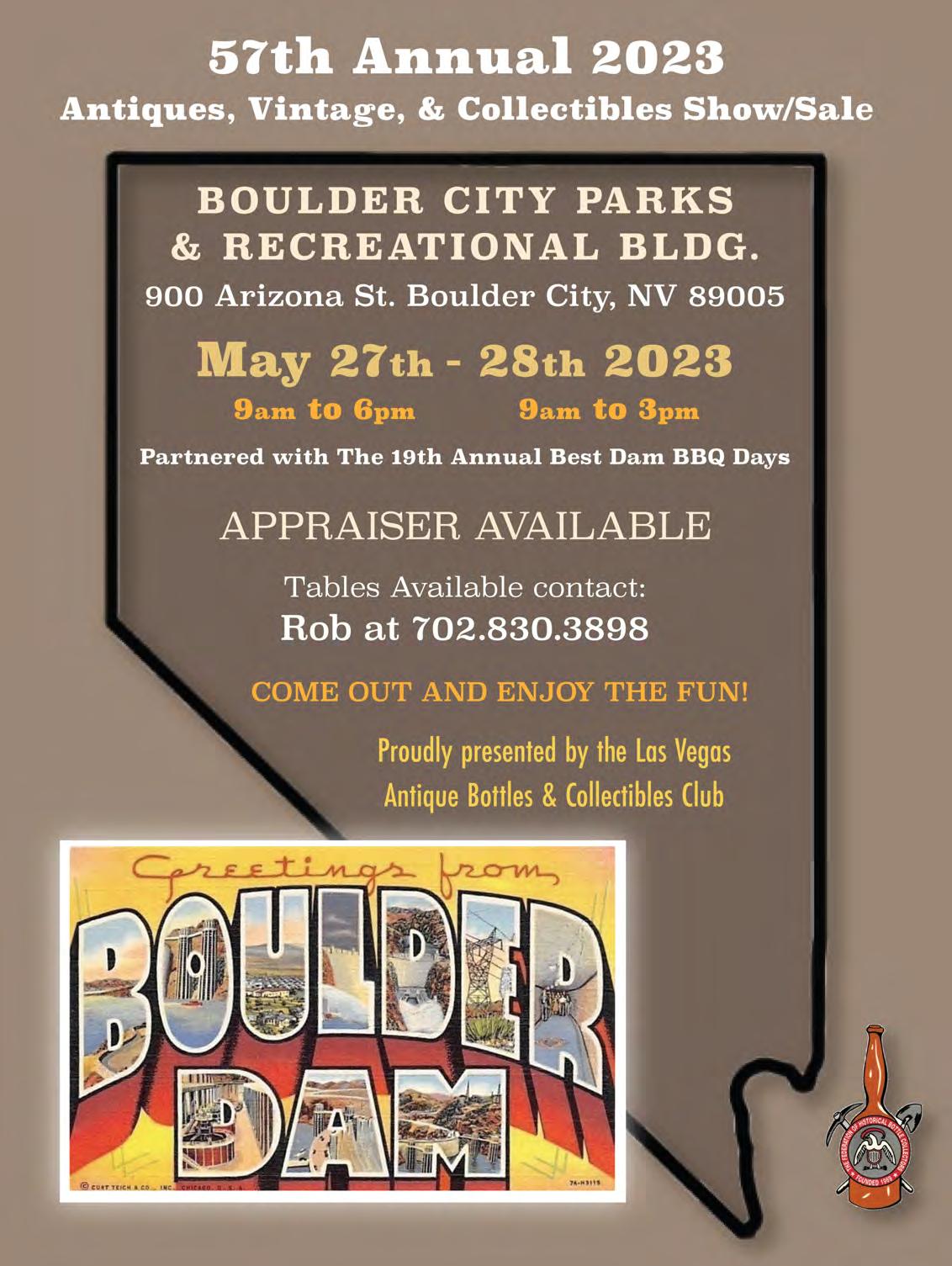
58
Antique Bottle & Glass Collector


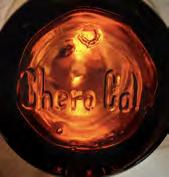

March – April 2023 59
See Allen in “TheHolyGrailof Chero-Colas” in the Sept–Oct 2022 issue of AB&GC.
[left] I dug this transferware pitcher last weekend in a Des Moines outhouse pit. Bottom says “FARM” (pattern) British Registry mark date is December 15, 1882. This dated the hole as well. An unusual find, and whole! –Mark Wiseman

[below right] Said to be very rare and hard to find, this 1926 Turner pressed steel bus found a buyer at $5,520. With a six-window body, full running boards, front bumper and headlights, it sported original light blue paint with a gold stripe and was 28½ inches long.Weissman collection, Antiques And

[above] Here is my newest postal cover. Are you familiar with this Dr. Houck? He has a middle initial of F, so is not the Baltimore Houck.

This label-only
bottle

Cold &

By Edward Allen. Hart-

Ct.” The octagonal, rich olive-yellow ink has a pontil scar and was found in a Westbrook, Connecticut attic in the 1980s. Edward Allen lived and worked at a number of different addresses in Hartford, Connecticut from 18521875. He was also enlisted in the United States Army during the Civil War years of 1862-1865. – Heckler
[below] I found this in a garage sale. The guy said he got it from an old store in Evansville, Wisconsin that was remodeling their front entry. He removed the sign and was always going to put it up somewhere but didn’t have a place for it. I purchased it for $200. It probably should go to a cigar collector but I kind of like it. I told the guy I collected old patent medicines and he said “Like Warner’s Safe Cure?” I said exactly and we started up a lively discussion. He found one while cleaning out his store! –Michael Seeliger

60 Antique Bottle &
Collector
Glass
Read and see more in the FOHBC Virtual Museum.
–Ben Swanson
The Arts Weekly. June 2021
[left]
ink
reads “Premium
Steel Pen Black Ink. Manufactured
ford,
Lost & Found
[right] Over the summer, an amateur historian in Newfoundland unearthed a 600-year-old gold coin. According to government officials, who announced the find in a statement earlier this month. The Henry VI quarter noble was minted in London between 1422 and 1427—and it may be the oldest English coin ever found in Canada. Courtesy of the Government of Newfoundland and Labrador. –Smithsonian magazine

[above] This Pontil Birdcage was handmade with glass and five different colors that swirl from the same pontil end of the marble. It is no surprise that the Chinese 5-color Pontil Birdcage was sold in the auction from the Morphy Auction House for $7,670 in 2012, in nearly perfect condition. This marble has one controlled bubble inside the birdcage shape, hence the name.


[left] Brobst & Rentschler flask: My digger partners and I unearthed this flask in the Wilmington, Delaware, area this past year. This would otherwise have been an ordinary amber strap flask except for the angled slug plate spelling error embossing of Brobs & Rentschler of Reading, Pennsylvania. Brobst is spelled wrong by omitting a “T.” Read the rest in Member News this issue. –David Smith


[below] A miner who discovered the largest tanzanite gems ever has now found a third—and it’s worth millions. A Tanzanian miner made another discovery of one of the rarest gemstones on Earth, possibly earning the small-scale miner millions of dollars—again. Saniniu Laizer, 52, recently discovered the rare, dark violet-blue tanzanite gem, weighing 14 pounds. Tanzanite is only found in northern Tanzania and is valued based on its rarity, color and clarity. The gem is valued at 4.7 billion Tanzanian shillings, or $2 million, the BBC reported, and is among the dwindling number of Tanzanite left in the world.

March
61
– April 2023
[left] I read your blog post about these (Old Sachem) bitters bottles. I just came across one for $3 at a thrift store! – Matthew Waxman
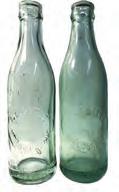
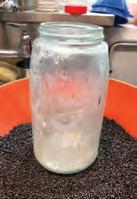
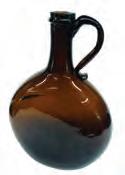
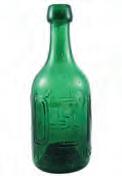

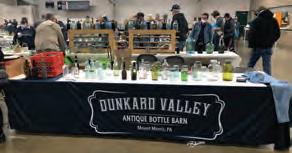



62 Antique Bottle & Glass Collector Professional Bottle Cleaning & Restoration Cleaning bottles that have haze, cloudiness or hard water spots is possible using the Jar Doctor Copper Tumbling System. Bottles of most sizes, shapes or colors can be made to look like new. The bottle barn is owned and operated by Don and Mary Kelley from Mount Morris, PA. They have antique bottles of all types on display or for sale and trade. Open Monday - Friday 9:00 - 2:00 | Later hours by appointment Call Don & Mary Kelley at 724.998.2734 Located in Southwestern PA Off I-79 Mount Morris, PA 6th Annual AT MYLAN PARK MON CENTER 270 MYLAN PARK LANE, MORGANTOWN, WV 26501 GENERAL ADMISSION $3.00 16 AND UNDER FREE ADMISSION EARLY BUY IN SAT 3:00PM & SUN 8:00AM $25.00 SHOWROOM & PAVILION VENDING SPACE AVAILABLE ANTIQUE GLASS BOTTLES / HISTORICAL FLASK SODA, MILK, MEDICINE, BEER, WHISKEY, STONEWARE, FRUIT JARS MARBLES, INSULATORS, COINS, POSTCARDS, JEWELRY, BREW MANIA MILITARIA, TOYS, SIGNAGE AND VARIOUS TABLE TOP ANTIQUES DON KELLEY | BONZEYEKELLEY@GMAIL.COM 724-998-2734 MORGANTOWN, WV APRIL 30, 2023 9:00AM TO 2:00PM
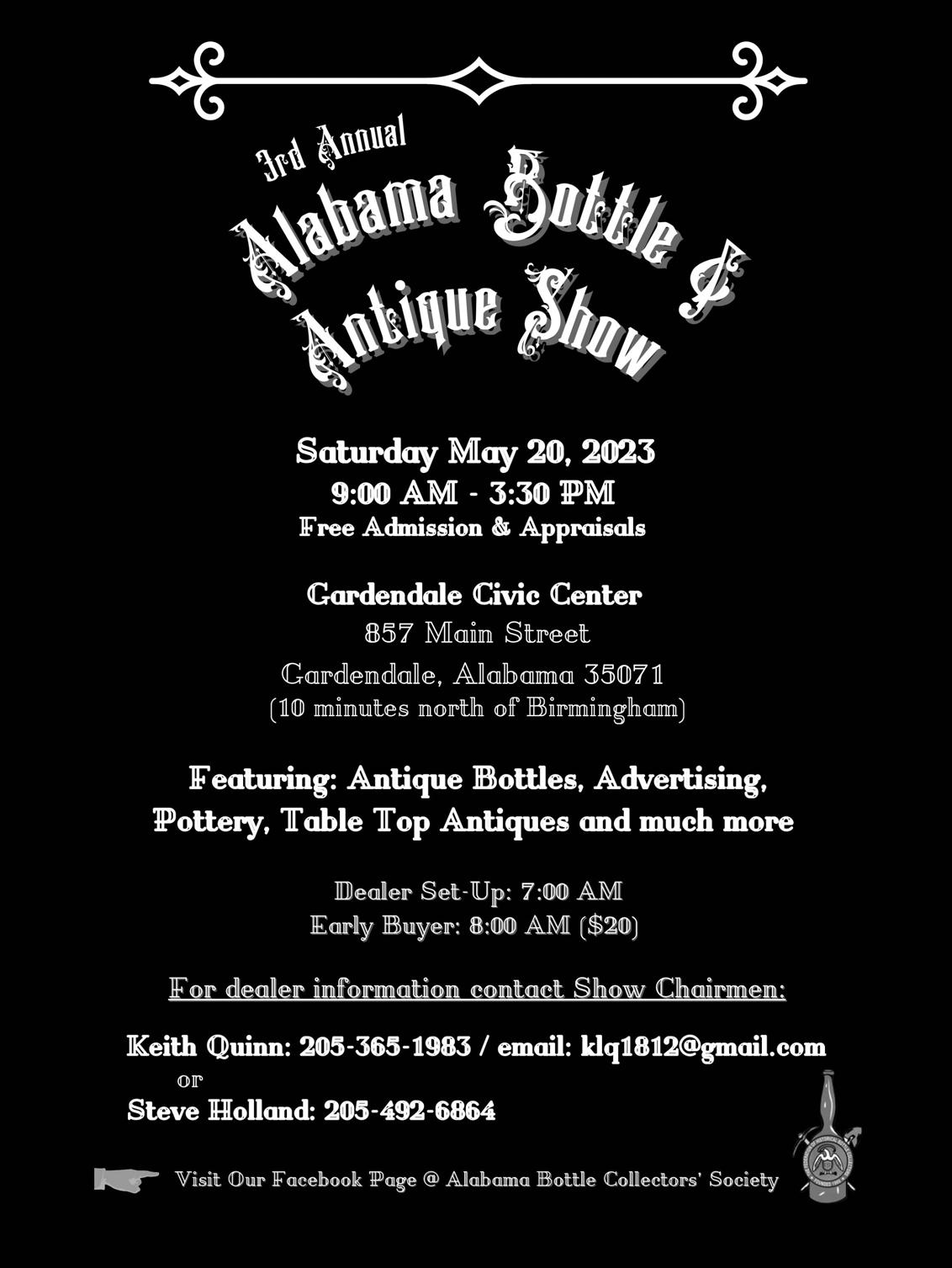
March – April 2023 63
Member Photos



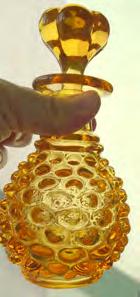
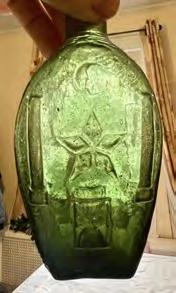


A collection of spectacular and inspiring photographs from around the world and around the web. Please feel free to submit your images for consideration.


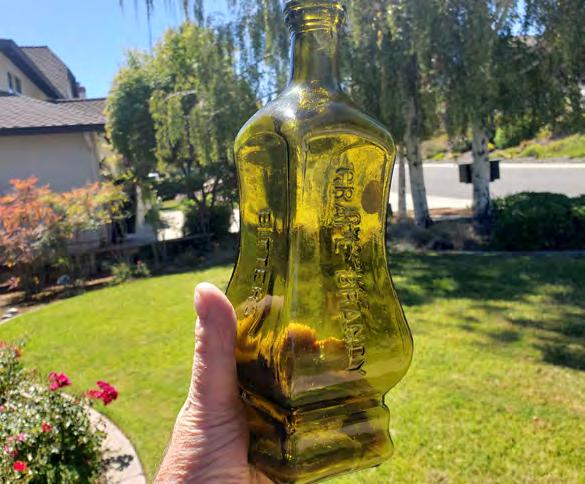


64
Read and see more in the FOHBC Virtual Museum.
Antique Bottle & Glass Collector
A Little Grade A amber – Michael George
Rick Ciralli
Cylinders –Wyat St. Laurent
Embossed Dr. Kilmer bottles - Gary Christensen
Cassin’s Grape Brandy Bitters in a break between rains – Bobby B. Luthi
Early Syrupy Sunday – Ford C Jeff
Woody Douglas
Elise Hempel
Member Photos







March – April 2023 65
For Member Photos – Brian Schilz
Merry Christmas – Daniel Baldwin
Inks? Syrups? 1820s – Bobby B. Luthi
Lampshade Demijohn – Brian Bingham
*See Member News this issue.
Just a small sample of my jars! (Also on right) - Steve Kehrer
Classified Ads
ADVERTISE FOR FREE:

Free “FOR SALE” advertising in each issue of Antique Bottle & Glass Collector (AB&GC). One free “WANTED” or “FOR SALE” ad in AB&GC per year each renewal. See page 72 for more info. DEALERS: Sell your bottles in the Antique Bottle & Glass Collector. Change the bottles each issue. Include your website in your ad to increase traffic to your site. Send all advertisement info to FOHBC Business Manager, Elizabeth Meyer, P.O. Box 1825, Brookshire, Texas 77423 or best, email to: fohbcmembers@gmail.com
FOR SALE
FOR SALE: 22 John Ryan’s plus an additional 48 other Georgia sodas. Text or email for photos and prices. Rod Vining, 251.957.6725, vinewood@mchsi.com (3-1-23)
FOR SALE: Jar Doctor is for sale - includes equipment, inventory, supplies (shipping boxes, containers, etc.), molds, jigs, power tools, customer information, supplier information, and training. Please contact R. Wayne Lowry, JarDoctor@aol.com, 816.318.0161 for information and/or to discuss options. 01/01/23
FOR SALE: Book: A History of the Des Moines Potteries, with additional information on Boonesboro, Carlisle, Hartford, and Palmyra. 214 pages, 65 color. Cost $23 plus shipping, media mail add $4.50, priority add $6. Mail to Mark C. Wiseman, 3505 Sheridan Ave., Des Moines, Iowa 50310, 515.344.8333 01/23
FOR SALE: Mint: 1) Warner’s Safe Nervine half pt. slugplate. Light amber, $300 2) Warners’s Safe Cure London, half pint, green, $300 3) Warner’s Safe Kidney & Liver Cure. Pint, slugplate, A & D.H.C. on bottom, $250 4) Warner’s Diabetes Cure, pint. Melbourne, $150 5) Dr. Von Hopfs Curacoa Bitters, Chamberlain & Co., Des Moines, Iowa, yellow, $175. I have a lot more Warner’s for sale. Will trade for mini whiskey jugs. Stencil or scratch with maker and town and city on them. Jack Brower, 479.434.6306 01/23
WANTED
WANTED: BLACK HAWK, COLORADO
Th. Crook Sky Light whiskey flask. I will pay $10,000 for a half-pint coffin or a pint coffin or a pint shoofly. Flask must be in mint condition and delivered to Colorado. Other Black Hawk bottles might be of interest if not already owned. Contact: David D. Spellman at spellmand@centurylink.net 01/23
WANTED: Adirondack Springs, Westport, N.Y., Top prices paid for bottles in excellent condition, photos, postcards or other advertising. These springs are presently owned by my family. Jim Tromblee at jtromblee@together. net or 813.663 8285 (3-1-23)
WANTED: Harley bottles of West Chester, Pa. and Philadelphia, Pa. The West Chester bottles (3) display either J. Harley, James Harley or E.M. Harley. The Phila. Bottles (4) display Edwd. Harley, Schul (Schuylkill) 4th & Market St., Philada or E. Harley, 802 Market St. or E. Harley, West Market St. or Edw. Harley, 1838 Market St., Phila. Bob Harley, email: rwh220@yahoo.com, Phone: 215.721.1107 (12/23)
WANTED: 1976 Expo commemorative flasks in colors I do not already have. Pat Jett, 314.570.6917; patsy_jett@yahoo.com (3-1-23)
WANTED: Refrigerator water bottles – Bilby style: Katz Drug, Minnehaha, Spirit of 76, Aerox, any others of which I am not aware, and any in amber. Dave Parmalee, jdparmalee@ comcast.net, 865.719. 4162 (3-1-23)
WANTED: Jar lid for Cohansey 2 ½-gallon RB #628. Call Ed DeHaven 609.390.1898 or 609.402.6229. Thanks! (3-1-23)
WANTED: Ford City, Pa embossed bottles, also Meckling and Kramer, Kittanning, Pa. Remember the Maine Hutches. Keystone Bottling Works, Sagamore, Pa., Bill Oleksak, 724.859.0113, billoleksak1947@gmail.com, (3-1-23)
WANTED: Moore Ink bottles and any related items to the Moore Ink Co. Thank you. Ron Rainka, 1198 Main St., Warren, Ma. 010830685, tele: 413.436.5998 (3-1-23)
WANTED: Checkers Chemical Co., Winston-Salem NC (Reverse) “It makes you feel good all over” Amber, about 10”, square bitters form, Blown, No damage and clean. Will pay $500. Thank you, Curt Ewing, curtielind@ yahoo.com (3-1-23)
WANTED: All types of MOBILE ALABAMA Bitters, Whiskeys, Medicine, Drug Stores, Sodas (no crown tops), Decorated Stoneware, Transferware, Paper and all other related items. One item or an entire collection. Rod Vining, 10691 Old Pascagoula Road, Grand Bay, Ala-
bama 36541, 251.957.6725, vinewood@mchsi. com (3-1-23)
WANTED: Amber Claussen Bottling Works Hutchinson soda bottle from Charleston, S.C., Joe, 803.926.0906 (3-1-23)
WANTED: Exposition Brewing Co. Delray (Detroit) Mich Beer, blob tops 12 oz amber or aqua or quart size amber – American Brewing Co. Delray Mich, blob tops 12 oz. amber, aqua or clear or quart size amber. Also Geo. H. Schmitt Delray Hutchinsons, quarts, blob tops or crown tops – Geo. H. Schmitt Delray Seltzer Water clear. Rick Myers, 313.742.8668. (3-1-23)
WANTED: North Florida bottles, Southern Stoneware or unusual black glass forms. Contact Alan McCarthy 850.832.1882 (1/23)
WANTED: To buy Dr. Mitchell Sarsaparilla from Perry, NY in Wyoming County. Will pay $4k. Bours Cordial Tonic from Geneva, NY. Will pay $4k. Looking to buy large Milk Bottle Collections from all over the United States. Contact Jim 315.527.3269 (1/23)
WANTED: 1-Spencer Bros (Brothers) Oaklandvale Farm Saugus Massachusetts Milk Bottle. 2-PJ Spencer, Malden, MA Milk Bottle (Cardboard top says “The Old Spencer Farm”) 3-Frank P Bennett, Oaklandvale Farm Milk, Saugus MA Milk Bottle. Interested in tops or any other items or information related to these three farms. Any size bottle is fine. Please email lyork1@cfl.rr.com or leave a message at 407.416.2677. Call will be returned ASAP. Thank you. (1/23)
WANTED: Rare pontiled meds particularly Southern meds, Michael D. Morgan, mmorgandive@gmail.com (1/2/23)
WANTED: Dr. A. C. Daniels advertising signs–St. Johnsbury, Vermont Old Items, Dennis Daniels, 448 Pleasant St., St. Johnsbury, VT, 05819, 802.748.2274. (1/23)
WANTED: Colored Figural Bitters. Also other bitters that are unusually shaped or unusually colored, for their grouping! Mint specimens only please! Randolph Haumann, 10410 Gold Arrow Drive, Reno, Nevada 89521-5190 or cell 415.518.4124 (leave message) or email: hawkeye751@outlook.com, Call Now! So you are not sorry...Later! 11/24
66 Antique Bottle & Glass Collector
Classified Ads
WANTED: Dr. Ball’s Vegetable Stomach Bitters, O.P., Mint. Contact: Michael Willbanks, WANTED: Hobble skirt embossed Coca-Cola bottles: 1915s, 1923s, D-Patent’s 6 oz and 6 1/2 oz. Collector will buy or trade. Jim Georges, georges77@twcny.rr.com or 315.662.7729. 07/24
WANTED: Colored Illinois and Missouri Sodas. Also Colored Fruit Jars. Top $$$ Paid. Call, text or email. Steve Kehrer, email: kehrer00@gmail.com, 618.410.4142. 03/23
WANTED: Hobble skirt embossed Coca-Cola bottles: 1915s, 1923s, D-Patent’s 6 oz and 6 ½ oz. Collector will buy or trade. Jim Georges, georges77@twcny.rr.com or 315.662.7729. 07/24
PERMANENT WANT: OWL DRUG bottles, tins, boxes, paper, anything from the Owl Drug Company. Marc Lutsko, letsgo@montanasky. net, 406.293.6771, Box 97, Libby, MT 59923 TOP DOLLAR paid 01/23

WANTED: Volunteers to help the FOHBC. Help our organization stay strong by writing an article, be a magazine proofreader or a Virtual Museum researcher. Post on our social media sites and share our posts. There are many ways you can help. Donations to our non-profit organization are always accepted. Thank you. 01/23
WANTED: Embossed Ford City, PA bottles. Also, Mechling & Kramer, Kittanning Hutch and Remember the Maine Hutch. Keystone Bottling Works, Sagamore, PA Hutch. Bill Oleksak, billoleksak1947@gmail.com 724.859.0113 01/23


WANTED: Hello Levi Strauss and Western collectors! Years ago, a well-known California dealer discovered a major California gold rush archive from the Hardy-Kennedy store in Forest Hill, California. In it were a number of Levi Strauss billheads from the 1850s. We are looking for collectors who may have bought one or more and are soliciting copies of these
billheads for an important paper I am working on. The information contained on these may be integral to the substance of my proposed paper and may enhance the value of your billhead! I am looking forward to some discoveries. Thanks in advance. Fred Holabird, fredholabird@gmail.com, 775.851.1859 01/23
SHOWS, STOPS & SERVICES
NEEDING: Historical pictures for the online FOHBC Research Library. 03/01/23
AUCTION PRICE REPORT: Remember, all FOHBC members get access to the Auction Price Report website. Visit the FOHBC.org Members Portal.
REMEMBER: Please keep up with your membership to avoid interrupted service. Membership options available.
Dealer tables (6 ft.): $20
Lunch available
Directions from NY Thruway Exit 31
From toll plaza, turn right onto N. Genesee Street. At 2nd light, turn left onto Riverside Drive. Go 0.1 mile and stay straight to go onto River Road. Go 1.4 miles and turn right onto Flanagan Road. Go 0.3 mile until 5535
March – April 2023 67
Mohawk Valley
Bottle Club will host its 27th Annual Utica Bottle Show & Sale Sunday May 7, 2023 at the Utica Maennerchor in Marcy, NY (map available at our web site) Show location Utica Maennerchor 5535 Flanagan Road Marcy, NY 13403 (2 miles from Thruway) Show details
hours: 9 am – 2:30 pm
The
Antique
Show
Admission: $5
Flanagan
For information and dealer contracts: Call Peter Bleiberg at (315) 735-5430 or email pmbleiberg@aol.com or visit www.mohawkvalleybottleclub.com
Road is on the left.
Sho-Biz Calendar of Shows
FOHBC Sho - Biz is published in the interest of the hobby. Federation-affiliated clubs are indicated in red. Information on upcoming collecting events is welcome, but space is limited. Please send at least three months in advance, including telephone number to: FOHBC Sho-Biz, c/o Business Manager: Elizabeth Meyer, P.O. Box 1825, Brookshire, Texas 77423; phone: 713.504.0628; email: fohbcmembers@gmail.com Show schedules are subject to change. Please call before traveling long distances. All listings published here will also be published on the FOHBC.org website.
11 March 2023 – Platte City, Missouri
NW Missouri Insulator and Bottle Show & Sale, 9:00 am to 3:00 pm. Dealer set up on Friday afternoon, Platte County Fairgrounds, 15730 Fairgrounds Rd., Platte City, Missouri, 85+ tables of Insulators, bottles, jars, telephones, lightning rod balls & arrows, advertising and other misc. antiques. Established show with a lot of advertising. Easy access from interstate. Great foot traffic from Kansas City, St. Joseph & surrounding rural areas. Display space is available and displays are welcome. For dealer and/or show information, contact Darryl Wagner, insulators@dwagnerkc.com or 816.719.0801. FREE Insulator & bottle appraisal available at each show.
12 March 2023 – Baltimore, Maryland
The Baltimore Antique Bottle Club Show & Sale, New Location, 9:00 am to 3:00 pm, baltimorebottleclub.org, Howard County Fairgrounds, Main Exhibition Hall, 2210 Fairgrounds Road, West Friendship, Maryland 21794, Contact Info: Rick Lease, 410.458.9405, finksburg21@comcast.net, Micah Dolina (contracts), mdolina@ hotmail.com, FOHBC Member Club
18 March 2023 – Dalton, Georgia
Chattanooga North Georgia Antique Bottles & Advertising Show, Dalton Convention Center, 2211 Tony Ingle Pkwy, Dalton, Georgia 30720 (Exit 333 off I-75). There will be concessions at the show. Free Appraisals are Available. Set up: 6:00 am to 8:00 am, Early Buyers: 8:00 am to 9:00 am ($20 for early buyers). Admission Free: 9:00 am to 3:00 pm. Parking is free. Show Chairmen: Jason Herron 205.913.9748 and Buddy Lasator 423.718.3521. Email: chattbottleshowinfo@gmail.com, FOHBC Member Club
19 March 2023 – St. Louis, Missouri
St. Louis 53rd Annual Antique Bottle & Jar Show; Orlando Gardens, 4300 Hoffmeister Avenue, St Louis, Missouri 63125. General Admission is $3 from 9 am to 2 pm; Set-up 7 am to 9 am. Children free. Contact: St Louis Antique Bottle Collectors Assn., Pat Jett (show chair), 71 Outlook Drive, Hillsboro, Missouri 63050, 314.570.6917, patsy_jett@yahoo.com, FOHBC Member Club
19 March 2023 – Somers, Connecticut
52nd Annual Somers Antique Bottle Club’s Antique Bottle Show and Sale, 9:00 am to 2:00 pm., Admission $5, Early buyers: 8:00 am- $15. Joanna’s Restaurant, 145 Main St., Rte 190, Somers, Connecticut. Contact: Don Desjardins, 22 Anderson Road, Ware, Massachusetts 01082, 413.967.4431 or 413.687,4808, dondes@ comcast.net, FOHBC Member Club
25 March 2023 – Daphne, Alabama
The Mobile Bottle Collectors Club’s 50th Annual Show & Sale will be held on Saturday, March 25, 2023, from 9:00 am to 3:00 pm at the Daphne Civic Center, 2603 US Hwy 98, Daphne, Alabama 36525. Free Admission and Bottle Appraisals. Dealer Setup is Friday, March 24, 2023, from 3:00 pm to 7:00 pm and Saturday from 7:00 am to 9:00 am. For more information, contact Rod Vining at 251.957.6725, Email: vinewood@mchsi.com or Facebook: “Mobile Bottle Collector’s Club Show & Sale.” FOHBC Member Club
26 March 2023 – Flint, Michigan
The 53rd Flint Antique Bottle & Collectibles Show; Dom
Polski Hall, 3415 N. Linden Road, Flint, Michigan 48504. No early admission. General Admission $3, 9 am – 2:30 pm. Set up: 7:00 am to 9:00 am. Contact: Tim Buda, 11353 Cook Road, Gaines, Michigan 48436, 989.271.9193 or tbuda@shianet.org; or visit Flint Antique Bottle & Collectibles Club Facebook Page, FOHBC Member Club
26 March 2023 – Cicero, New York
The Empire State Bottle Collectors Association is having their 51st Annual Spring Show & Sale. This is the oldest continuously active club in the United States. 9:00 am to 2:00 pm, Cicero American Legion, 5575 Legionnaire Drive, Cicero, New York 13039; Set-up at 7:00 am. Contact: Dave Tuxill, C-chair, dtuxill1@ twcny.rr.com, 315.469.0629. No early admission. $3 cost of admission and under 12 free. FOHBC Member Club
01 April 2023 – Wheaton, Illinois
DuPage Collectors Expo featuring insulators, lightning rod items, weather vanes, telephone & telegraph items, bottles, jars, and related items. 9:00 am to 3:00 pm. 2015 Manchester Road, Wheaton, Illinois 60187, Admission $2, Contact: Bob Stahr, 360 S. Kenilworth Ave., Glen Ellyn, Illinois 60137, 630.793.5345, bob@hemingray.com, Hemingray Historian & Collector
01 April 2023 – Reddick, Florida
The Deland Antique Bottle Show at Turkey Creek. Saturday, April 1, 8:00 am to 3:00 pm, Friday Early Buyers $20 and Dealer Set-up 1:00 pm to 6:00 pm. FREE admission Saturday, Turkey Creek Auctions Building, 15323 NW Gainesville Road, Reddick, Florida 32686; Contact Ronnie McCormick, 352.262.8672, oldflabottles@ gmail.com or Louise O’Quinn, 386.943.2766, edlouise210@gmail.com
02 April 2023 – Hutchinson, Kansas
16th Annual Kansas Territory Bottle & Post Card Show & Sale, General Admission: 9:00 am to 3:00 pm. Kansas State Fairgrounds, Sunflower Building, 2000 N. Poplar Street, Hutchinson, Kansas, Info: Mike McJunkin, 620.728.8304, scarleits@cox.net or Mark Law, 785.224.4836, kansasbottles@gmail.com, FOHBC Member Club
08 April 2023 – Kalamazoo, Michigan
The Kalamazoo Antique Bottle Club’s 42nd Annual Antique Bottle & Glass Show & Sale, 10:00 am to 2:30 pm, Kalamazoo County Fairgrounds, 2900 Lake St., Kalamazoo, Michigan. Contact: John Pastor, 616.581.7005, jpastor@americanglassgallery.com, Sponsored by the Kalamazoo Antique Bottle Club, FOHBC Member Club
16 April 2023 – Bloomington, Minnesota
North Star Historical Bottle Association Presents its 51st Annual Antique Bottle, Advertising, and Stoneware Show and Sale, 9:30 am to 2:30 pm at the Knights of Columbus Event Center, 1114 American Blvd. West, Bloomington, Minnesota 55420. Info: 651.271-3423, AKonitzer1@gmail.com, FOHBC Member Club
16 April 2023 – Rochester, New York
52nd Annual GVBCA Rochester Bottle & Antique Show,
Roberts Wesleyan College, Voller Athletic Center, 2301 Westside Drive, Rochester, New York 14624, 9:00 am to 3:00 pm, Admission $5. 17 and Under FREE, Show and Dealer Inquires: Aaron and Pamela Weber gvbca@frontiernet.net, 585.749.8874, FOHBC Member Club
21 & 22 April 2023 – Antioch, California
The Golden Gate Historical Bottle Society’s 55th Annual Bottles, Antiques & Collectibles Show, Early Buyers: Friday 12 pm to 5 pm, $10 Admission; General Admission: Saturday 9:00 am to 3:00 pm, Free. Contra Costa Event Park (Fairgrounds), Sunset Hall, 1201 West 10th Street, Antioch, California 94509. Info: Gary and Darla Antone, 925.373.6758, packrat49er@netscape.net, FOHBC Member Club
22 April 2023 – Columbia, South Carolina
The South Carolina Bottle Club’s 50th Annual Show & Sale, 206 Jamil Road, Columbia, South Carolina 29210, 172 Tables last year with room to grow! Saturday 9:00 am to 4:00 pm, Donation at the door suggested, Dealer Only Set-Up 7:00 am to 9:00 am, Jamil Shrine Temple, Contact: Marty Vollmer 803.629.8553, martyvollmer@aol.com or Art Gose 803.840.1539, scbottlehunters@ gmail.com, FOHBC Member Club
30 April 2023 – Morgantown, West Virginia
6th Annual Dunkard Valley Antique Bottle Stoneware Show & Sale, 9:00 am to 2:00 pm; Early buyers 7:30 am, $25. Both inside and outside vendor spaces are available! Monongalia County Extension Services & 4H Center, 270 Mylan Park Lane, Morgantown, WV 26501, Contact: Don Kelley, 724.998.2734, bonzeyekelley@gmail.com
07 May 2023 – Gray, Tennessee State of Franklin Antique Bottles & Collectible Assoc. 25th Annual Show & Sale, Saturday, May 6th, 9:00 am to 3:00 pm, Appalachian Fairground, 100 Lakeview Street, Gray, Tennessee 37615, Exit 13 on I-216, No Early Admission. sfabca.com, FOHBC Member Club
07 May 2023 – Marcy, New York
The Mohawk Valley Antique Bottle Club will host its 27th Annual Utica Bottle Show & Sale at the Utica Maennerchor, 5535 Flanagan Road, Marcy, New York 13403, Info: Peter Bleiberg at 315.735.5430 or email pmbleiberg@aol.com, www.mohawkvalleybottleclub.com, FOHBC Member Club
12 & 13 May 2023 – Mansfield, Ohio
44th Mansfield Antique Bottle Show, Hosted by the Ohio Bottle Club, at the Richland County Fairgrounds, 750 N. Home Road, Mansfield, Ohio 44906; Admission $5 Saturday, 9:00 am to 2:00 pm. Early admission is $40, Friday, May 12, from 2:00 to 6:00 pm. Info: Matt Lacy at 440.228.1873 or email info@antiquebottlesales. com or Louis Fifer at 330.635.1964, fiferlouis@yahoo.com, FOHBC Member Club
12 & 13 May 2023 – Kent, Washington
7th Annual Washington Bottle & Collector’s Antique Bottle & Collectible Show, Kent Commons Community Center, 525 4th Avenue N., Kent, Washington 98032. Admission is Free; Early Admission is $5, Friday, May 12th, Noon to 5:00 pm. Saturday, May 13th,
68 Antique Bottle & Glass Collector
Sho-Biz Calendar of Shows
9:00 am to 3:00 pm. Washington Bottle & Collectors Association (WBCA), Website: wabottleclub.org, Contact: Lisa Conners, PO Box 358, Hobart, Washington, Tele: 206.290 0349, Email: lisa.g.conners@gmail.com, FOHBC Member Club
19-21 May 2023 – Adamstown, Pennsylvania Shupp’s Grove Bottle Festival, Sat & Sun, 6:00 am to dusk, early buyers Friday, 3:00 pm, The famous ‘Shupp’s Grove,’ 607 Willow Street, Reinholds, Pennsylvania 17569, Contact Info: Steve Guion, 717.371.1259, william03301956@gmail.com
20 May 2023 – Mandeville, Louisiana
The Greater New Orleans First Annual Antique Bottle & Collectibles Show & Sale at the Mandeville Lions Club, 720 Lafitte Street, Mandeville, Louisiana 70448, Dealer Set Up, Friday, May 19, 12 noon to 5:00 pm and on Saturday, May 20, 8:00 to 10:00 am. Early Bird $25 during dealer setup. Free admission is Saturday, May 20, from 10:00 am until 4:00 pm; contact Peter Taggard, 645 Village Lane South, Mandeville, Louisiana 70471. Call or text: 985.373.6487, Email: petertaggard@yahoo.com
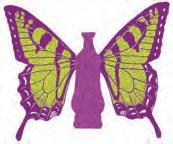

20 May 2023 – Gardendale, Alabama
3rd Annual Alabama Bottle & Antique Show, Saturday, May 20, 9:00 am to 3:00 pm; free admission and appraisals. Gardendale Civic Center, 857 Main Street, Gardendale, Alabama 35071 (10 minutes north of Birmingham). Info: Keith Quinn: 205.365.1983, klq1812@gmail.com or Steve Holland, 205.492.6864. Visit our Facebook page Alabama Bottle Collectors’ Society.
FOHBC Member Club
21 May 2023 – Washington, Pennsylvania Washington County Antique Bottle Club 49th Annual Show and Sale, Alpine Star Lodge, 735 Jefferson Avenue, Washington, Pennsylvania 15301, Admission $3, 9:00 am to 2:00 pm, Info: Ed Kuskie, 412.405.9061, 352 Pineview Drive, Elizabeth, Pennsylvania 15037, bottlewizard@comcasat.net, FOHBC Member Club

27 & 28 May 2023 – Boulder City, Nevada
57th Annual 2023 Antiques, Vintage & Collectibles


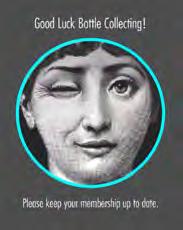
Show/Sale. Proudly presented by the Las Vegas Antique Bottles & Collectibles Club. 9:00 am to 6:00 pm on Saturday. 9:00 am to 3:00 pm Sunday. Boulder City Parks & Recreational Bldg., 900 Arizona St. Boulder City, Nevada 89005. Partnered with The 19th Annual Best Dam BBQ Days. An appraiser is available. For tables contact Rob at 702.830.3898, FOHBC Member Club
03 June 2023 – Pickens, South Carolina
The Pickens Bottle Show at The Market at the Mall, 225 Pumpkinville Hwy, Pickens, S.C. 29671, 8:00 am to 2:00 pm, Set-up 7:00 to 8:00 am. Show and dealer information Samuel Rhodes, 864.508-6518, samuelrhodes99@gmail.com
04 June 2023 – Ballston Spa, New York
The National Bottle Museum presents the 43rd Annual Saratoga Antique Bottle Show & Sale, 9:00 am to 2:30 pm; early admission 8:00 am, $20, Admission $5, Children 12 and under free. Saratoga County Fairgrounds, 4H Building, 162 Prospect St, Ballston Spa, New York, National Bottle Museum, 76 Milton Avenue,
Ballston Spa, New York 12020, 518.885.7589, Contact: Roy Topka, Co-chairman, info@nationalbottlemuseum.org, FOHBC Member Club
17 June 2023 – Johnston, Iowa
The Iowa Antique Bottleers 52nd Annual Antique Bottle & Collectibles Show and Sale at the Johnston Lions Club, 64th Place and Merle Hay Road, Johnston, Iowa; Admission $2, Children Free, For info contact Mark Wiseman, 3505 Sheridan Avenue, Des Moines, Iowa 50301, 515.344.8333 or Joyce Jessen, 515.979.5216, FOHBC Member Club
12 August 2023 – Lincoln, Alabama
8th Annual Lincoln Bottle & Antique Show. Lincoln Civic Center, 123 Jones Street, Lincoln, Alabama 35096, 9:00 am to 2:00 pm. Contact chairman Jake Smith, 256.267.0446, syl_bottleguy@ yahoo.com. Free public admission, $20 early admission Saturday 8:00 am till 9:00 am, Free appraisals. Info on Facebook.
19 November 2023 – Greensboro, North Carolina
Greensboro Antique Bottle & Collectibles Show at the Farmer’s Curb Market, 501 Yanceyville Street, Greensboro, North Carolina 27405, Sunday 8:00 am to 2:00 pm, No Early admission, Set up: Sunday 6:00 am to 9:00 am. Cost of admission $1, Contact: David Erickson, 257 Palomino Trail, Lexington, North Carolina 27295, 336.247.1928, dave.erickson111@gmail.com
01 August to 04 August 2024 – Houston, Texas
FOHBC 2024 Houston National Antique Bottle & Glass Convention & Expo hosted by the Houston Museum of Natural Science and the Federation of Historical Bottle Collectors. Brought to you by Peachridge Collections, LLC. Host Hotel: Hotel Zaza Museum District. Featuring a major, 8,000 square foot museum exhibition that will include the Sandor P. Fuss collection and selected highlights from the David P. Wilber and Anthony Gugliotti collections. Simultaneous FOHBC Virtual Museum Exhibition of same. Contact Ferdinand Meyer V, fmeyer@fmgdesign.com for information, FOHBC Event
USPS and Magazine Delivery – The FOHBC is working hard to ensure that your magazine is mailed from our printer by midmonth preceeding the issue date. We are currently experiencing delays with our printing due to staffing and paper delivery. The USPS, as most of you probably know, is experiencing longer than normal delivery times. Compounded with Covid-19 and holidays, we hope to have this issue to you on time. Remember...read online if you want it earlier!
Two Seminars at the Maryland Arms Antique Show
How
March – April 2023
Steamboat in the Cornfield 10 am – 11:15 am
the Mason-Dixon Line was formed 1 pm – 2 pm
March 19, 2023 Maryland Arms Antique Show Cow Palace at Maryland State Fairgrounds Timonium, Maryland Cost $10 (cash only) A. Glen Mansberger, Jr. 410-686-8231
2024 NATIONAL ANTIQUE BOTTLE & GLASS EXPO Antiques & Collectibles Book Publishing, Design, Marketing, Advertising, Websites
Sunday,
HOUSTON




70
Antique Bottle & Glass Collector
Membership Benefits & Display Advertising Rates
The Federation of Historical Bottle Collectors (FOHBC) is a non-profit organization supporting antique bottles and glass collecting. The goal of the FOHBC is to promote the collection, study, preservation and display of historical bottles and related artifacts and to share this information with other collectors and individuals.
Federation membership is open to any individual or club interested in the enjoyment and study of antique bottles. The FOHBC publication, Antique Bottle & Glass Collector, is well-known throughout the hobby world as the leading publication for those interested in antique bottle and glass collecting and all associated ephemera. The FOHBC Virtual Museum is the most comprehensive antique bottle and glass experience on the Internet. Your FOHBC Individual Membership benefits include:

A full year subscription to the all-color, bi-monthly (6 issues a year) 72-page plus covers publication, Antique Bottle & Glass Collector. Various membership options are available including Digital Membership.
Free advertising of “For Sale” items in Antique Bottle & Glass Collector (restrictions apply—ads may be up to 100 words, items must be of $25 or greater value, and free advertisements are limited to the first received. One free ad of 60 words each year for use for items such as For Sale and Wanted, trade offers, etc.
Access to FOHBC.org, a comprehensive website dedicated to the organization and hobby. Access through the Members Portal to the Membership Directory, archived FOHBC past issues, indexed articles and a vast assortment of research material.
Access to the FOHBC Virtual Museum of Historical Bottles & Glass. FOHBC members are museum members.
Access to the online FOHBC Auction Price Report. Look for the cost and description of anything auctioned by the top antique bottle and glass auction houses in the past decade. Easy to use and navigate. Updated annually.
The opportunity to obtain discounts to be used on “Early Admission” or table rental at the annual FOHBC National Shows and Conventions

FOHBC digital newsletter and so much more.
We encourage Affiliated Bottle Club memberships by offering these additional benefits to your group:
Club Display advertising in Antique Bottle & Glass Collector at discount of 50%. Insertion of your bottle club show ad on the Federation website to increase your show’s exposure. Links to your club website free of charge. Social Media (Facebook) exposure.

Free Federation ribbon for Most Educational display at your show.
Participation in the Federation-sponsored insurance program for your club show and any other club-sponsored activities.
We need your support! Our continued existence is dependent upon your participation as well as expanding our membership. If you haven’t yet joined our organization, please do so and begin reaping the benefits. If you are already a member, please encourage your friends and fellow collectors to JOIN US!!
For more information, questions, or to join the FOHBC, please contact: Elizabeth Meyer, FOHBC Business Manager, FMG Design, Inc., P.O. Box 1825, Brookshire, Texas 77423, phone: 713.504.0628 or email: fohbcmembers@gmail.com or visit our home page at FOHBC.org
Where there’s a will there’s a way to leave Donations to the FOHBC
Did you know the FOHBC is a 501(c)(3) charitable organization?
How does that affect you? It allows tax deductions for any and all donations to the FOHBC. You might also consider a bequest in your will to the FOHBC. This could be a certain amount of money or part or all of your bottle collection. The appraised value of your collection would be able to be deducted from your taxes. (This is not legal advice, please consult an attorney.) The same-type wording could be used for bequeathing your collection or part of it; however, before donating your collection (or part of it), you would need the collection appraised by a professional appraiser with knowledge of bottles and their market values. This is the amount that would be tax deductible. Thank you for considering the FOHBC in your donation plans.
March – April 2023 71
Membership Application, Classified Advertising & Article Submission
FOHBC Individual Membership Application
For Membership, complete the following application or sign up at FOHBC.org
(Please Print)
Name
Address City __________ State___________________
Zip ___________ Country _________________
Telephone
Email Address
Collecting Interests ________________________
Additional Comments _______________________
Do you wish to be listed in the online membership directory?(name, address, phone number, email address and what you collect) { } Yes { } No
Would you be interested in serving as an officer? { } Yes { } No
Would you be interested in contributing your bottle knowledge by writing articles for our magazine? { } Yes { } No
Would you be interested in volunteering to help on any FOHBC projects? { } Yes { } No
Membership/Subscription rates for one year (6 issues) (Circle One) (All First Class sent in a protected mailer) United
Category: “WANTED”
Maximum - 60 words
Limit - One free ad per current membership year. OR
Category: “FOR SALE”
Maximum - 100 words
Limit - 1 ad per issue. (Use extra paper if necessary.)
Digital Membership (electronic files only) $25
Canada – First Class $60 Other countries – First Class $80
- Life Membership: Level 1: $1,000, includes all benefits of a Standard 1st Class membership. No promise of a printed magazine for life.
- Level 2: $500, includes all benefits of a regular membership but you will not receive a printed magazine, but rather a digital subscription.
Add an Associate Membership* to any of the above at $5 for each Associate for each year.
Associate Member Name(s)
*Associate Membership is available to members of the immediate family of any adult holding an Individual Membership. Children age 21 or older must have their own individual membership. Associate Members enjoy all of the rights and privileges of an Individual Membership.
Signature Date
Please make checks or money orders payable to FOHBC and mail to:
FOHBC Membership, Elizabeth Meyer, P.O. Box 1825, Brookshire, Texas 77423, Phone: 713.504.0628 Email: fohbcmembers@gmail.com
Affiliated Club Membership for only $75 with liability insurance for all club-sponsored events, 50% discount on advertising in Antique Bottle & Glass Collector, plus so much more, Contact: FOHBC Business Manager: Elizabeth Meyer, PO Box 1825, Brookshire, Texas 77423, 713.504.0628, fohbcmembers@ gmail.com
Clearly Print or Type Your Ad
Send to: FOHBC Business Manager: Elizabeth Meyer, P.O. Box 1825, Brookshire, Texas 77423; phone: 713.504.0628; or better yet, email Elizabeth at: fohbcmembers@gmail.com
Magazine Submission Requirements:
We welcome the submission of articles and related pictures pertaining to antique bottle and early glass collecting, our hobby, digging, diving, and finding, as well as other interesting stories.
SUBMISSION POLICY—Articles:
All Antique Bottle & Glass Collector articles or material needs to be submitted via an FTP site, email or hard copy. Electronic text files should be in Microsoft Word. Electronic photo files should be in JPEG, TIFF or EPS format.

Resolution of 300 dpi at actual publication size is preferred but as low as 150 dpi (at double publication size) is acceptable.
SUBMISSION POLICY—Classified ads:
All ad copy should be typewritten, clearly & legibly printed, or sent via e-mail.
The FOHBC will not be responsible for errors in an ad due to poor quality, illegible copy.
The FOHBC reserves the right to refuse any advertising.
Please send articles/images to fmeyer@fmgdesign.com or mail to business manager noted on bottom of previous column.
72
Antique Bottle & Glass Collector
Antique Bottle & Glass Collector Free
Ads
Standard Mail $40 1st Class $55 - Standard Mail w/Associate* $45 1st Class w/Associate $60 - Standard Mail 3 years $110 1st Class 3 years $125 - Standard Mail 3 years w/Associate* $125 1st Class 3 yrs w/Assoc. $140
States -
Reddick, Florida

The Deland Antique Bottle Show at Turkey Creek
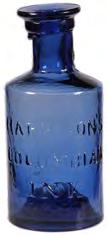



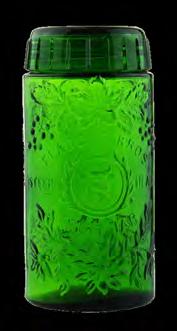
Saturday - April 1, 2023, 8:00 am to 3:00 pm

Early Bird: Friday - March 31 (1:00-6:00 pm) Fee $20
Turkey Creek Auctions Building
15323 NW Gainesville Rd., Reddick, Fla. 32686 (Not far from I-75 & 441)
FREE Admission! FREE Appraisals
Dealers - $40 Per Table If it fits on a table bring it!
Stoneware, Jars, Medicines, Milk Bottles, Insulators, Advertising, Jugs, Flasks, Soda Water, Soft Drinks, Bitters, Table-Top Antiques, Beers & Ales, Coca-Cola, Foods & Sauces, Colognes, Inks and so much more!






CONTACT: OR
Ronnie McCormick, 352.262.8672, oldflabottles@gmail.com
Louise O’Quinn, 386.943.2766, edlouise210@gmail.com
FOHBC Member. Please check your mailing address information and notify us of any corrections. FOHBC.org

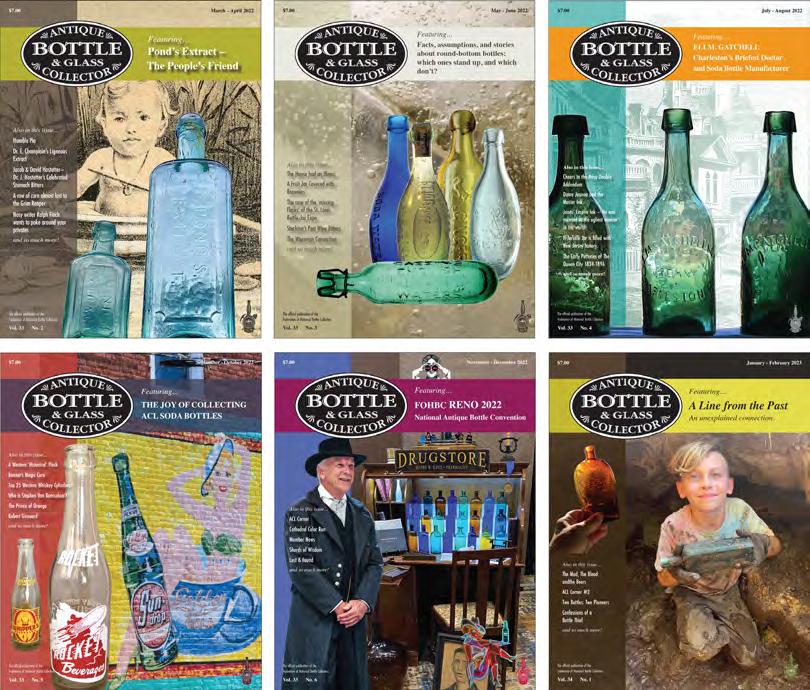

Don’t miss one issue of the new AB&GC. Keep your FOHBC membership up to date!
 FOHBC c/o Elizabeth Meyer, FOHBC Business Manager P.O. Box 1825 Brookshire, Texas 77423
FOHBC c/o Elizabeth Meyer, FOHBC Business Manager P.O. Box 1825 Brookshire, Texas 77423




























 Michael Seeliger
Michael Seeliger

 Brian Bingham
Brian Bingham





 Chris Hartz Los Alamos, California
Chris Hartz Los Alamos, California







































 & Glass Collector
& Glass Collector






































 By Jack Sullivan
By Jack Sullivan

























































































































































 FOHBC c/o Elizabeth Meyer, FOHBC Business Manager P.O. Box 1825 Brookshire, Texas 77423
FOHBC c/o Elizabeth Meyer, FOHBC Business Manager P.O. Box 1825 Brookshire, Texas 77423
